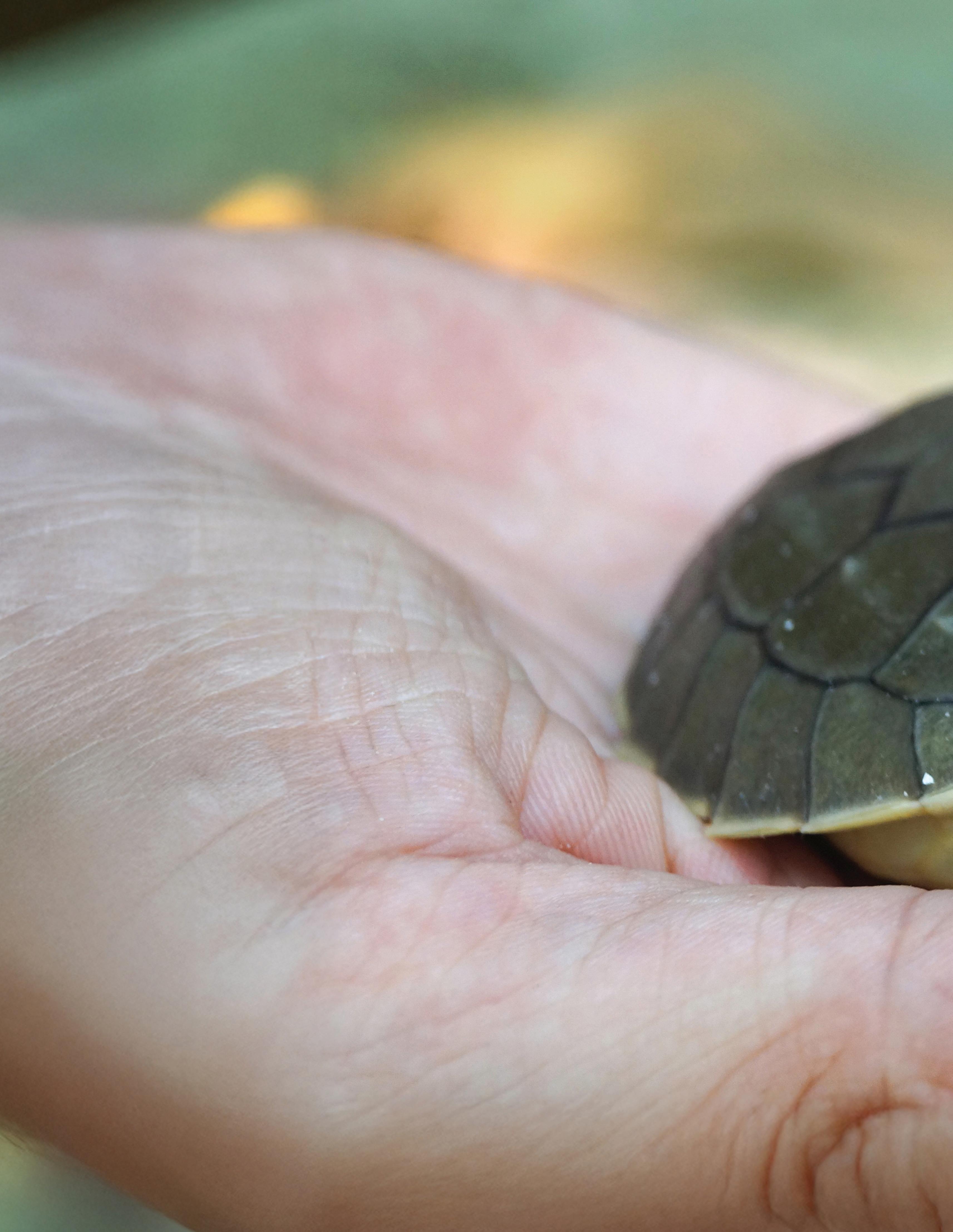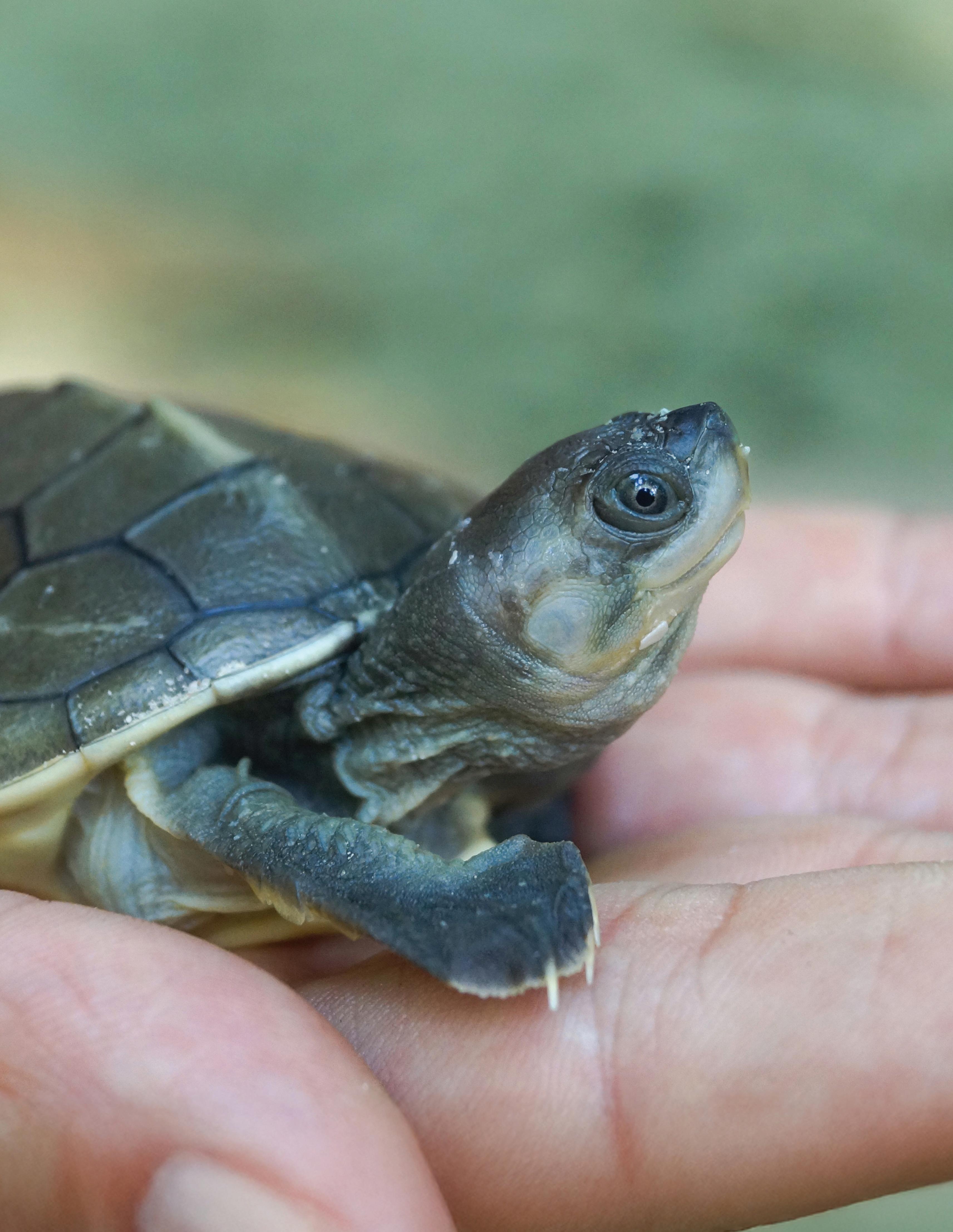

2024 IMPACT REPORT
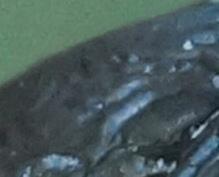
We are devoted, curious, passionate people leading the charge to prevent turtle extinctions worldwide.
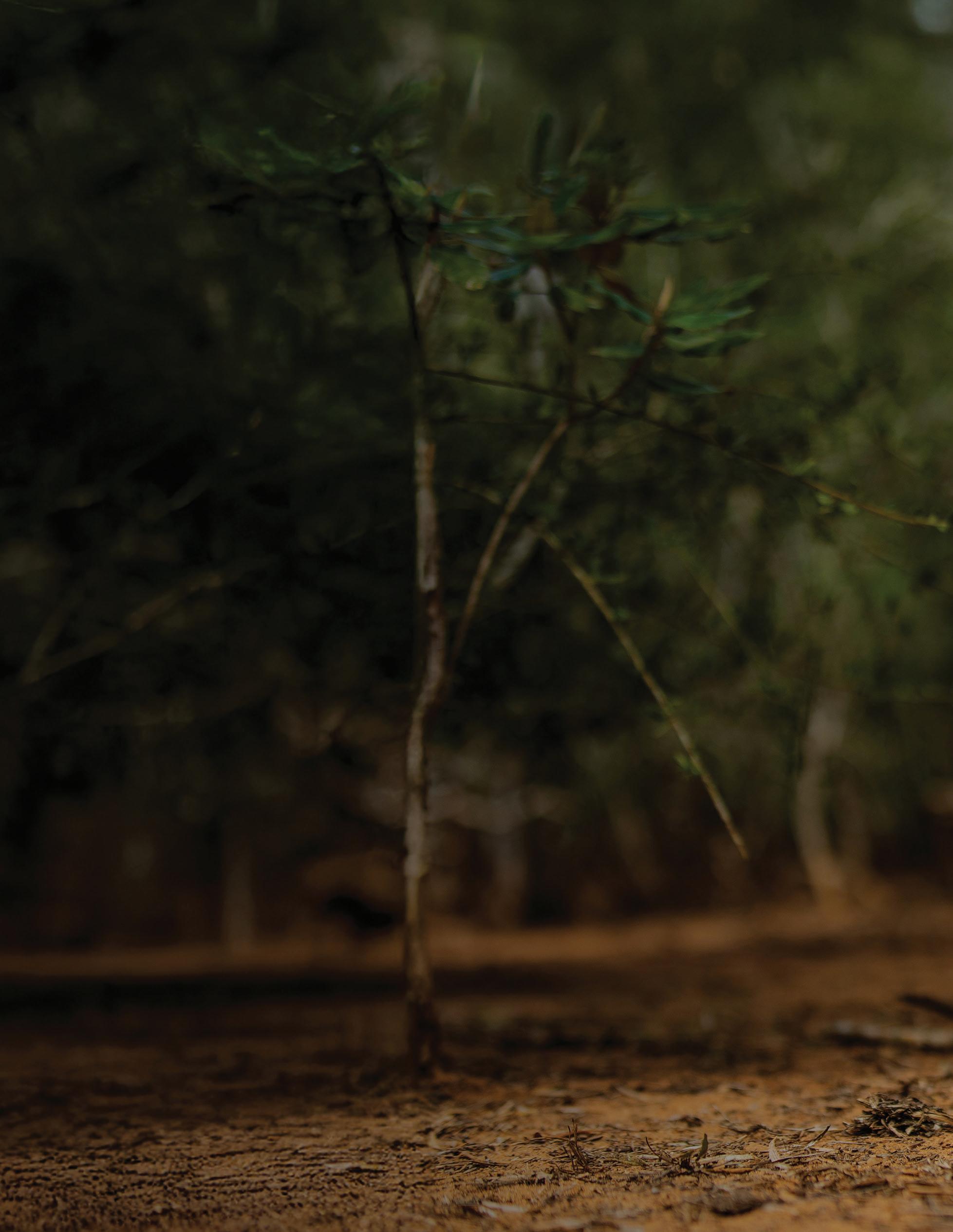
Our Mission
To protect and restore wild populations of turtles through science-based conservation, global leadership, and local stewardship.
Our Vision
A planet where turtles thrive in the wild, and are respected and protected by all humans.
Our Values
We are committed to zero turtle extinctions, community empowerment, and excellence through innovation, guided by our core values of passion, optimism, respect, and stewardship.
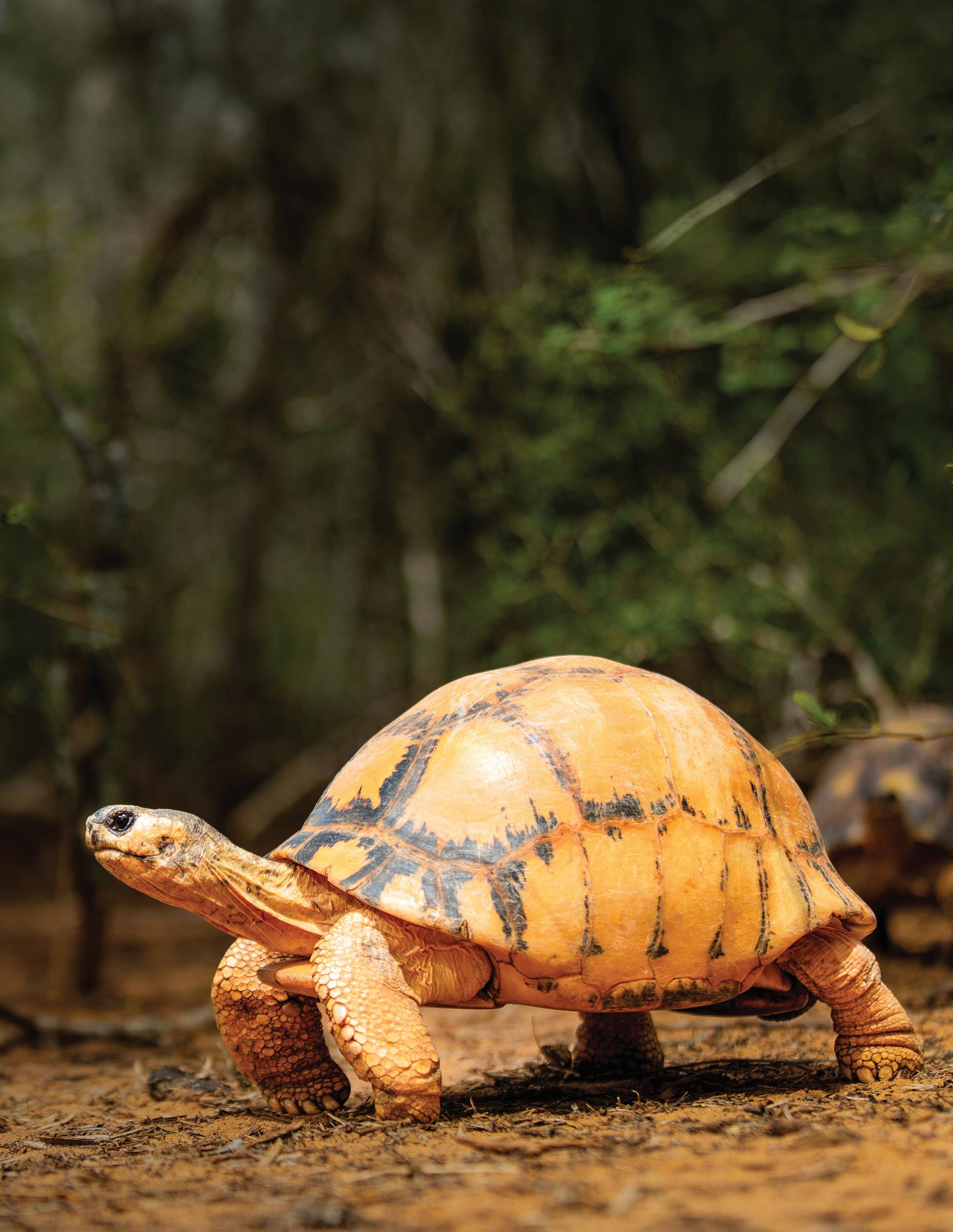
Ghost, a female Radiated Tortoise (Astrochelys radiata) rescued from wildlife trafficking, has been under Turtle Survival Alliance’s care for several years and lives at our Tortoise Conservation Center in southern Madagascar. Her unique coloration is a natural result of aging, as she has lost the striated pattern that gives the species its name. Estimated to be over 75 years old, Ghost holds the distinction of being the oldest tortoise in our care in Madagascar.
Photo by Andry Fandresena
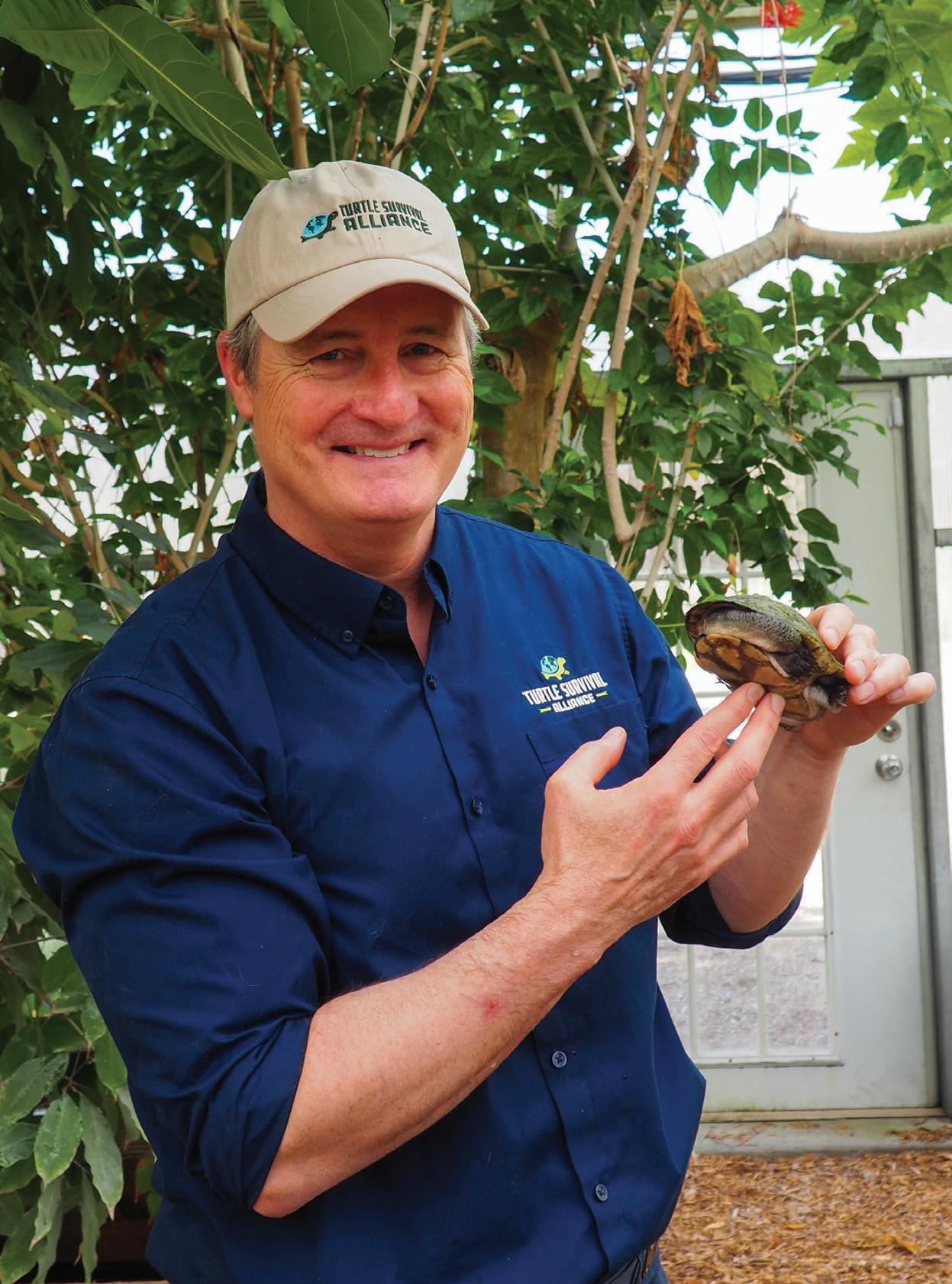
Dear Friends and Supporters of the Turtle Survival Alliance,
As I reflect on the past year and prepare to share our 2024 Impact Report, I am filled with a profound sense of gratitude and excitement.
This past year marked my first full year as CEO, a period characterized by significant growth, learning, and development—much of which was my own. I extend my deepest thanks to our dedicated board and exceptionally talented staff for their unwavering patience, support, and invaluable teachings. You have truly made this journey a remarkable one.
Looking back, I am proud of the foundational work we have accomplished. We have undertaken crucial restructuring within our Finance department, enhancing transparency, budgeting, and reporting to ensure the responsible stewardship of your generous contributions. Similarly, we have strengthened our Human Resources department to
Marc Dupuis-Desormeaux holds a Rote Island Snake-necked Turtle (Chelodina mccordi) at the Turtle Survival Center.
Photo by Elena Duran
better support and empower our dedicated staff, the heart of our organization.
These internal enhancements, while often unseen, are essential for our future success. They have laid the groundwork for the implementation of our new five-year Strategic Plan, a roadmap that will guide us as we embark on a period of significant growth.
As we look ahead to 2025, following our milestone 20th anniversary as an independent nonprofit in 2024, we are poised to expand our global impact. We will be actively pursuing new and strengthened collaborations, working alongside like-minded organizations to amplify our conservation efforts. By joining forces, we can achieve far more than we could alone.
Furthermore, we’re thrilled to announce the initial stages of reimagining and expanding our Turtle Survival Center, envisioning a world-class hub for turtle care, research, and conservation education.
None of this progress would be possible without the support of our generous donors. We extend our heartfelt gratitude to our private donors, foundations, zoos and aquariums, and the U.S. Fish and Wildlife Service.
This year’s Impact Report highlights the progress we’ve made and the momentum we’ve built. It is a testament to the dedication of our staff and the passion of our supporters. I hope you enjoy reading it.
Thank you for being an integral part of the Turtle Survival Alliance family. Your continued support is essential as we prepare for a year of impactful growth and make strides towards a future where all turtle species thrive.
With sincere appreciation,

Marc Dupuis-Desormeaux President & CEO
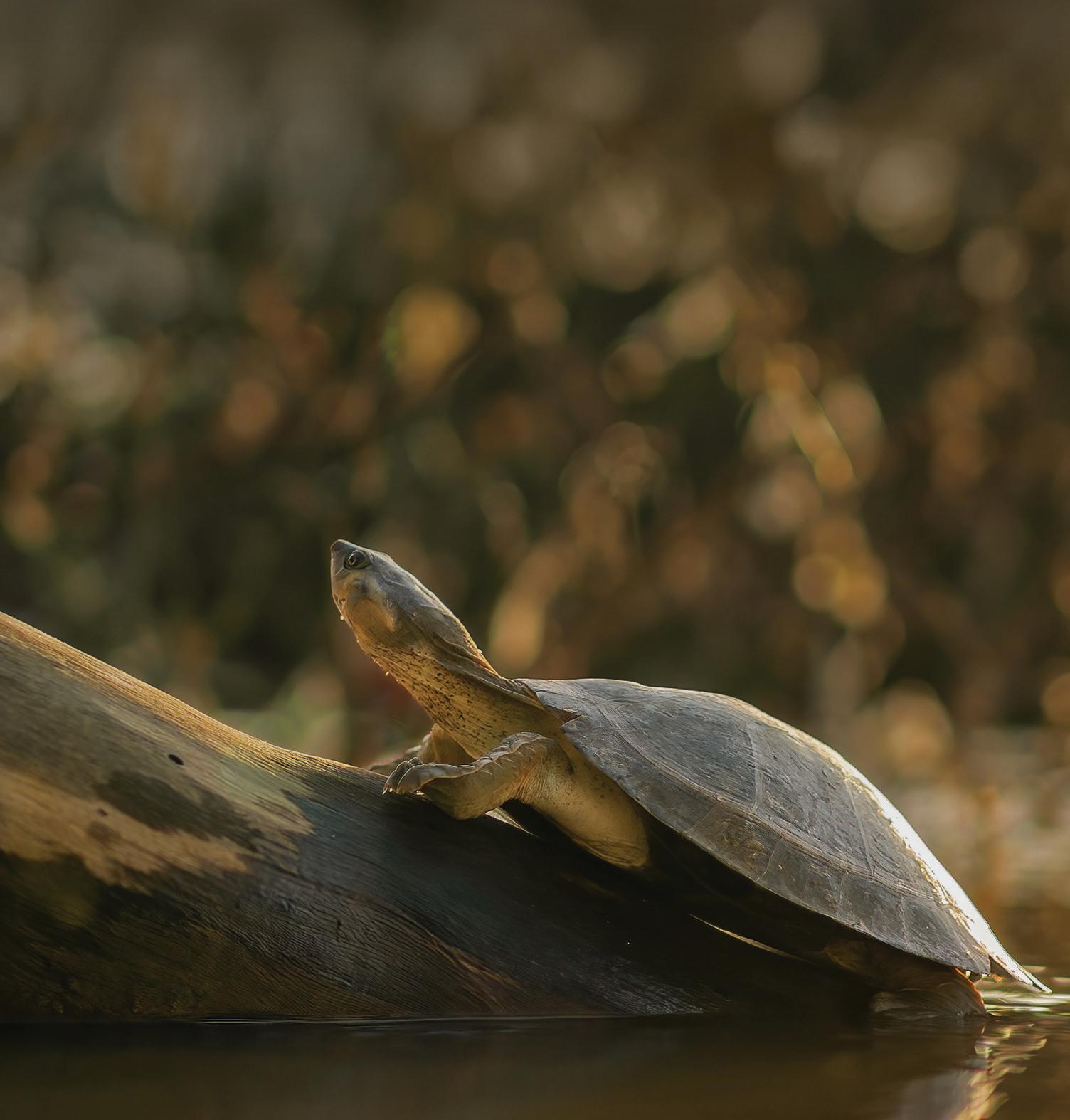
Magdalena River Turtle (Podocnemis lewyana) Photo by Jhonattan Vanegas
For the Turtles, For the Future
Turtles are at the heart of our organization’s mission and the reason for our existence. Now, more than ever, they need our help facing mounting pressures from habitat destruction, illegal wildlife trade, and climate change. More than half of the 360 species of turtles living on Earth today—including all tortoises, terrapins, sea turtles, and freshwater turtles— are threatened with extinction. Through our collaborative efforts, we strive to create a better world for the turtles, for their future.
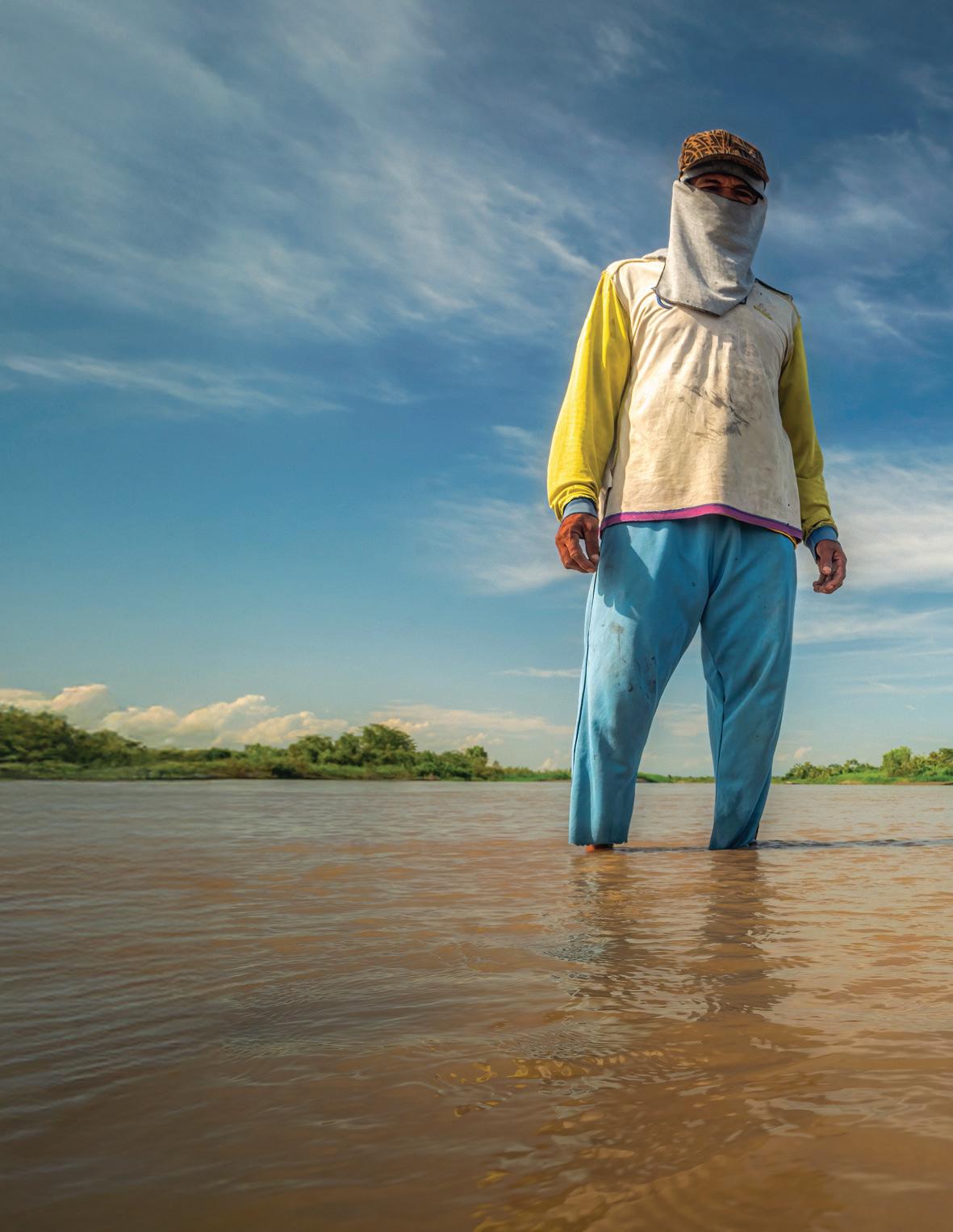
A fisherman carefully releases an adult female Magdalena River Turtle (Podocnemis lewyana) back into Colombia’s Magdalena River after she was accidentally caught in his fishing net. In this section of the river, where our collaborative partnership leads an ongoing conservation project, creating community awareness is essential to protecting this critically endangered species and ensuring its survival in the wild.
Photo by Jhonattan Vanegas
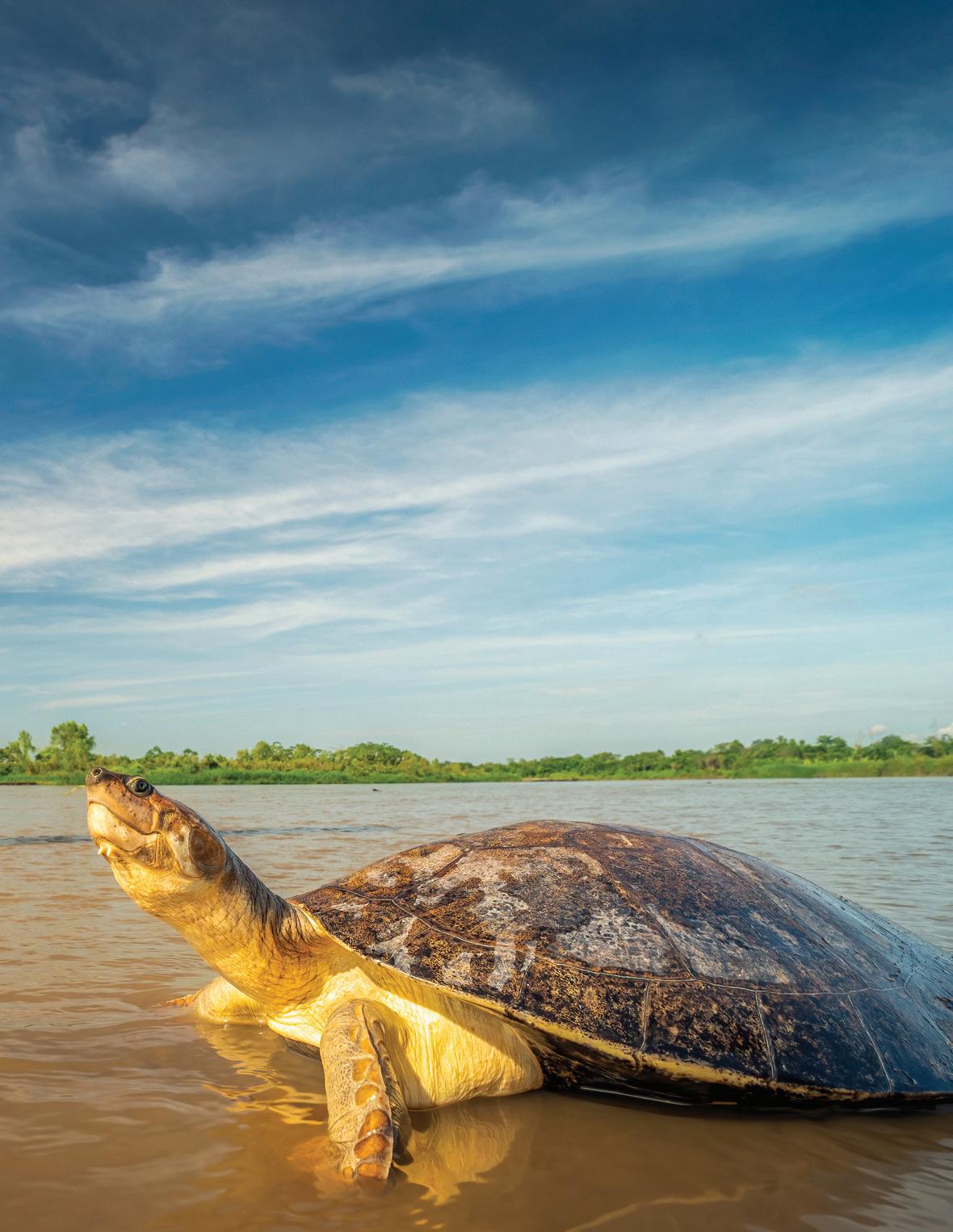
Turtle Survival Alliance: By the Numbers
The data presented reflects January 1, 2024 to December 31, 2024.
116
Species and subspecies worked with 19
Countries with Turtle Survival Alliance presence
7,825
Total hatchlings produced (nest protection, translocation, & conservation breeding)
3,600
Hatchlings produced through conservation breeding
• 31 total species producing hatchlings
• 22 Critically Endangered species producing hatchlings
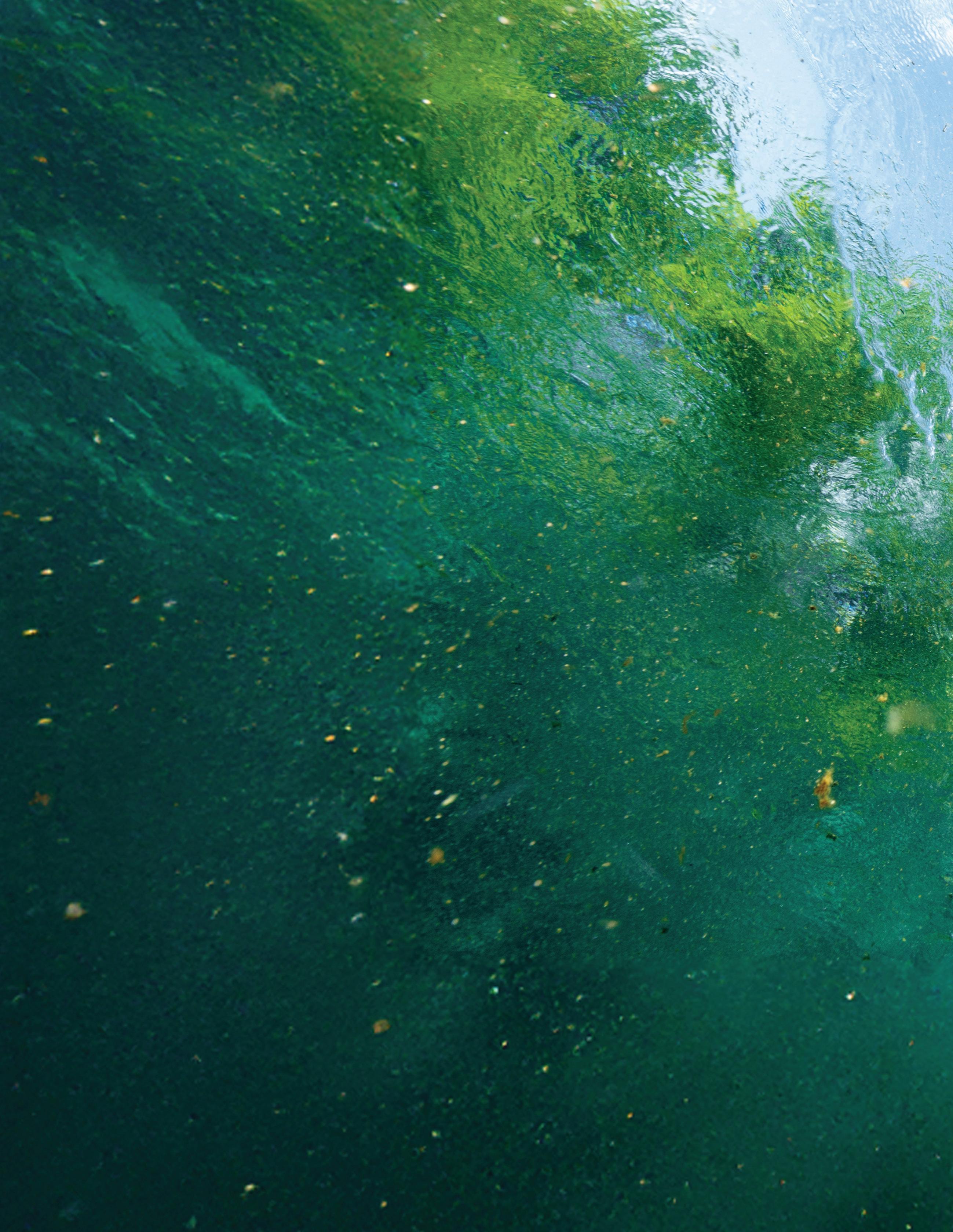
5,911
Turtles released into the wild
653
Volunteers & interns engaged
1,135
Community members employed
263
Attendees to the 22nd Annual Symposium on the Conservation and Biology of Tortoises and Freshwater Turtles
750+
Education and outreach offerings held around the world
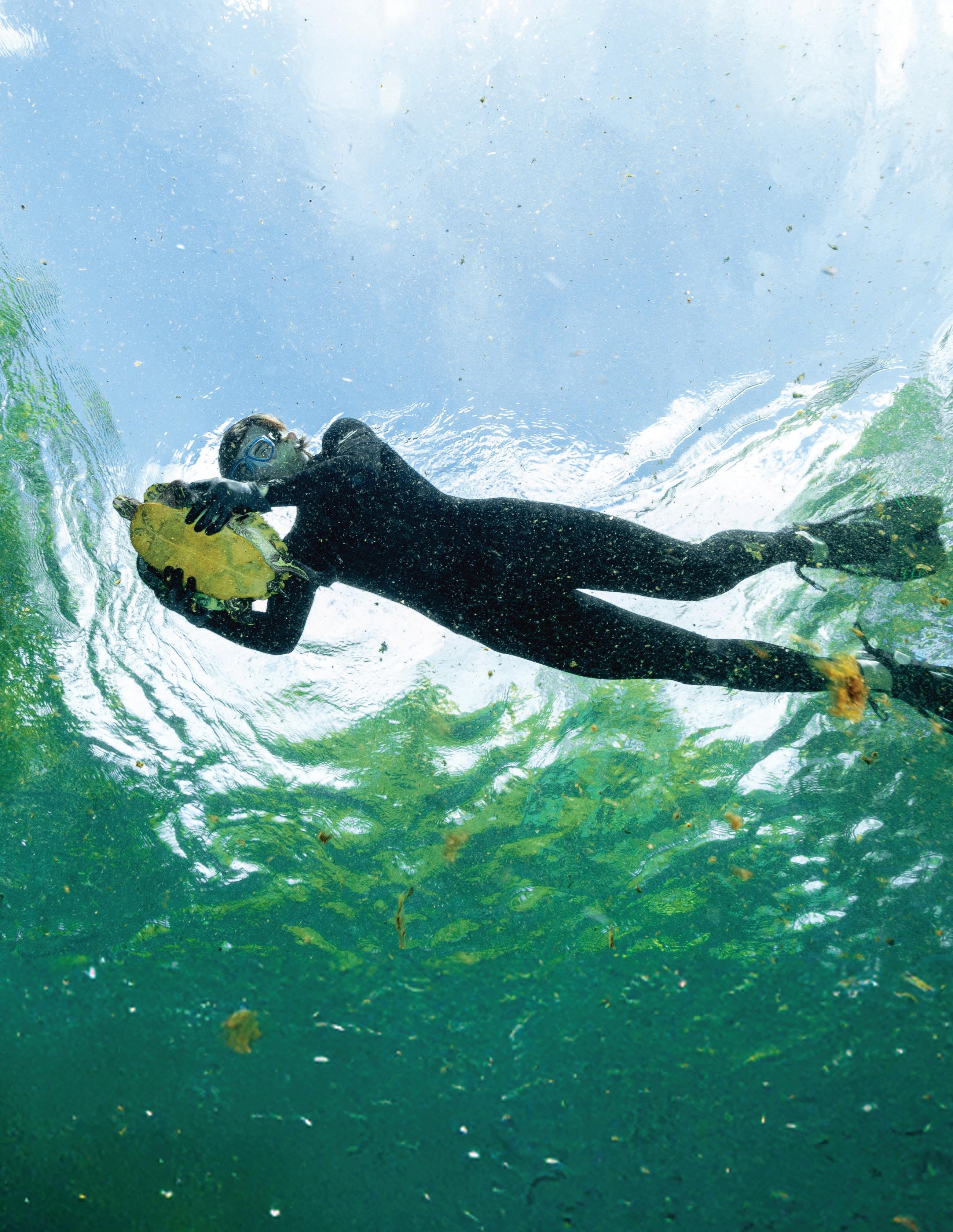
A Suwannee Cooter (Pseudemys concinna suwanniensis) is captured in Ichetucknee Springs State Park as part of a long-term population monitoring program.
Photo by Bill Hawthorne
Current Project Locations
• Argentina
• Bangladesh
• Belize
• Brazil
• Cambodia
• Colombia
• Egypt
• Guatemala
• India
• Indonesia
• Kenya
• Madagascar
• Malaysia
• Mexico
• Myanmar
• South Sudan
• Uganda
• United States
• Vietnam
Target Project Locations
• Australia
• Benin
• Bolivia
• Burkina Faso
• Canada
• China
• Costa Rica
• Côte d’Ivoire
• El Salvador
• Ghana
• Mali
• Niger
• Nigeria
• Panama
• Paraguay
• Peru
• Philippines
• South Africa
• Thailand
• Togo
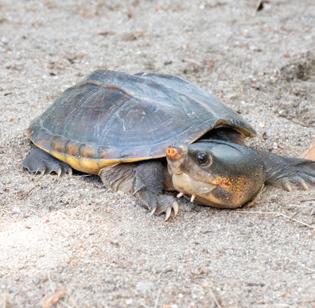
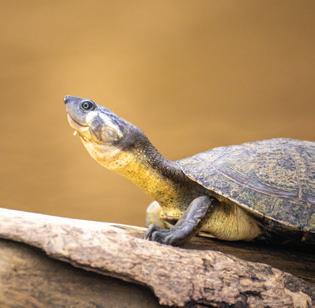
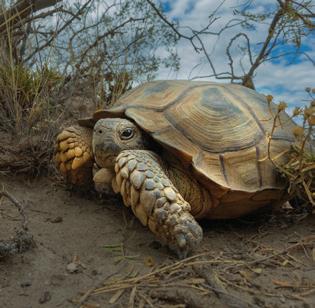
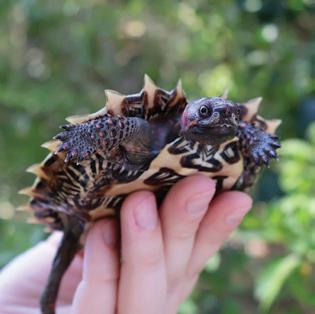
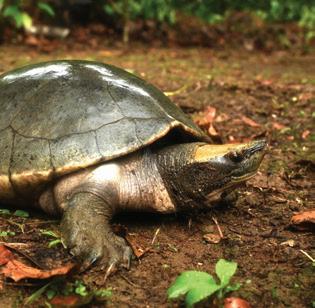
MEXICO
Pacific Coast Musk Turtle (Staurotypus salvinii)
See p. 34
COLOMBIA
Magdalena River Turtle (Podocnemis lewyana)
See pp. 25; 31
ARGENTINA
Chaco Tortoise (Chelonoidis chilensis)
See p. 38
BELIZE
Central American River Turtle (Dermatemys mawii)
See pp. 15; 23; 40
USA, TURTLE SURVIVAL CENTER
Spiny Turtle (Heosemys spinosa)
See pp. 18-19
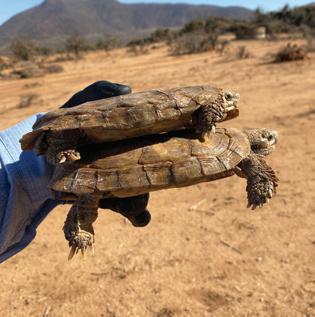
(
Pancake
See p. 32

See
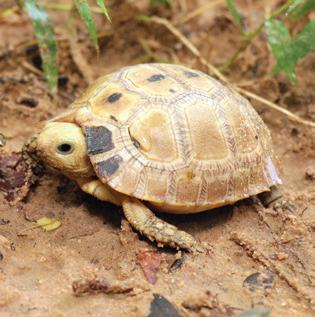
Elongated Tortoise (Indotestudo
See pp. 16; 24
)
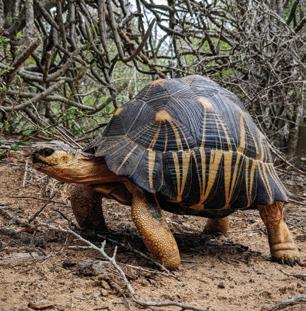
(
See p. 26
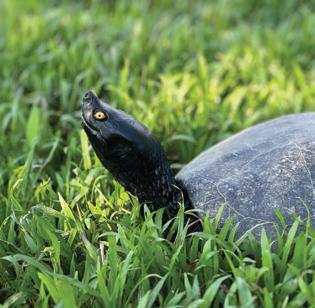
See
KENYA
Tortoise
Malacochersus tornieri)
BANGLADESH
Asian Giant Tortoise (Manouria emys phayrei)
pp. 14; 22; 30
MALAYSIA
Southern River Terrapin (Batagur affinis)
pp. 27; 33; 41
CAMBODIA
elongata
MADAGASCAR
Radiated Tortoise
Astrochelys radiata)
Photo credits: Mexico: Eduardo Reyes Grajales; Belize: Parker Gibbons; Colombia: Daniël Nelson; Argentina: Darío Podestá; USA: Chelsea Rinn; Kenya: Marc Dupuis-Desormeaux; Madagascar: Lance Paden; Bangladesh: Kowshik Azad; Cambodia: ACCB/Maria Blümm Rexach; Malaysia: Pelf-Nyok Chen
Our Strategic Plan
Securing a Brighter Future for Turtles
In November 2024, we unveiled our ambitious five-year road map, a strategic guide to achieving our long-term conservation goals. At its core, we have prioritized more than 150 species, selected based on their level of endangerment, our deep understanding of their conservation needs, and the resources available to support them.
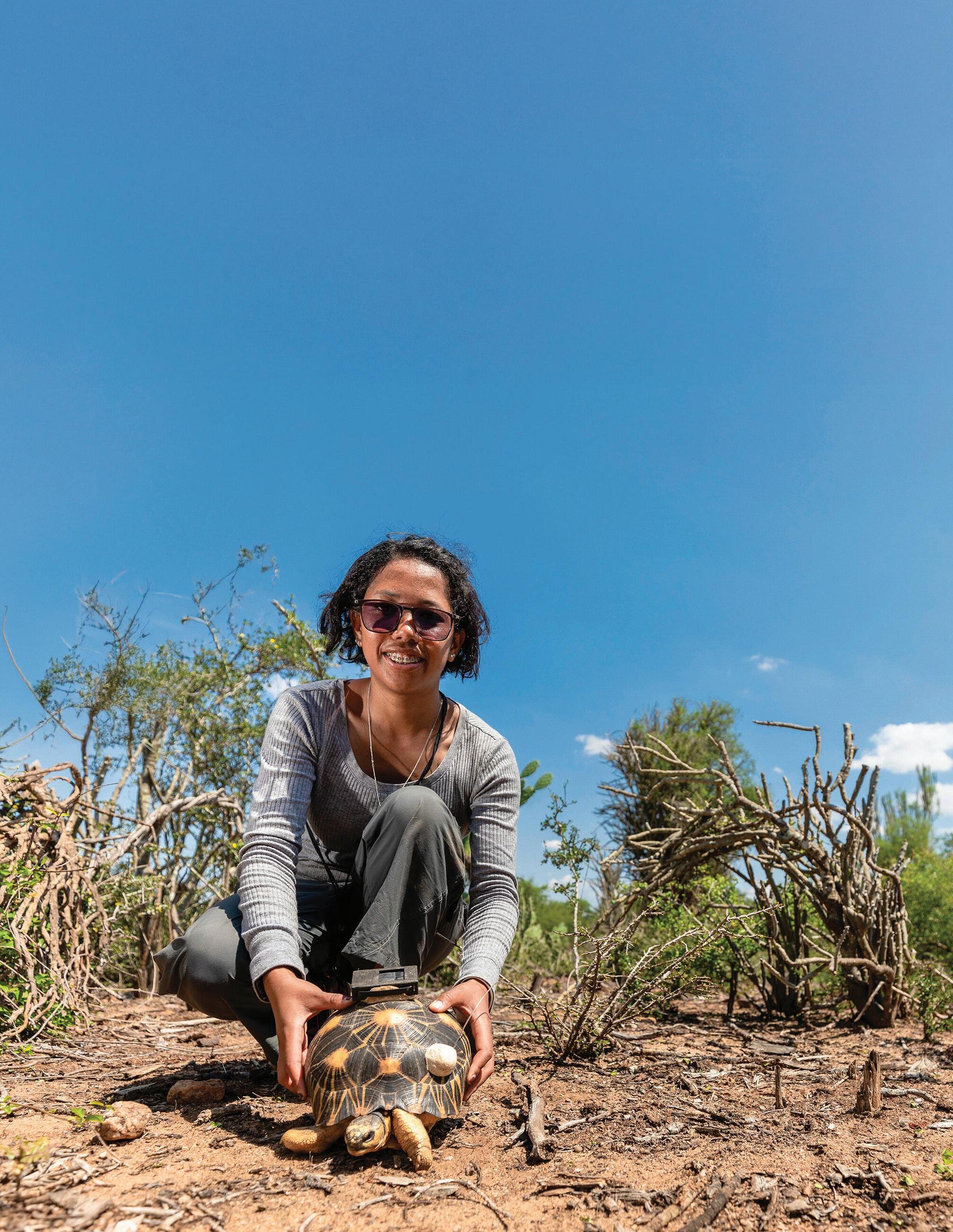
This plan is built on three foundational pillars: Species Protection, Community Engagement, and Best-in-Class Practices. For over two decades, these principles have shaped our conservation efforts, and now, they propel us forward as we confront the urgent threats facing turtles worldwide.
K’oloina Ramahandrizafy, Lead Keeper of the Tortoise Conservation Center in Tsihombe, Madagascar, with a rewilded Radiated Tortoise (Astrochelys radiata) equipped with GPS and radio units. Photo by Andry Fandresena

Species Protection
Ensure the persistence of wild turtle populations.
Community Engagement
Develop and strengthen missiondriven relationships.
Best in Class
Be the gold standard for impactful chelonian conservation.
Conservation breeding is a key pillar of several Turtle Survival Alliance projects around the world. At our Turtle Survival Center in South Carolina, USA, we use this approach to preserve species and provide hope for their return to the wild. In August 2024, our efforts reached a major milestone with the hatching of our 100th Indochinese Box Turtle (Cuora galbinifrons).
Photo by Chelsea Rinn
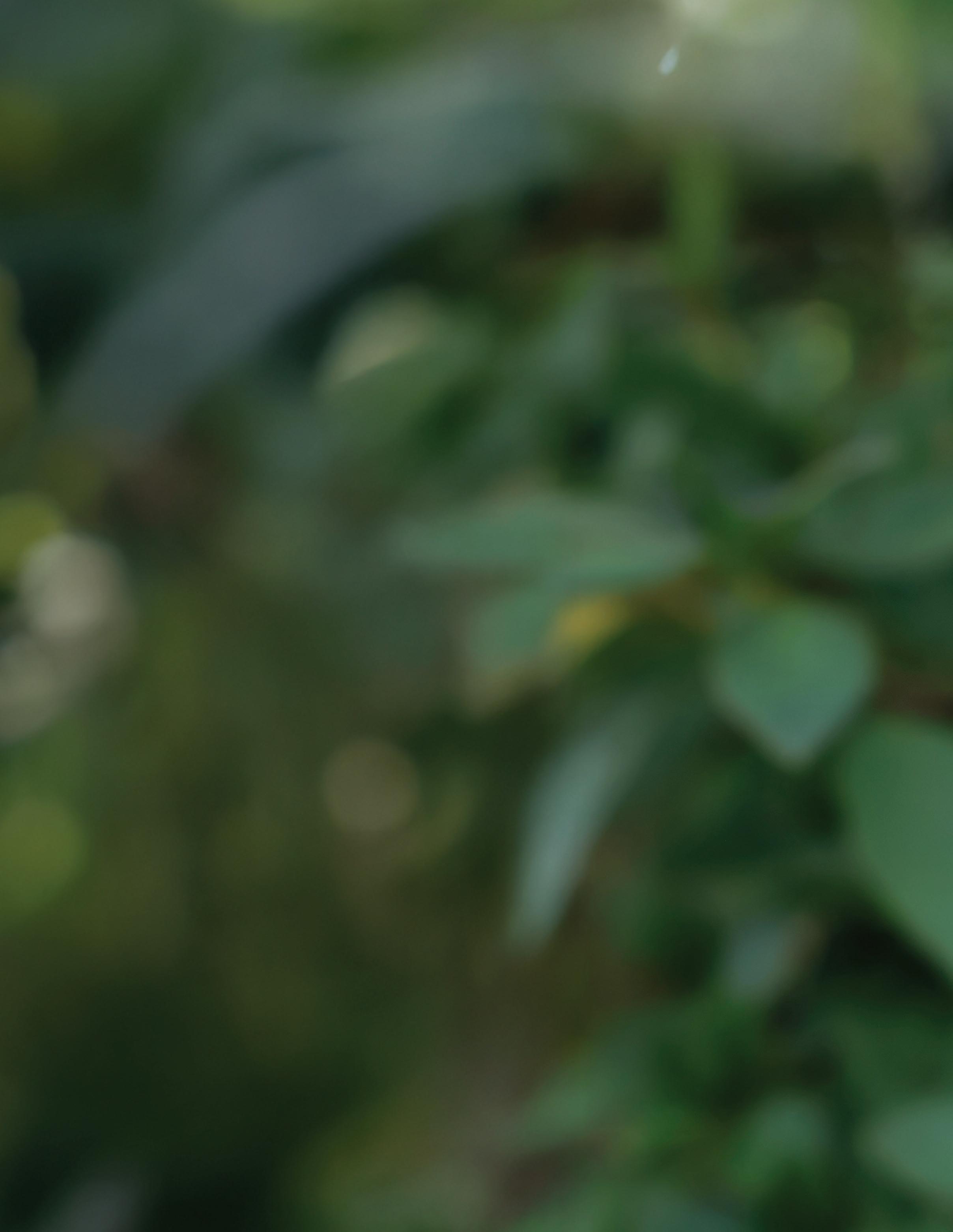
Conservation Breeding
Assurance Colonies | Population Management | Genetic Diversity
Turtle Survival Alliance prioritizes the management of critically endangered species under human care to safeguard them from extinction. We carefully maintain sustainable populations, creating a vital genetic reservoir for species threatened by habitat destruction, overcollection, climate change, and other human-driven pressures. Beyond preservation, we use conservation breeding to strengthen wild populations and support future reintroductions—giving endangered species the best chance to thrive once again in their natural ecosystems.
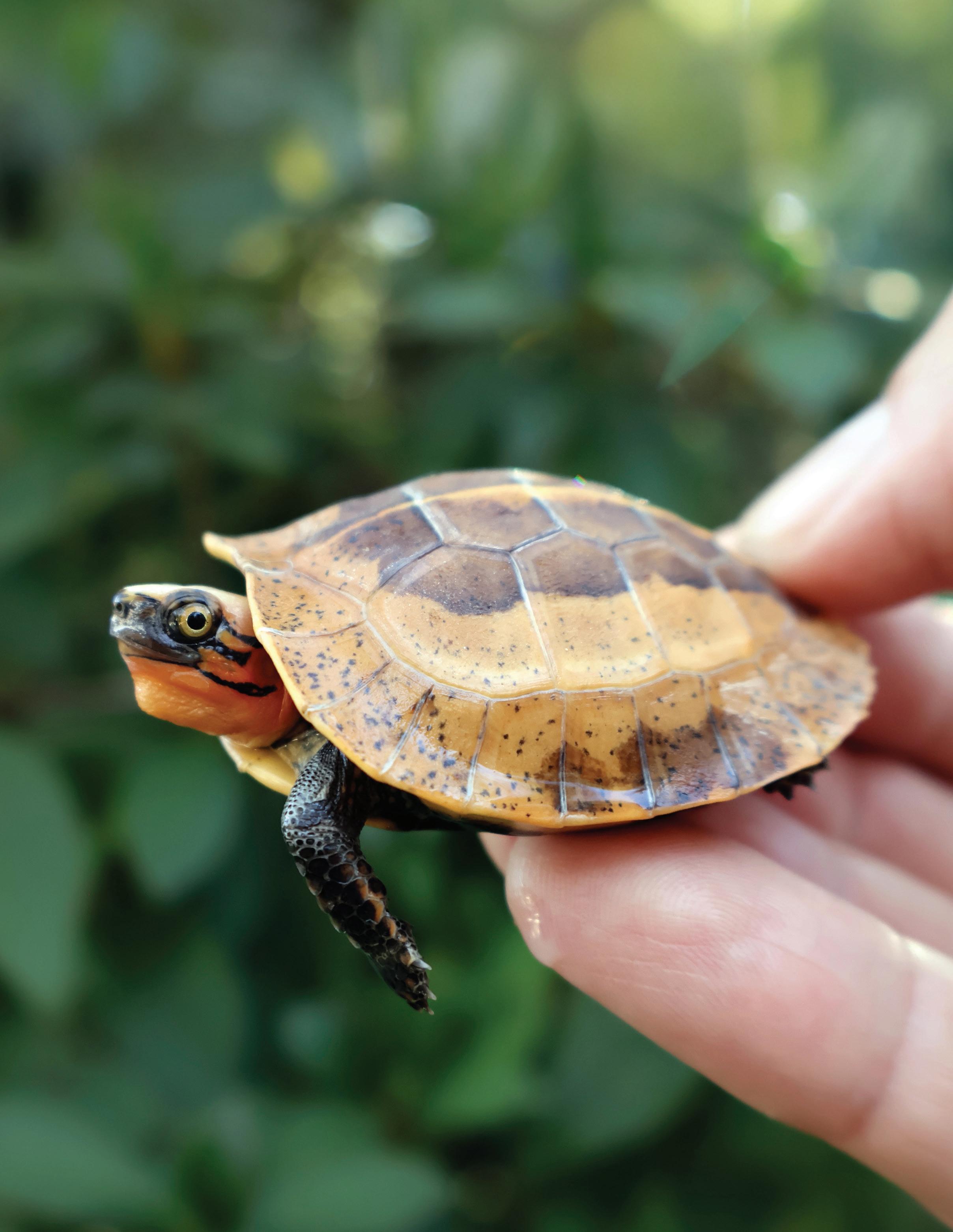
Bangladesh
Our collaboration with the Creative Conservation Alliance (CCA) remained highly productive in 2024. This year, successful breeding efforts led to the hatching of 42 Asian Giant Tortoises (Manouria emys phayrei) and five Elongated Tortoises (Indotestudo elongata) at the Turtle Conservation Center in Bhawal National Park, as well as 26 Black Softshell Turtles (Nilssonia nigricans) at the Shrine of Bayzid Bostami in Chattogram. A significant milestone was reached when, after seven years of care, three female Arakan Forest Turtles (Heosemys depressa) laid eight eggs—an important step for this critically endangered species, once unknown from Bangladesh. These hatchlings, many born to turtles confiscated from villagers and the illegal trade, underscore the success of ongoing conservation efforts in South Asia’s most densely populated country.
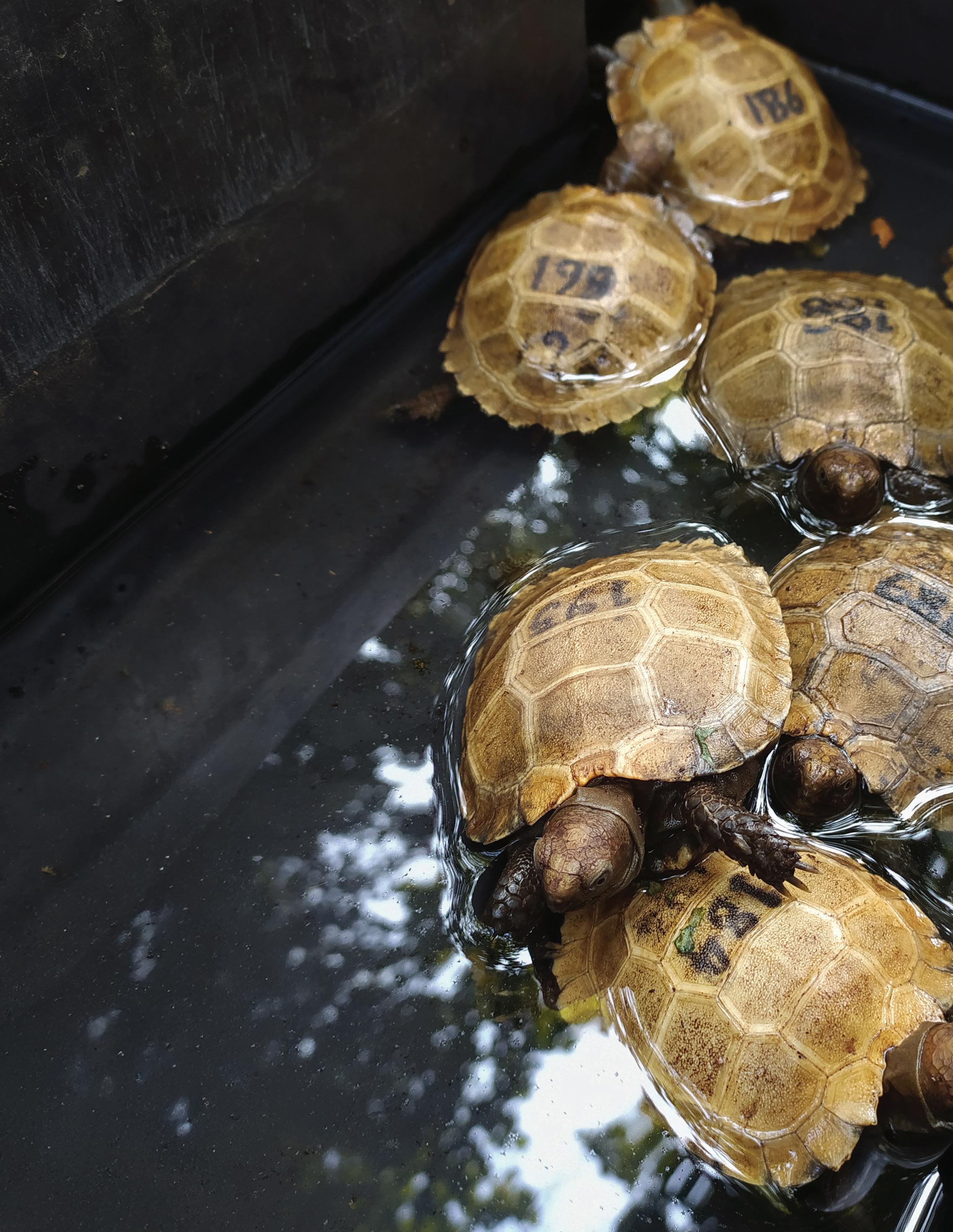
"Conservation breeding is our last hope to return these species to Bangladesh’s wilds."
FAHIM ZAMAN, HEAD OF OPERATIONS AND LOGISTICS, CREATIVE CONSERVATION ALLIANCE
of the
Several
42 Asian Giant Tortoise (Manouria emys phayrei) hatchlings produced at the Turtle Conservation Center in Bangladesh in 2024 receive a hydrating soak. Photo by Moktadir Shobuj
Asian Giant Tortoises hatched
Elongated Tortoises hatched
Black Softshell Turtles hatched
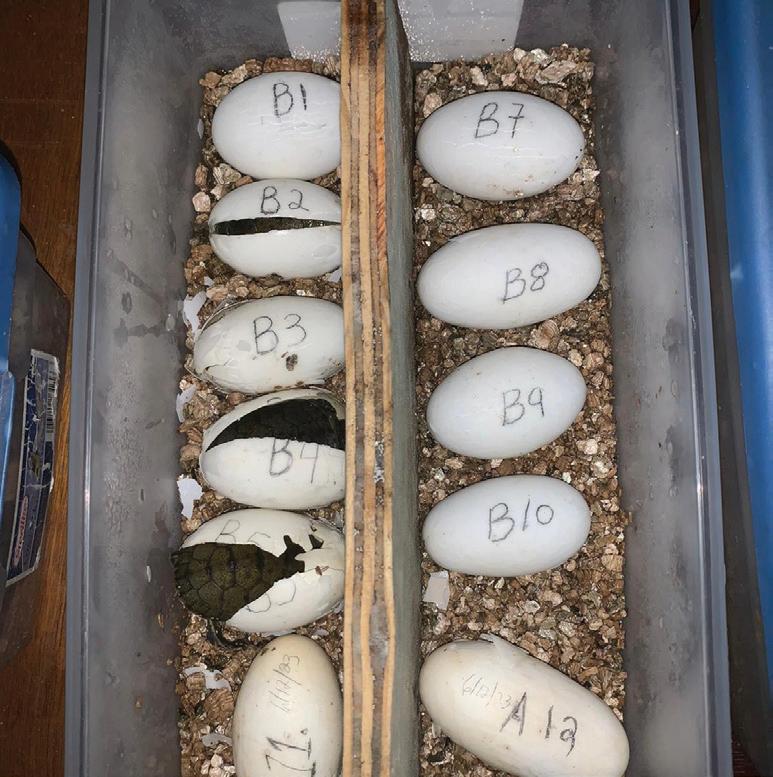
Belize
In 2014, Turtle Survival Alliance and the Belize Foundation for Research and Environmental Education (BFREE) established the Hicatee Conservation and Research Center (HCRC) on BFREE’s 1,153-acre biological field station and reserve in the foothills of the Maya Mountains. Foundational to the HCRC is its captive breeding program for the Central American River Turtle (Dermatemys mawii). The center maintains 45 breeding adults in large ponds, along with an incubation facility and grow-out ponds for juveniles. In 2024, the program achieved a record 319 hatchlings, strengthening efforts to rear Central American River Turtles for future reintroduction to the wild.
Top to bottom: Some of the record 319 Central American River Turtle (Dermatemys mawii) hatchlings produced at the Hicatee Conservation & Research Center (HCRC) in 2024 begin to hatch from their eggs; a hatchling Central American River Turtle produced at the HCRC. Photos by Heather Barrett
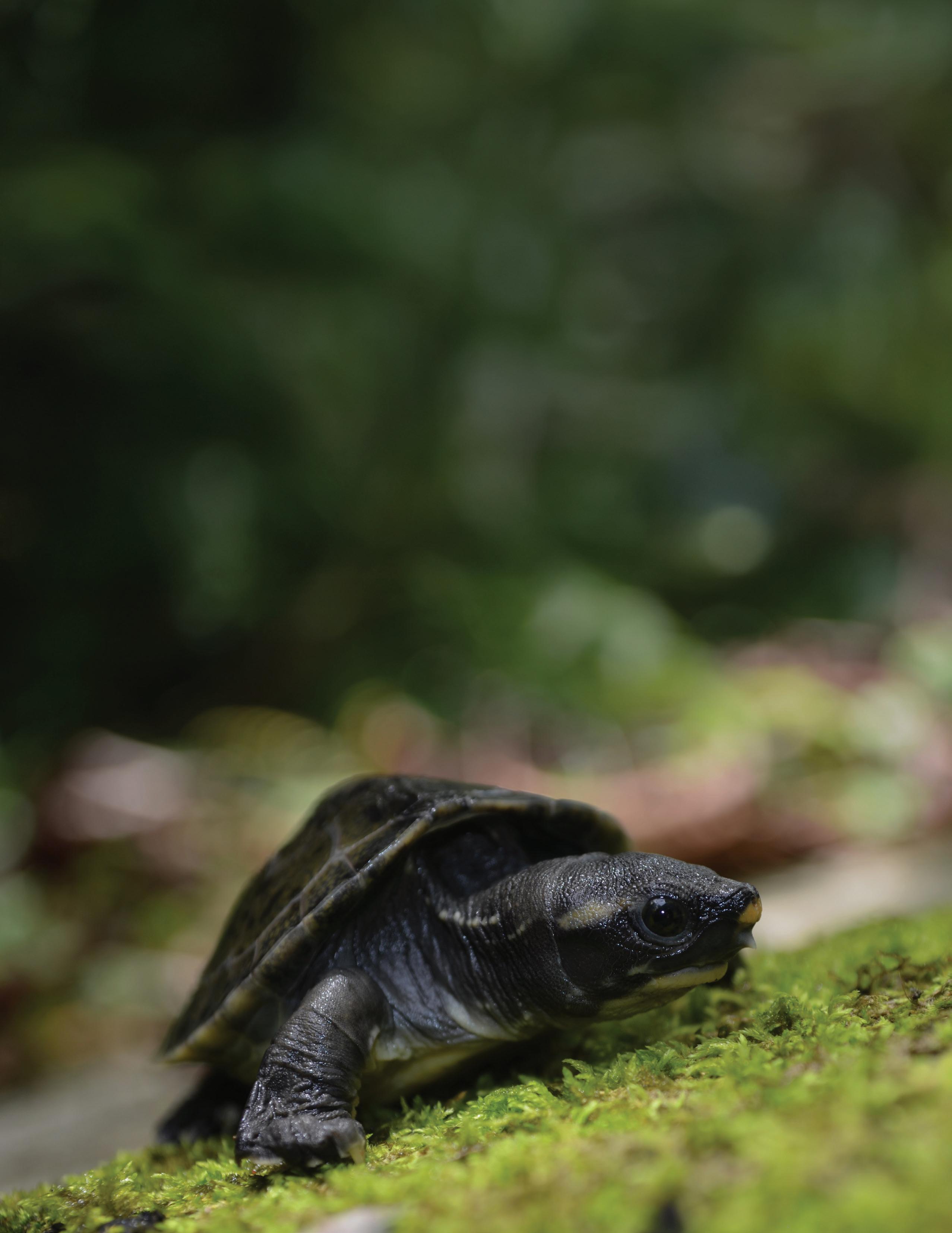
Central American River Turtles hatched—a program record
Belize Foundation for Research and Environmental Education
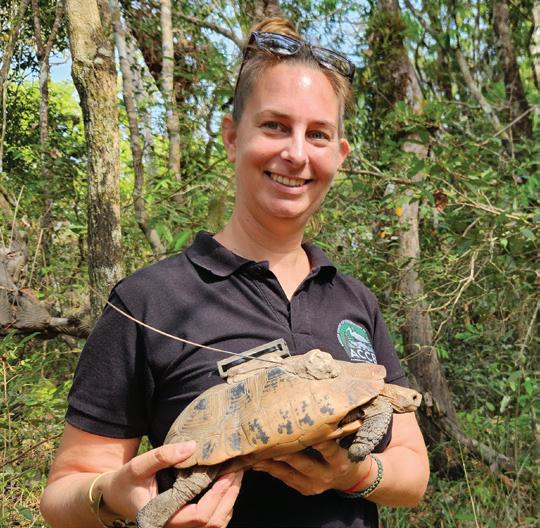
Christel Griffioen
Country
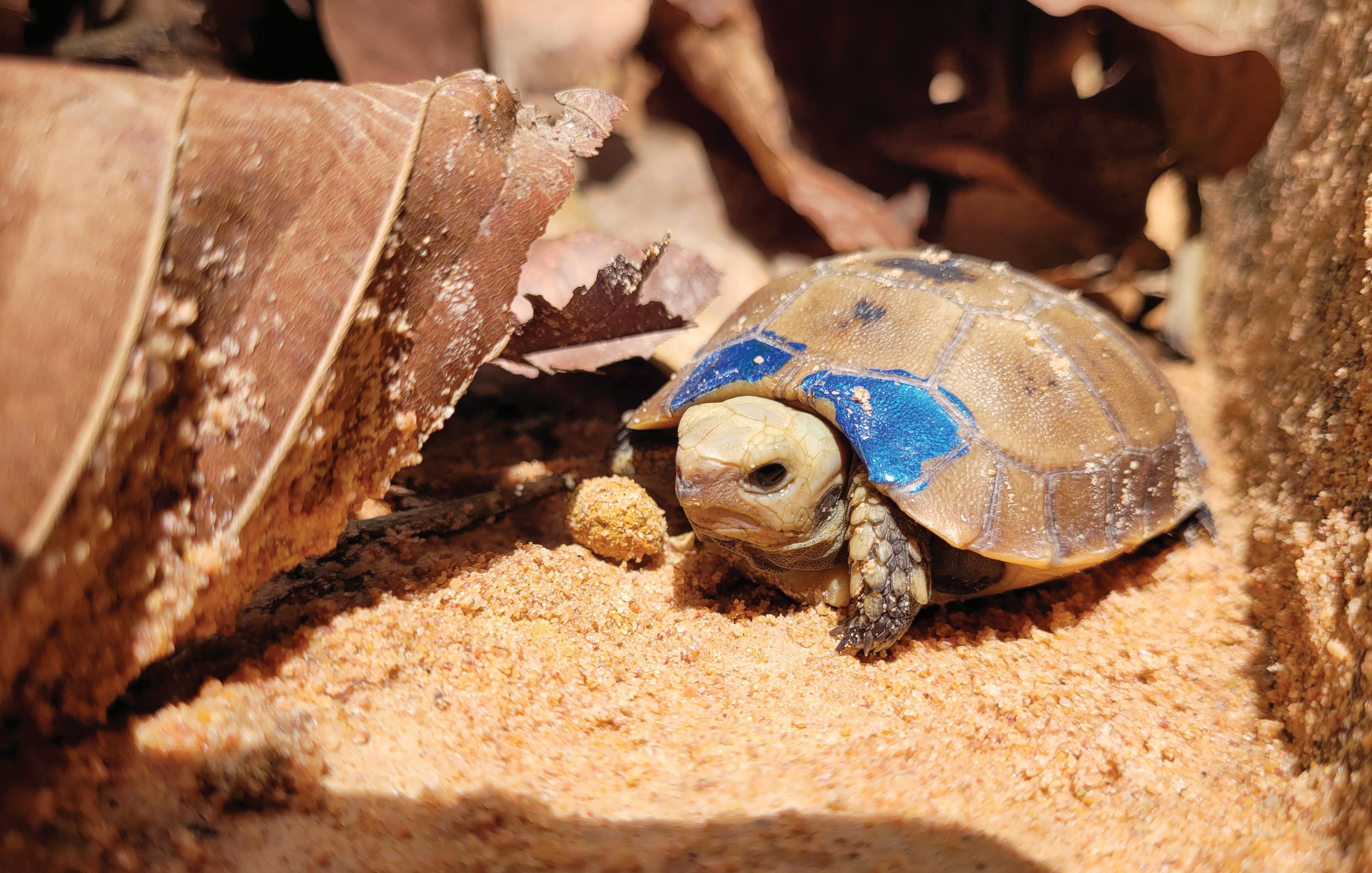
"Leading a dedicated and passionate team of conservation professionals has been an inspiring journey. Together, we've made remarkable progress in protecting Cambodia's chelonian species through ex situ conservation— successfully breeding, rescuing, and rehabilitating six Endangered and Critically Endangered species in 2024." –Christel Griffioen
10 2
Elongated Tortoises hatched—a program record
Southern River Terrapins hatched—a program record
new species successfully bred
A newly hatched Elongated Tortoise (Indotestudo elongata) at the Angkor Center for Conservation of Biodiversity. Non-toxic nail polish is used to differentiate the hatchlings. Photo by ACCB/Maria Blümm Rexach
Cambodia
Angkor Center for Conservation of Biodiversity
We support our partner, the Angkor Center for Conservation of Biodiversity (ACCB), in amplifying populations of critically endangered turtles in Cambodia. This year, ACCB hatched a record-breaking 169 Elongated Tortoises (Indotestudo elongata), the most ever produced at the center. Additionally, 2024 marked the successful breeding of two new species at ACCB—the Yellow-headed Temple Turtle (Heosemys annandalii) and Black Marsh Turtle (Siebenrockiella crassicollis). This was highlighted by
three Yellow-headed Temple Turtles laying eggs for the first time.
ACCB also partnered with Wildlife Conservation Society to identify environmental factors influencing Southern River Terrapin (Batagur affinis) reproduction at the center, resulting in ten hatchlings—the highest number there to date. Their research also revealed key factors affecting Elongated Tortoise survival rates, leading to improved husbandry practices that have stabilized the population, achieving a survivability rate of over 90%.
Photo by ACCB/Philipp Wagner
Director, Angkor Center for Conservation of Biodiversity
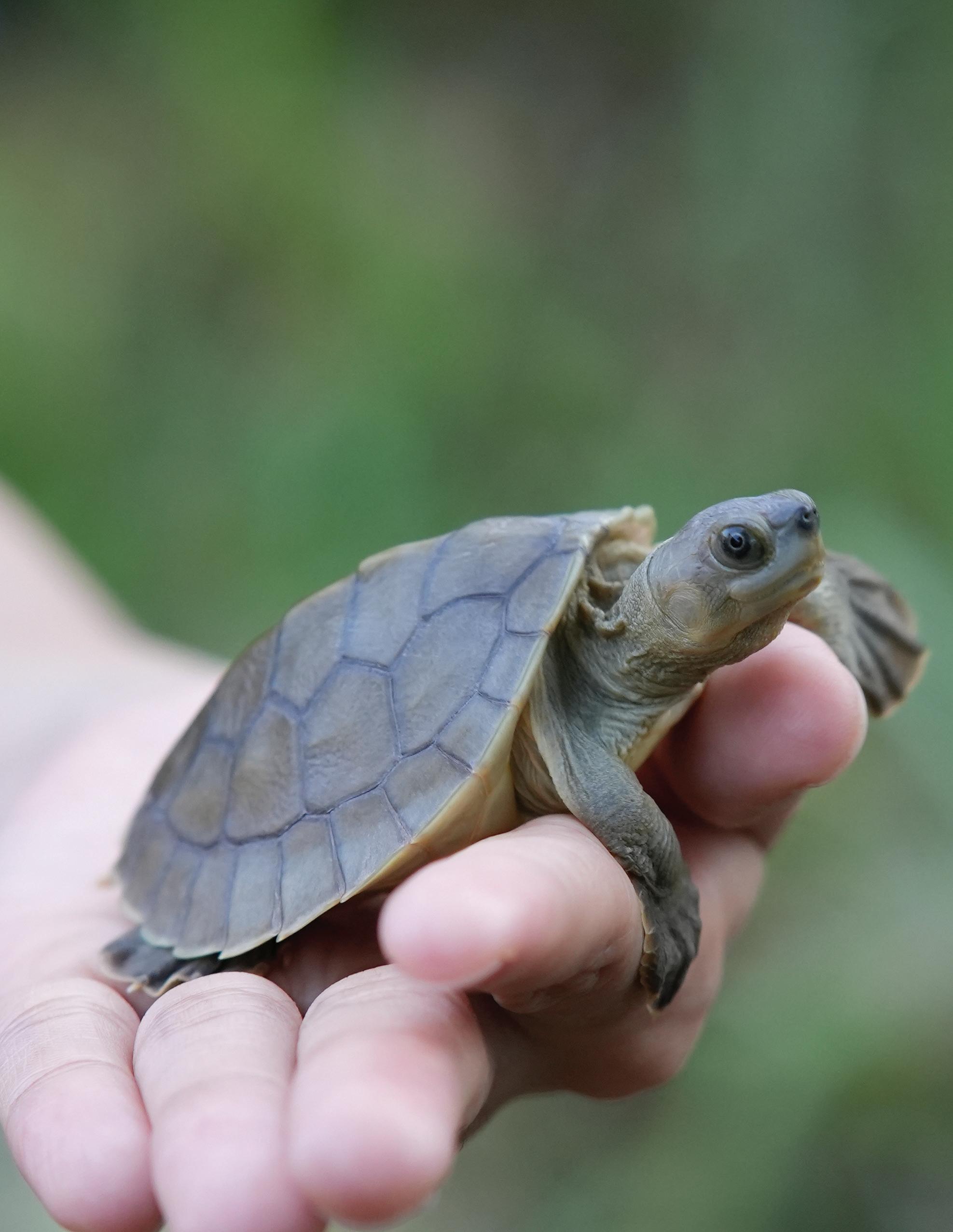
Cambodia
Koh Kong Reptile Conservation Center
In 2024, the Turtle Survival Alliance-supported conservation breeding program of Wildlife Conservation Society Cambodia produced 27 hatchling Southern River Terrapins (Batagur affinis) at the Koh Kong Reptile Conservation Center (KKRCC) in southwestern Cambodia. The first captive-reared females to reach adulthood, which began nesting in 2021, came from nests protected years ago along the Sre Ambel River through a project led by Wildlife Conservation Society Cambodia and the Royal Government of Cambodia Fisheries Administration. These turtles were raised at the KKRCC. Over the past four years, the project has successfully produced a total of 185 hatchlings. These hatchlings not only help safeguard the species from biological extinction in Cambodia but will also contribute to its recovery in the wild.
27
One of the 27 Southern River Terrapins (Batagur affinis) hatched from the conservation breeding program at the KKRCC in Cambodia in 2024. Photo by Phun Thorn Angkor Centre for Conservation of Biodiversity
Koh Kong Reptile Conservation Center
Southern River Terrapins hatched
Turtle Survival Center
A Linchpin for Species Assurance, Genetics, Health, and Rewilding Success
2024 was an exciting year for the Turtle Survival Center (TSC). As we continue expanding our capacity to grow assurance colonies for some of the world’s rarest turtles, we’re also working toward a broader vision. The TSC is evolving into a hub for conservation education and leadership, strengthening the scientific foundations of our work through our growing Genetics and Chelonian Health programs. Building on this progress, we’re exploring opportunities to return the offspring we
produce at the TSC to their native ranges abroad—linking our breeding success to the long-term recovery of species in the wild. In parallel, through close partnership with the AZA SAFE: American Turtle program, we’re helping to forge a path home for confiscated native turtle species within the United States.
The following fundamental conservation actions form the foundation for rewilding turtle species here at home and around the world.
The Yellow-headed Box Turtle (Cuora aurocapitata) of China is a priority species at the Turtle Survival Center. Classified as Critically Endangered, none have been recorded in the wild in over a decade. Since 2014, we have successfully hatched 23 individuals—each one representing a vital lifeline for a species feared extinct in its natural habitat. Photo by Arpita Dutta
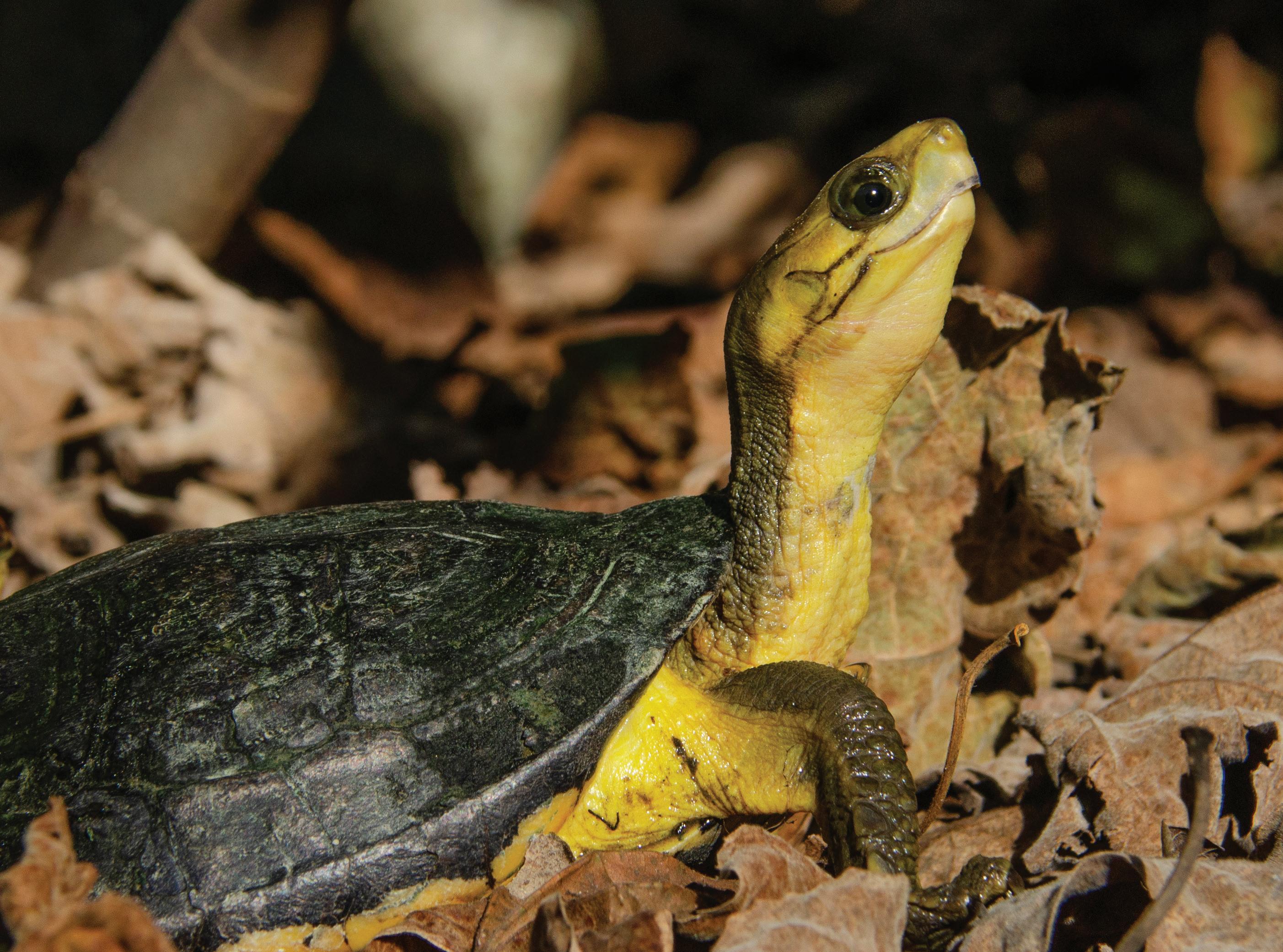
Conservation Breeding
At the core of the TSC’s mission is hatching critically endangered turtle species by carefully selecting breeding pairs in an attempt to maximize the genetic diversity across many generations. We have been doing this successfully for more than a decade. In 2024, a total of 83 baby turtles hatched from eggs produced by 14 species. Significant hatchings included our first Vietnamese Three-striped Box Turtles (Cuora cyclornata) and an unusual event: two nonconjoined Sulawesi Forest Turtles (Leucocephalon yuwonoi) hatching from a single egg (pictured).
Photo by Cris Hagen
Turtle Health
Maintaining the health of turtles in our care remains our highest priority. As we look toward a future where turtles return to the wild, our vision expands— and so do the stakes. To enhance reintroduction success, we are expanding pathogen research to include the health of turtles in our care, confiscated individuals, and those living in potential release sites. We use data from our international partnerships to assess wild baseline health parameters, which we compare against those observed in our captive colonies.
A Bourret’s Box Turtle (Cuora bourreti) is weighed as part of routine health screenings at the TSC. Photo by Rachael Harff
Genetic Testing
Releasing turtles as close as possible to their place of origin helps protect local populations, prevents the mixing of genetically distinct groups, and increases each turtle’s chances of survival and success. In 2024, Turtle Survival Alliance launched the Atlas of Turtle Genomes for Conservation (ATGC). Using cuttingedge DNA technology, ATGC helps determine each turtle’s geographic origin. With the assistance of TSA’s global network of scientists, agencies, and zoos, ATGC will make it faster and safer to return turtles to the wild.
An Eastern Box Turtle (Terrapene carolina carolina), one of the North American species included in the ATGC project. Photo by Jordan Gray
Return to the Wild
Returning turtles to the wild—whether in our international programs or here at home—involves developing critical partnerships with government agencies that have jurisdiction over their wildlife and with NGOs that are often essential to implementing releases. Both play a key role in identifying safe, suitable sites. For some species, this process may take years. This male Spotted Turtle (Clemmys guttata) (pictured) was one of eight released in Virginia in 2024 by the Virginia Department of Wildlife Resources. The Turtle Survival Alliancehosted AZA SAFE: American Turtle program played a key role in facilitating their release after they were confiscated in New York in 2018.
Photo by Meghan Marchetti
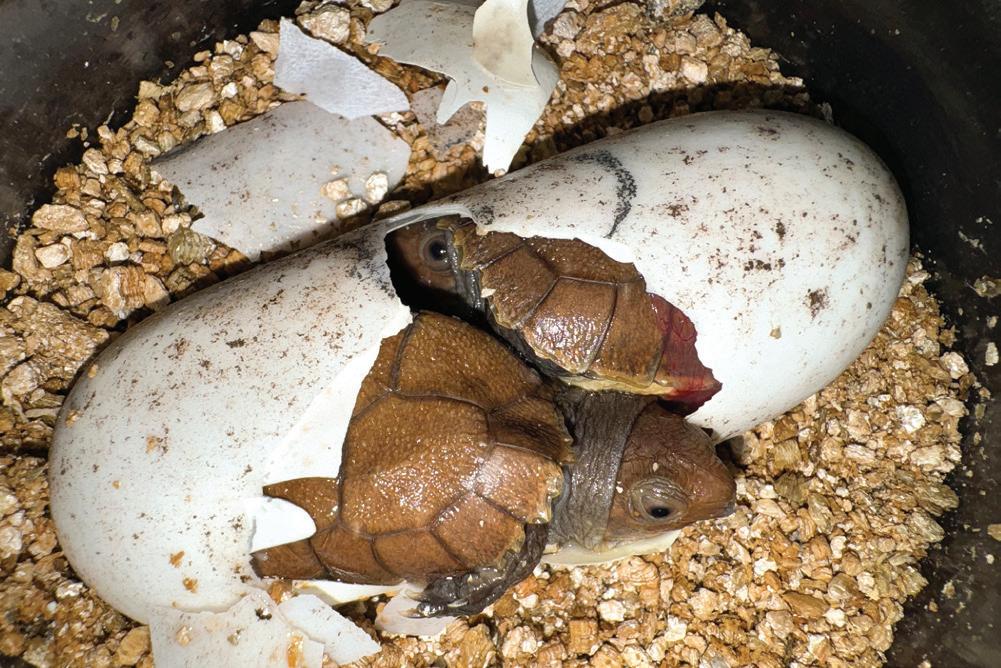
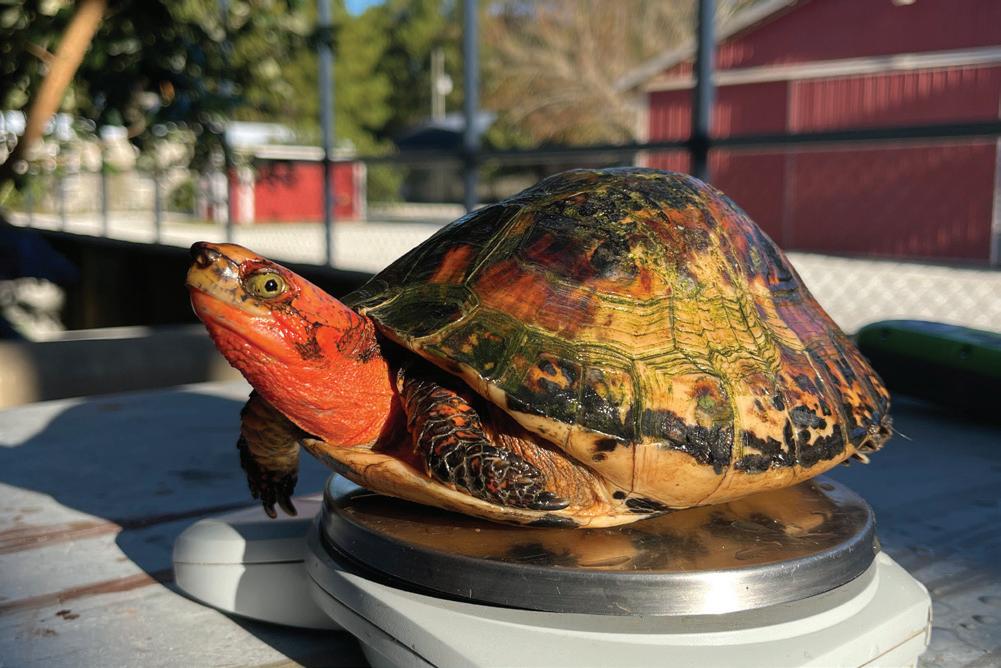
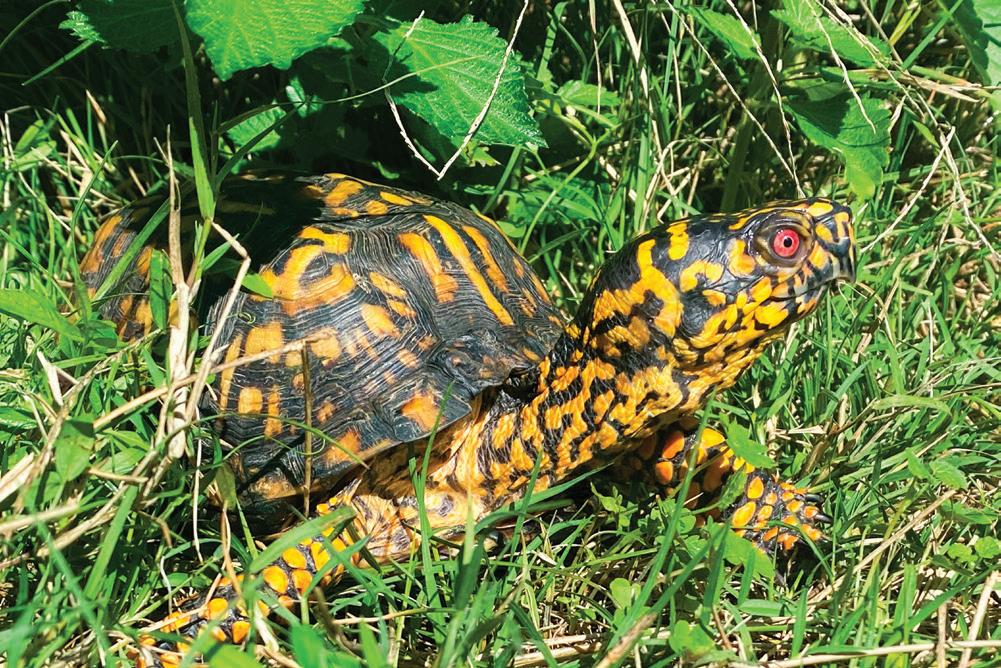
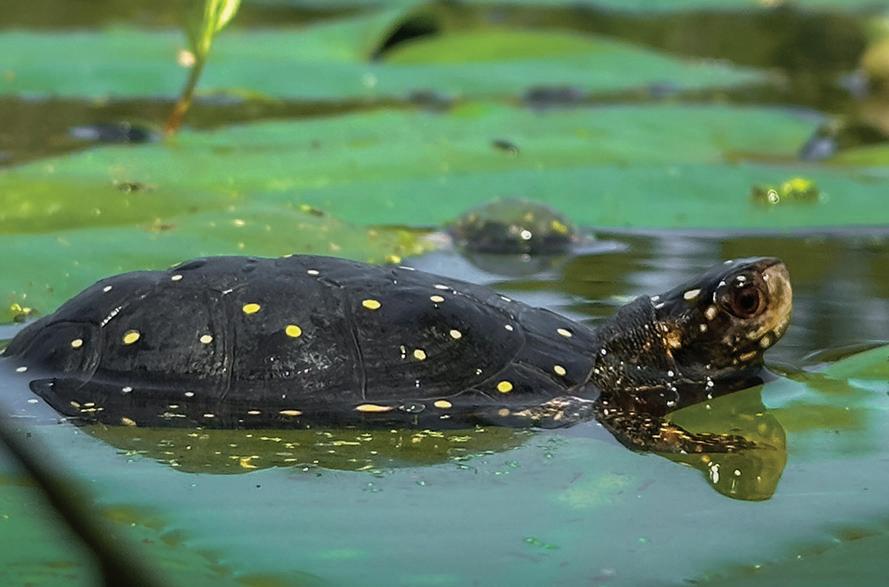
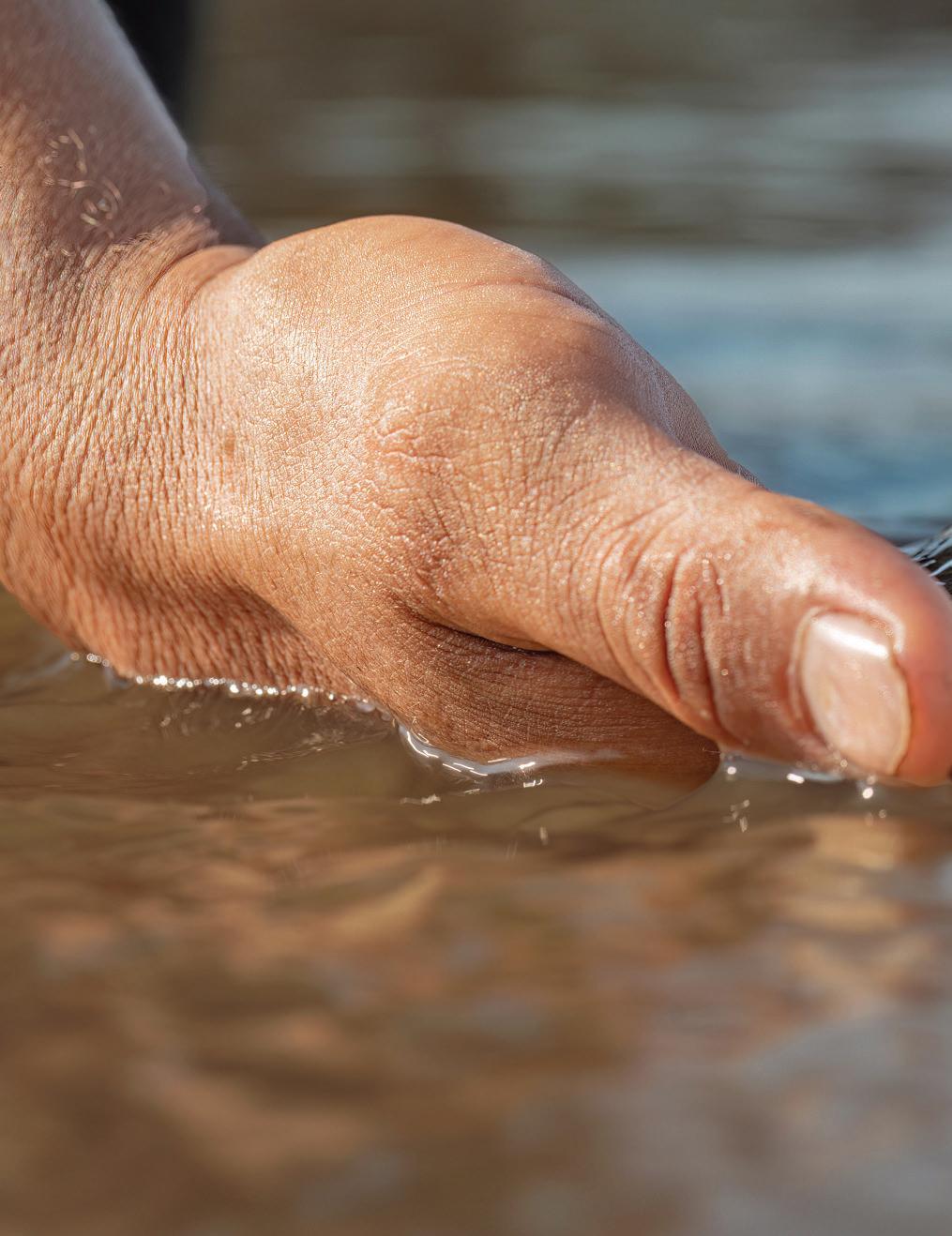
Rewilding Confiscations
| Rehabilitation | Protected Habitats
Turtle Survival Alliance restores wild turtle populations through strategic, sciencedriven rewilding programs. We return turtles rescued from illegal trade to the wild, reintroduce species to their former habitats, and strengthen existing populations in protected areas. To achieve this, we combat wildlife trafficking, provide expert care for rescued turtles, rehabilitate habitats, engage in conservation breeding, and translocate turtles of high genetic importance. We empower and support local partners and communities to ensure rewilded populations thrive. Each turtle we reintroduce brings us closer to our vision of Zero Turtle Extinctions.
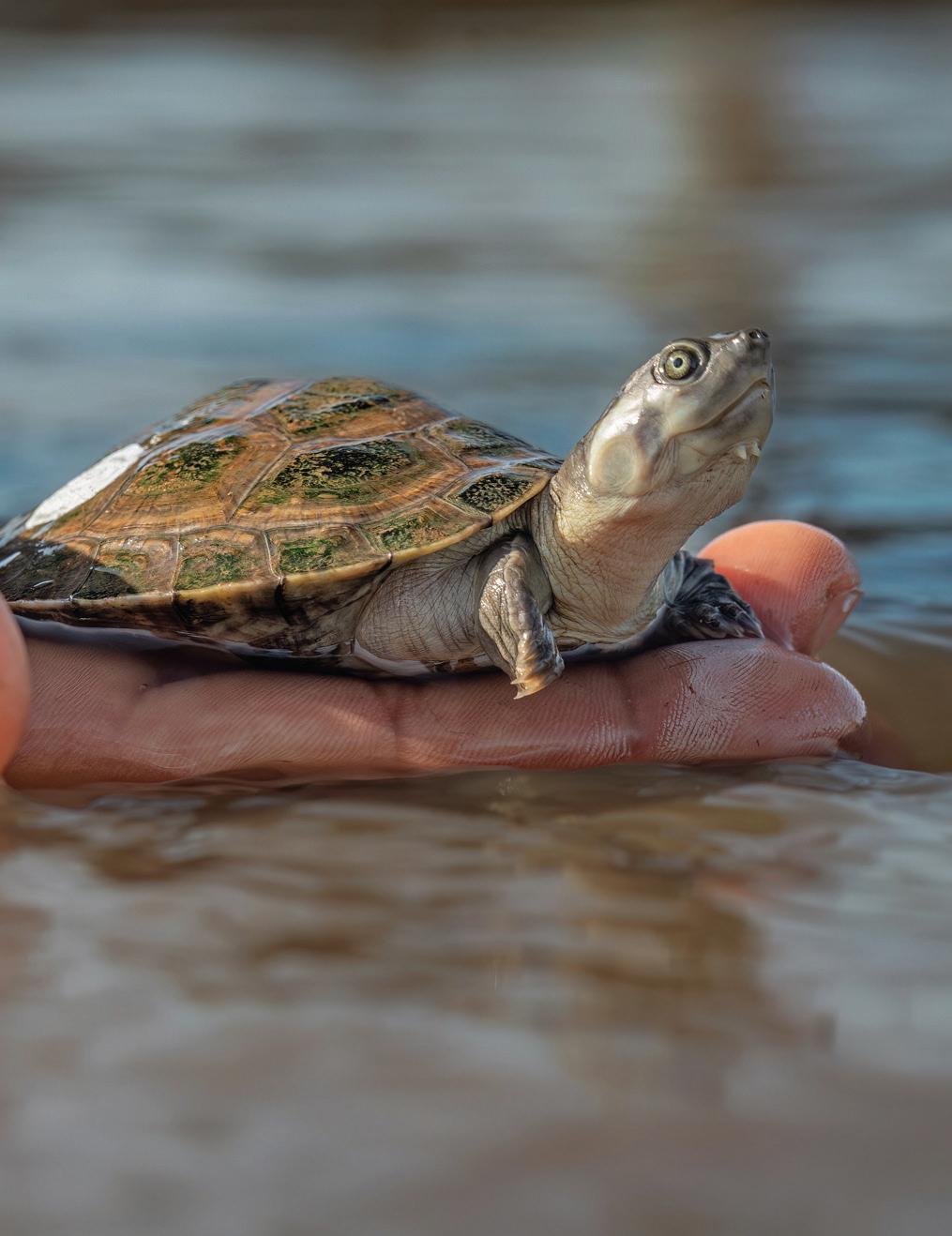
In the twelve years since the inception of the Magdalena River Turtle (Podocnemis lewyana) project in Cotocá Arriba along the Sinú River in Colombia, Turtle Survival Alliance and our partners have released a total of 16,340 hatchlings into the river, all from eggs rescued from flood-prone beaches. Here, a fisherman releases one of the 2,948 hatchlings produced in 2024. Photo by Jhonattan Vanegas
Bangladesh
2024 was a landmark year for turtle conservation in Bangladesh. In December, Turtle Survival Alliance, Creative Conservation Alliance, and the Bangladesh Forest Department reintroduced two critically endangered tortoise species to their native habitats. Six Elongated Tortoises (Indotestudo elongata) were released in Lawachara National Park and ten Asian Giant Tortoises (Manouria emys phayrei) were released into the Matamuhuri Reserve Forest, marking the first reintroduction of Elongated Tortoises in the country.
The two- to five-year-old tortoises, bred and raised at the Turtle Conservation Center in Bhawal National Park, were equipped with radio transmitters before entering expansive soft release enclosures, which help them adjust to their new home. They will be fully released into the forest in 2025. By implementing long-term recovery strategies, including these releases, we move closer to repopulating these species, restoring their habitats, and empowering local communities to champion turtle conservation.
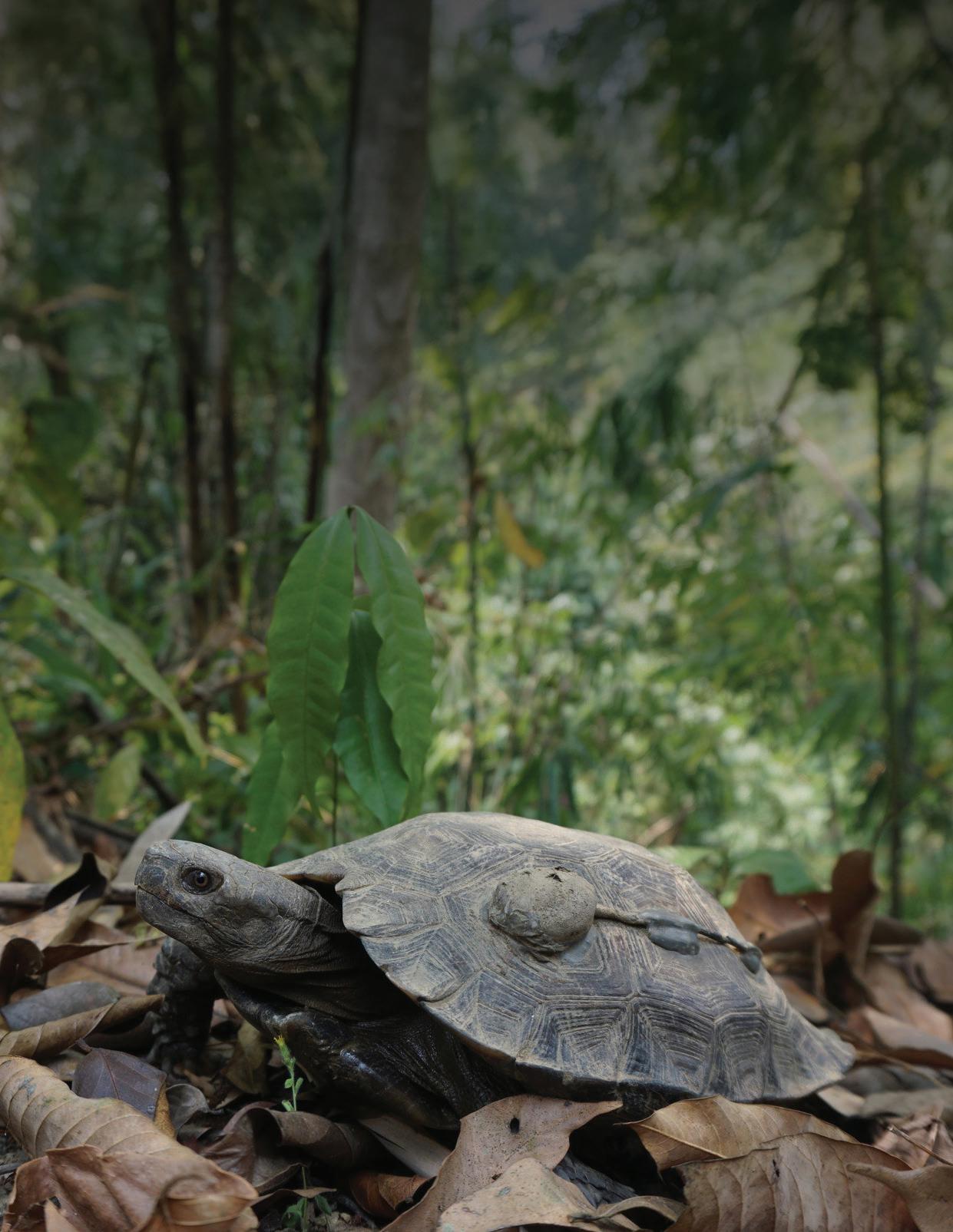
6
Elongated
10
“The soft release method has proven to be one of the most effective strategies for reestablishing turtles and tortoises into the wild. By allowing the animals to acclimate gradually within natural enclosures, we foster site fidelity and increase their chances of long-term survival, helping to ensure the success of these rewilding efforts.”
ANDREW WALDE, SENIOR DIRECTOR OF CONSERVATION & SCIENCE, TURTLE SURVIVAL ALLIANC E
A reintroduced Asian Giant Tortoise (Manouria emys phayrei).
Photo by Shahriar Caesar Rahman
Tortoises released—a historic first for the country
Asian Giant Tortoises released
Edwardo Pop, son of Hicatee Conservation & Research Center Manager Thomas Pop, assists in releasing young Central American River Turtles (Dermatemys mawii) into a river in central Belize. Photo by Heather Barrett
Belize
In 2024, the Belize Foundation for Research and Environmental Education (BFREE) conducted its largest release of headstarted Central American River Turtles (Dermatemys mawii) to date. Over four separate occasions, a total of 476 turtles, representing four age groups, were released into three different locations spanning three distinct river systems where the species has been historically documented through past surveys. All released turtles were fitted with a Passive Integrated Transponder (PIT-tag) for future identification and monitoring.
Since 2020, BFREE has successfully reintroduced a total of 1,002 headstarted Central American River Turtles, produced and reared at the joint Turtle Survival Alliance–BFREE Hicatee Conservation & Research Center, into the wild across eight aquatic systems, marking significant progress in efforts to restore wild populations of this critically endangered species.
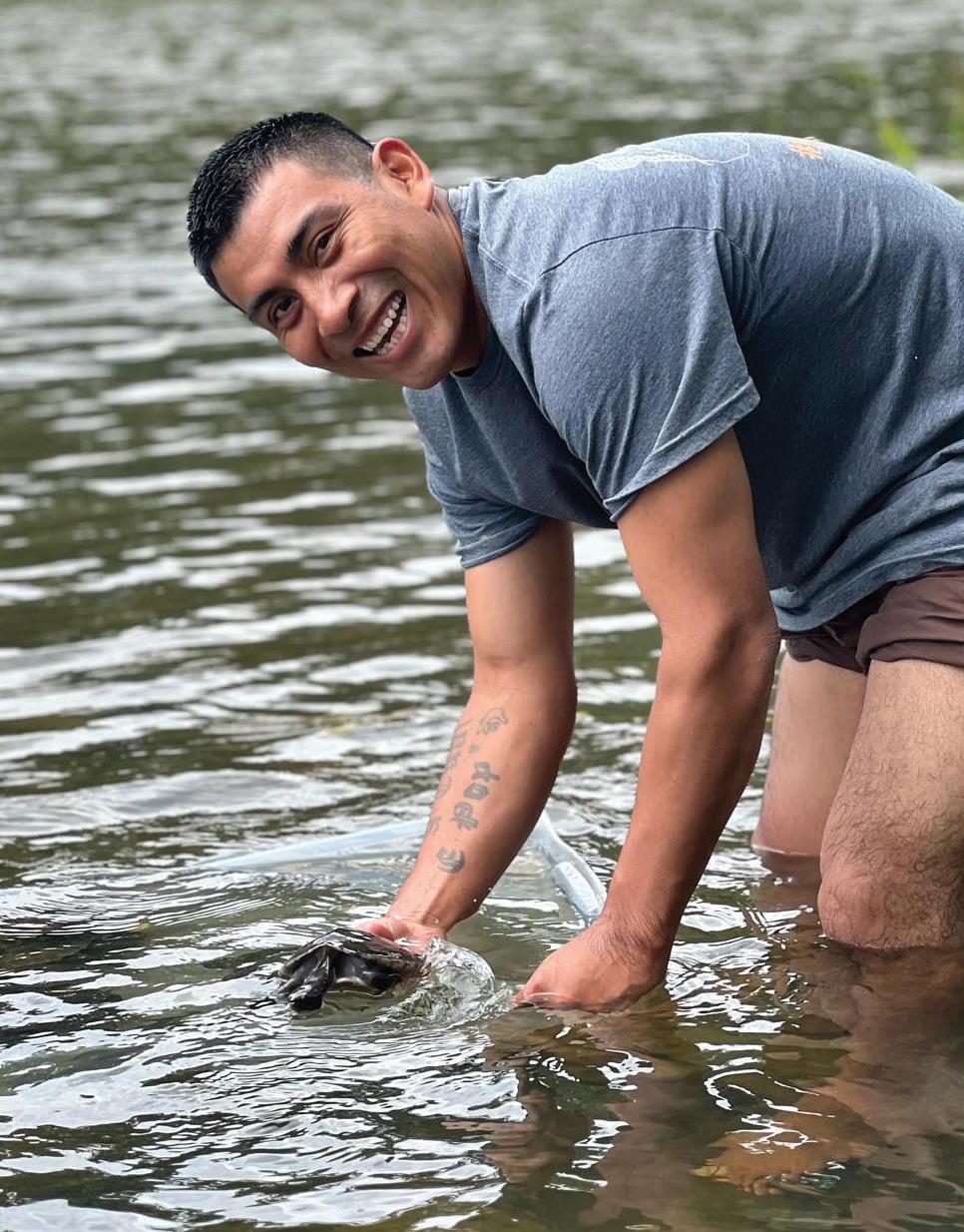
Jaren Serano
Dermatemys Program Coordinator, BFREE
476
1,002 Turtles released into the wild
Total turtles released into the wild since 2020
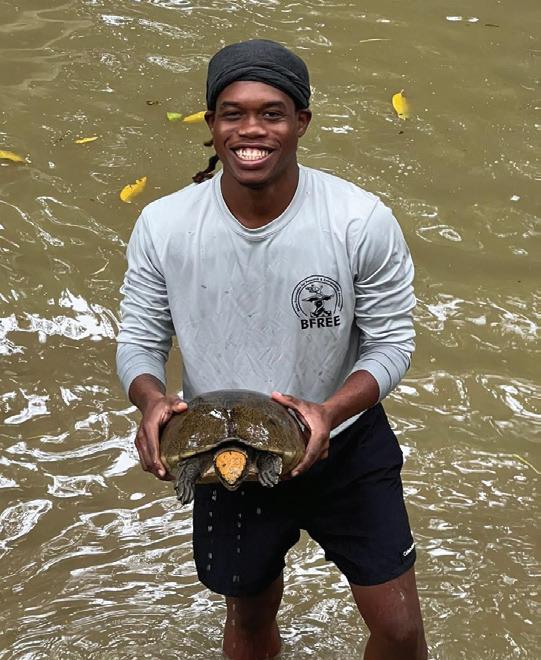
"This year, my conservation work for the Central American River Turtle—also known as the Hicatee—has focused on strengthening relationships with fishing communities and fostering communitydriven stewardship. By engaging fishers, farmers, women, and youth, we’re building collaborative efforts to safeguard the Hicatee and its freshwater habitats for generations to come." – Jaren Serano
Photo by Heather Barrett
Cambodia
In Cambodia, our partner in conservation, the Angkor Center for Conservation of Biodiversity (ACCB), achieved a record-breaking year for breeding critically endangered species while successfully releasing many turtles into the wild. For 84 Elongated Tortoises (Indotestudo elongata), this years-long process began with a soft release into a protected wildlife reserve, where local community members, known as “Tortoise Guardians,” monitor and protect the sites.
After nine months of acclimation in an expansive forested pen, ACCB staff opened the walls in January 2024, allowing the tortoises to self-release into their natural habitat. Since then, field staff have closely monitored them using GPS and radio telemetry, conducting regular health checks to ensure their wellbeing and site fidelity. Releasing captive-bred tortoises is a monumental step toward strengthening their wild population.
Head Keeper Noun Vannak (right) and Chelonian Keeper Pong Veasnak hold Southern River Terrapin (Batagur affinis) hatchlings. Photo by ACCB/Bethany Bradbury; An Elongated Tortoise (Indotestudo elongata) fitted with VHF radio and GPS transmitters. Photo by ACCB/Christel Griffioen
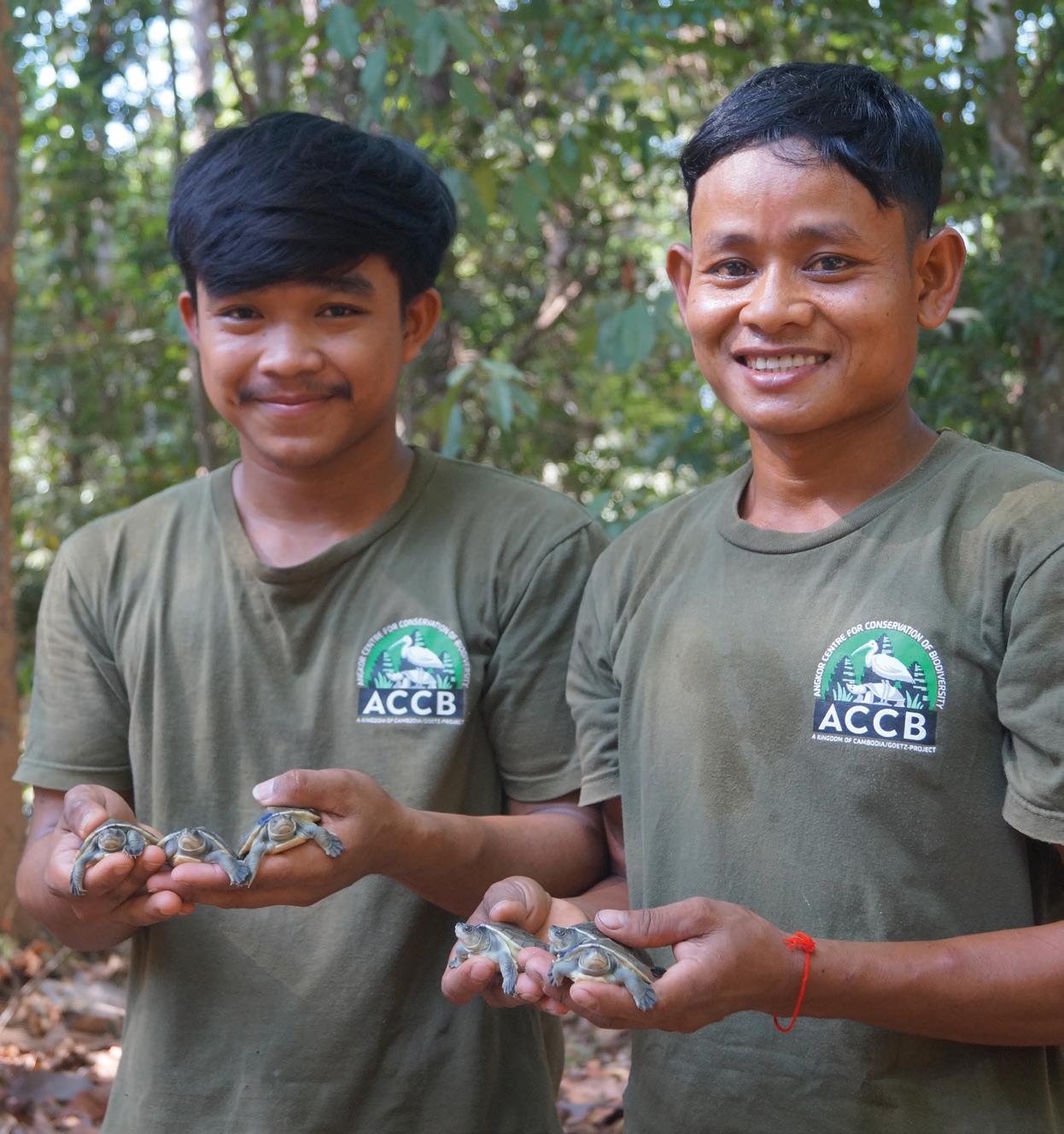
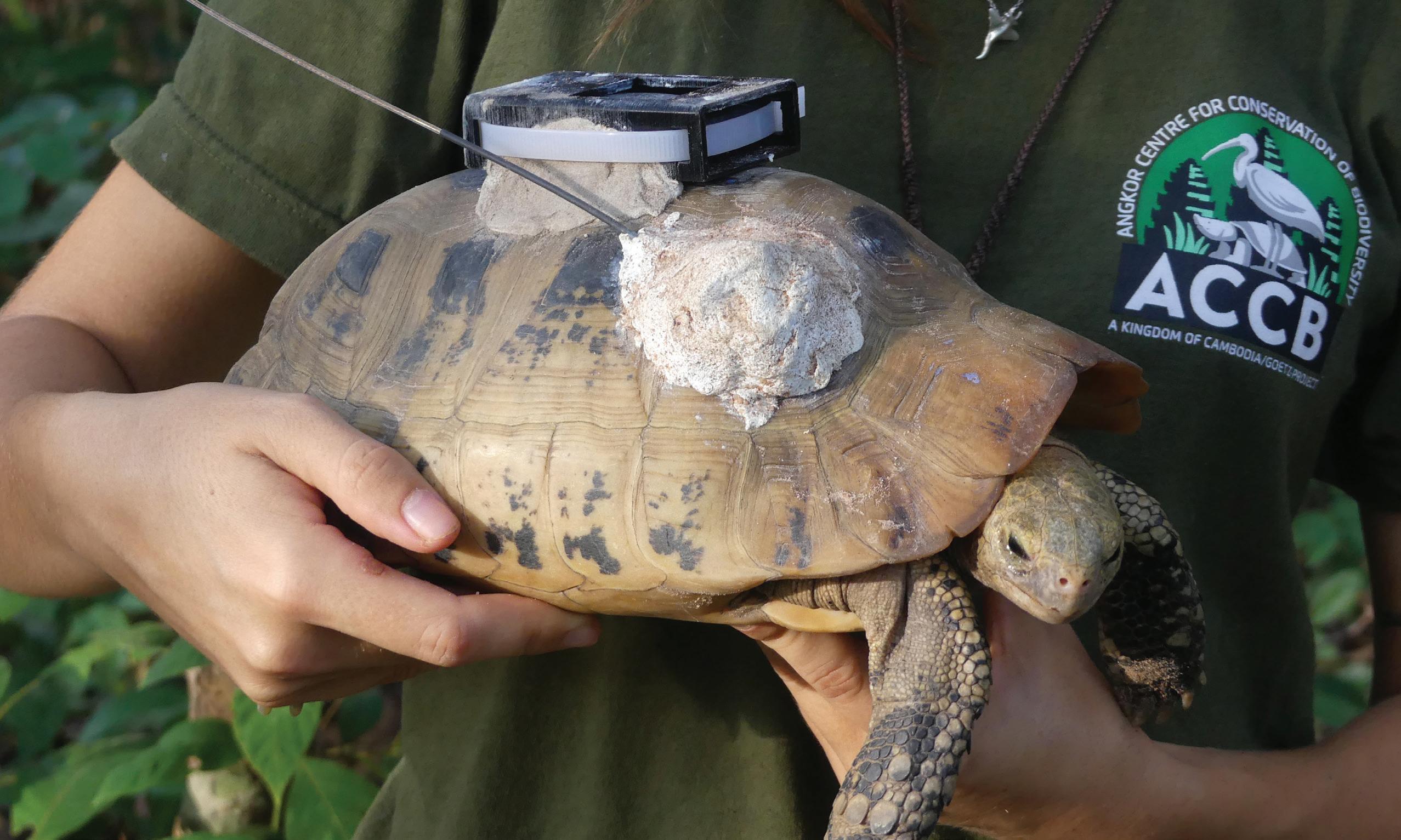
Elongated Tortoises released
2,948
2
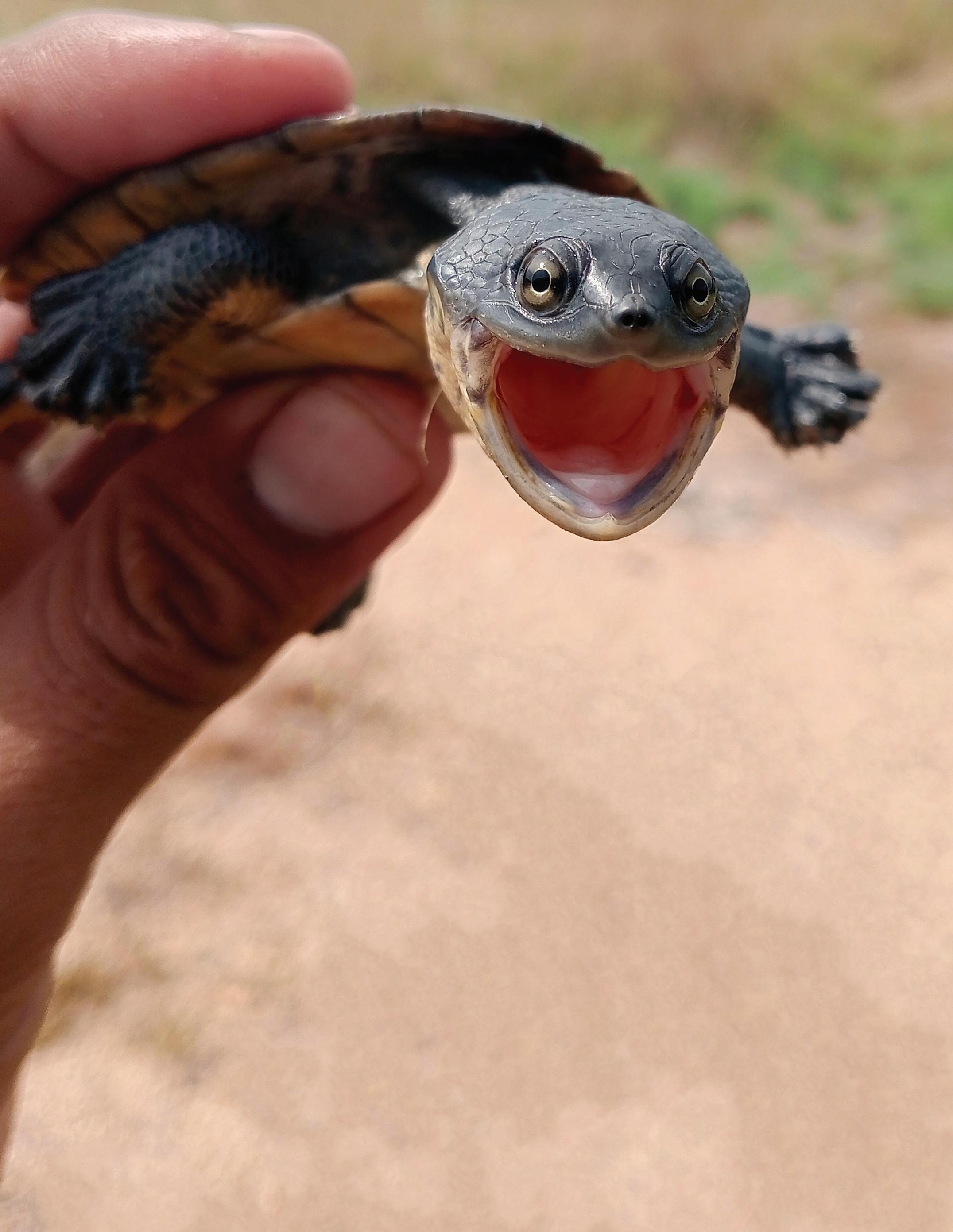
Genetically-based
Colombia
The Turtle Survival Alliance and Wildlife Conservation Society (WCS) turtle program marked another milestone year for conservation in Colombia. In Cotocá Arriba, Córdoba, we continued our longstanding partnership with Tortugas del Sinú to protect nests of the critically endangered Magdalena River Turtle (Podocnemis lewyana), rescuing eggs threatened by hydroelectric dam releases. This year, 190 nests were safeguarded, leading to a record-breaking 2,948 hatchlings successfully released into the wild.
Also in Colombia in 2024, La Carranchina Natural Reserve— established to protect the critically endangered Dahl’s Toad-headed Turtle (Mesoclemmys dahli)—and the lower basin of the Sinú River— home to our Magdalena River Turtle conservation site—became the first
A hatchling Dahl’s Toad-headed Turtle (Mesoclemmys dahli) produced at La Carranchina Natural Reserve.
two Key Biodiversity Areas (KBAs) in the world designated to protect genetic diversity. This milestone was made possible through genetic research conducted by TSA and WCS. Our research revealed four genetically distinct subpopulations of Dahl’s Toad-headed Turtle, each with limited connectivity and high levels of inbreeding (mating among relatives). In response, TSA and WCS launched the first-ever genetic rescue strategy for a turtle species. This pioneering effort involves translocating individuals from a genetically compatible subpopulation into La Carranchina Natural Reserve to reduce relatedness and boost genetic diversity. The Reserve now protects 30% of the Dahl’s Toadheaded Turtle’s unique genetic diversity, which is crucial for the species’ long-term survival.
Photo by Yeiner Vega
Tortugas del Sinú
La Carranchina Natural Reserve
KBAs established Hatchlings released into the wild
Malaysia
Turtle Survival Alliance proudly supports the Turtle Conservation Society of Malaysia to safeguard the Southern River Terrapin (Batagur affinis) in Peninsular Malaysia. In 2024, dedicated “Terrapin Guardians”— local community members who patrol the Kemaman River’s banks in search of nesting females—again played a crucial role in protecting this critically endangered species. Thanks to their efforts, a record-breaking 1,506 river terrapin eggs were collected and carefully incubated in a protected hatchery, the highest number since the project began in 2011. Remarkably, 1,176 hatchlings successfully emerged—an incredible 78.1% hatch rate, setting another milestone for the program.
On October 5, 2024, 670 of these hatchlings were released into the Kemaman River to commemorate the 67th year of Malaysia’s independence, with the remaining hatchlings released soon after. The event drew a crowd of over 650 attendees, coming together in celebration of this conservation success and the ongoing efforts to protect the species.
1,176
Southern River Terrapins hatched and released—a program record
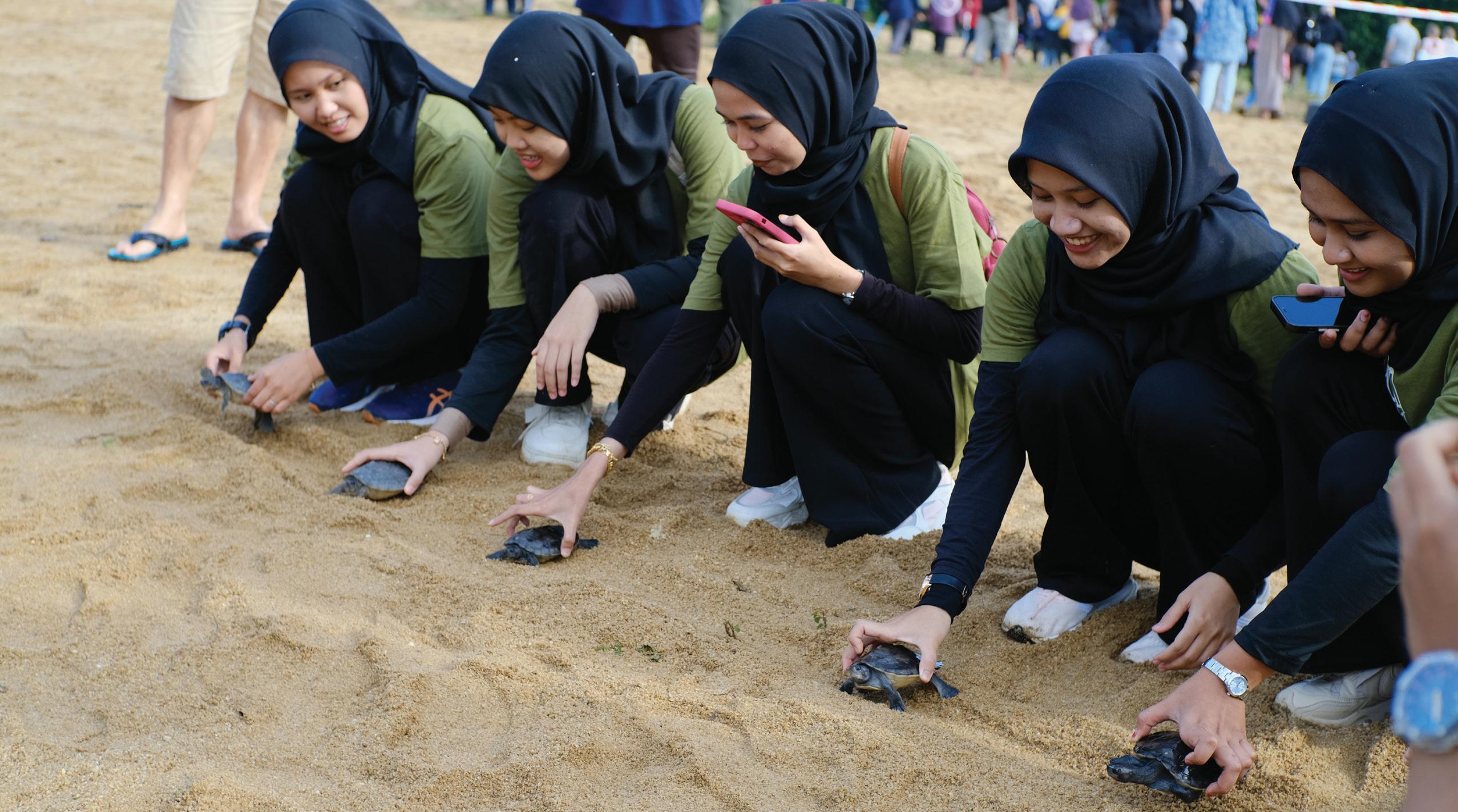
A group of students from the MARA Higher Skills College Kemaman release hatchling Southern River Terrapins (Batagur affinis) into the Kemaman River.
Photo by Megat Nurul Anwar bin Ahmad Nazeri
Turtle Conservation Society of Malaysia
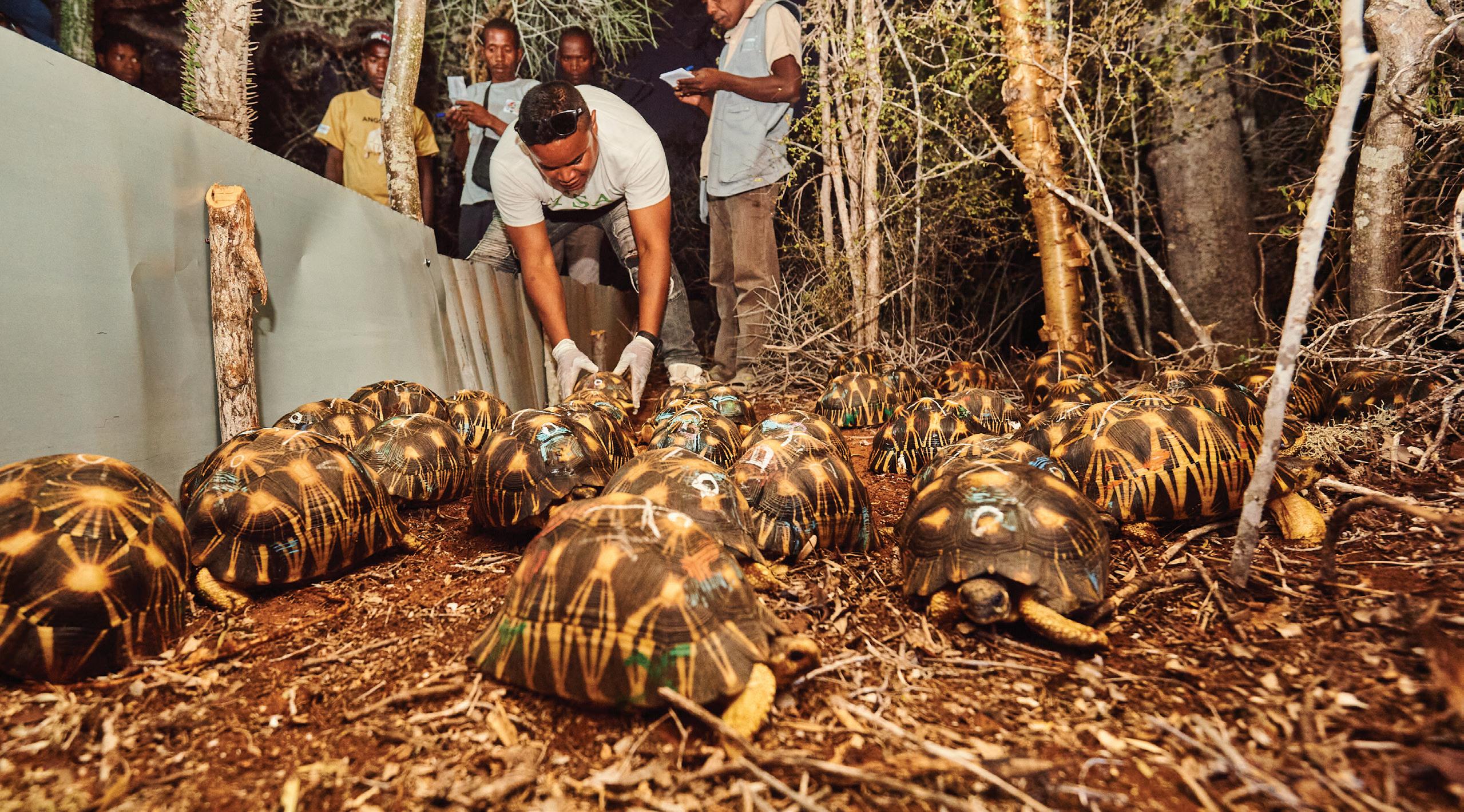
Turtle Survival Alliance Madagascar staff release Radiated Tortoises (Astrochelys radiata) into an expansive soft release pen in southwestern Madagascar. Photo by Andry Fandresena
Madagascar
To commemorate World Turtle Day® on May 23, 2024, we released 1,000 Radiated Tortoises (Astrochelys radiata) into an expansive softrelease pen near the coastal community of Mahazoarivo. A few months later, Turtle Survival Alliance staff, along with contracted veterinarians and ecologists, visited the site to check on the tortoises in the pre-release pen, conduct basic health evaluations, and prepare 20 individuals for long-term monitoring by attaching VHF radios and GPS loggers. The habitat at this release site is significantly more open than previous locations, and since the release occurred during the dry
season, the tortoises consumed all available food within the habitat.
Concerned by their weight loss— especially with another three months of penning ahead—we gathered local community members and entered into a mutually beneficial agreement in which they would provide spineless cactus and greens, ensuring these important animals regained a healthy weight before release. In addition to supplemental feeding, veterinary staff traveled to the site for thorough examinations to rule out disease as a cause of weight loss. Overall, the community has been highly supportive of this effort and is eager to welcome even more tortoises in the future.
1,000 Radiated Tortoises released on World Turtle Day®
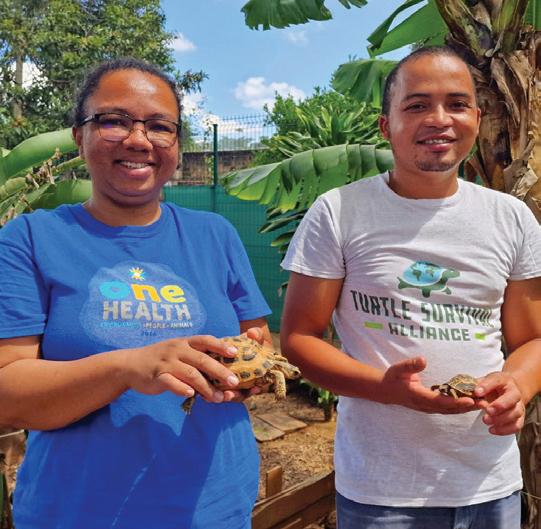
Tsanta Fiderana Rakotonanahary
Head of Veterinary Support, Turtle Survival Alliance Madagascar
“Together, we will ensure that every confiscated tortoise in our care has a chance to thrive once more in the wild.” –Tsanta Fiderana Rakotonanahary
Tortoise Keeper, Turtle Survival Alliance Madagascar
“I love my job, and I am proud to play a role in saving Madagascar’s endemic tortoises from extinction.” –Rajo Andrianaivojaona
Tsanta Fiderana Rakotonanahary (left) and Rajo Andrianaivojaona. Photo by Andry Fandresena Rajo Andrianaivojaona
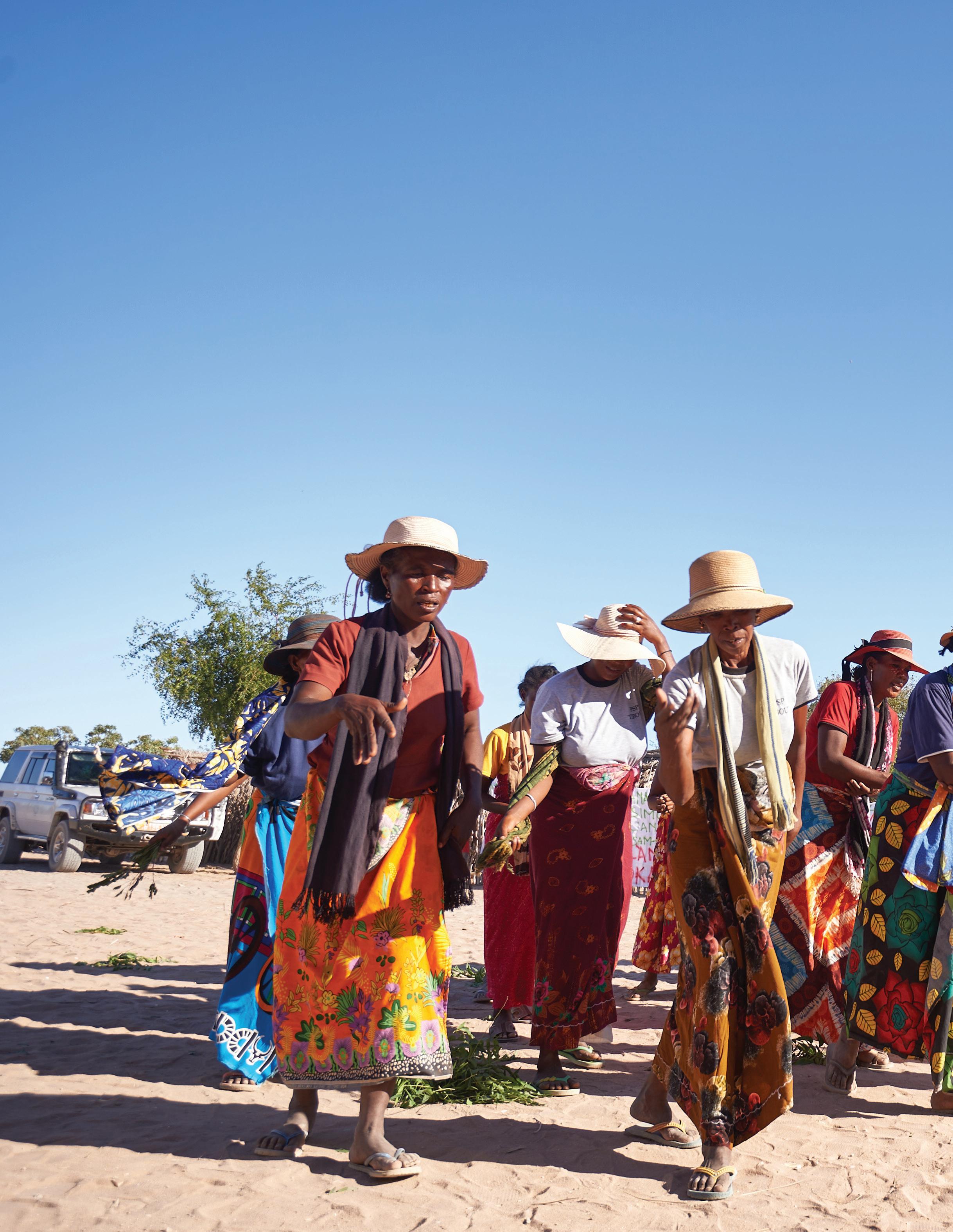
Local Involvement
Development & Enhancement | Capacity Building | Local Leadership
Turtle Survival Alliance places local involvement at the heart of its mission to protect and restore turtle and tortoise populations worldwide. We empower individuals and partners by providing resources, training, and support to safeguard critical species and their habitats. By working alongside local leaders, communities, conservationists, and volunteers, we ensure long-term protection for turtle populations and inspire stewardship that fosters lasting conservation impact. Strengthening these local connections drives our efforts to rebuild self-sustaining populations and brings us closer to a future where turtles and tortoises thrive once more in the wild.
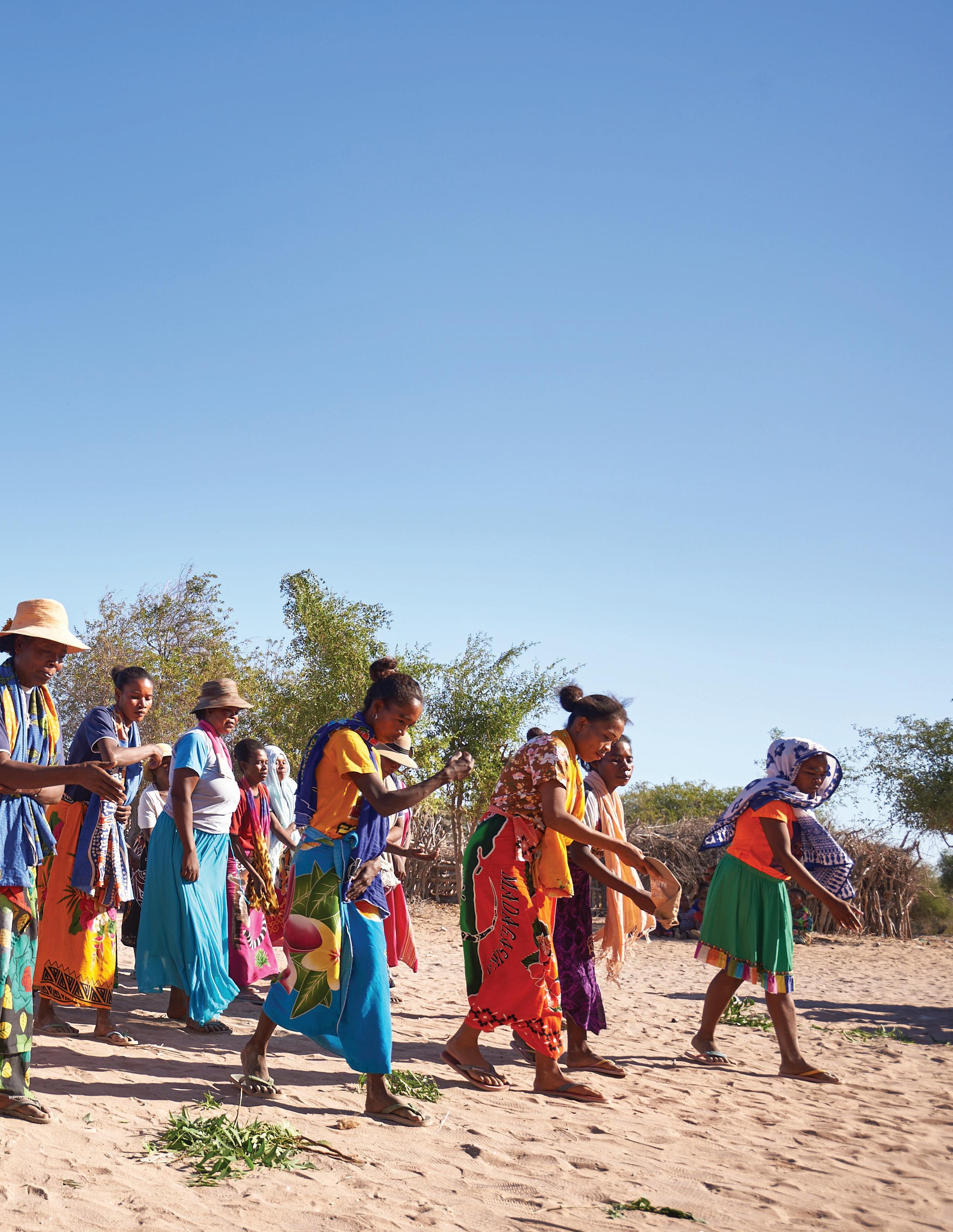
Women from the village of Mahazoarivo dance in unison during the celebration marking the release of 1,000 Radiated Tortoises (Astrochely radiata) into their community-protected forest on World Turtle Day®, May 23, 2024.
Photo by Andry Fandresena
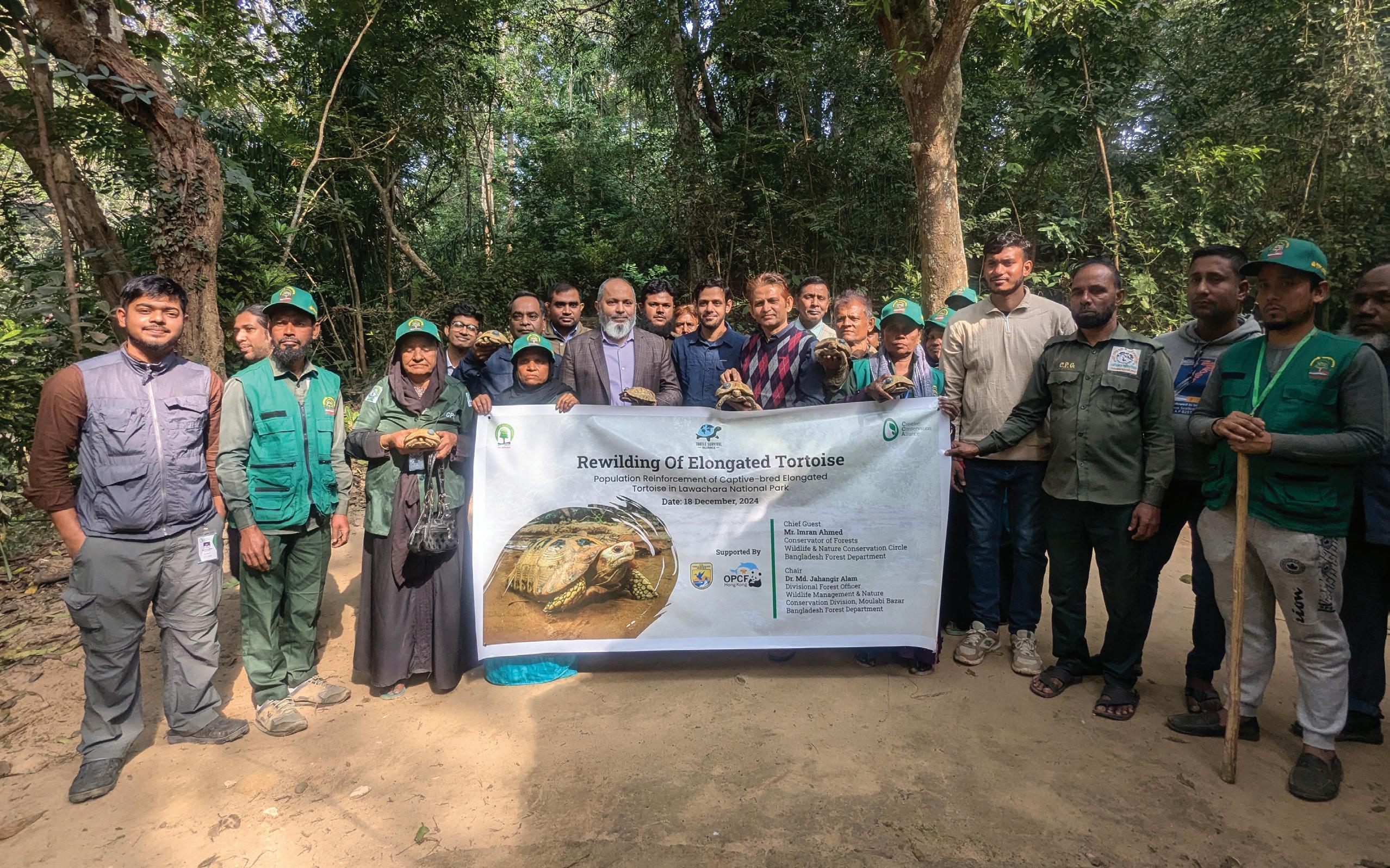
Bangladesh
Local communities in Bangladesh play a vital role in rewilding critically endangered tortoises, culminating in the historic return of Asian Giant Tortoises (Manouria emys phayrei) and Elongated Tortoises (Indotestudo elongata) this December.
The Creative Conservation Alliance, with support from Turtle Survival Alliance, leads this decade-long, multifaceted initiative in collaboration with the Bandarban Hill District Council, the Mro communities of Menni Para Village in Matamuhuri Reserve Forest, the Phulbari Tea Estate communities, and local government agencies and officials. Through cultivated relationships and ongoing engagement, these communities have become key partners in habitat protection and tortoise monitoring. Their combined efforts are essential to returning these species to the wild, ensuring long-term survival through local stewardship.
The historic release celebration for Elongated Tortoises (Indotestudo elongata) released into Lawachara National Park on December 18, 2024. Photo courtesy of CCA
“By committing to protect tortoises and their habitat, and by using the tortoise as a flagship species, this program indirectly reduces hunting pressure on several other globally threatened species. It stands as a testament to the power of community engagement and collaboration.”
SHAHRIAR CAESAR RAHMAN, CEO OF THE CREATIVE CONSERVATION ALLIANCE (CCA)
Colombia
For over 10 years, the community of Cotocá Arriba has been central to the successful conservation of the critically endangered Magdalena River Turtle (Podocnemis lewyana). Every year, during nesting season, conservation champions patrol the Sinú River’s beaches daily, locating evidence of nesting females and rescuing at-risk nests. The rescued eggs are incubated, with a dedicated group of women caring for them until the hatchlings emerge and are released. Since the initiative’s inception, the community has rescued over 1,000
nests and released more than 16,000 hatchlings, solidifying its role as a key ally in one of the largest conservation initiatives for the species in its range.
Additionally, in 2024, we enhanced guide training and introduced more structured tours, resulting in over 200 visitors engaging with the community-led River Turtle Educational Center and increasing awareness of the species and its habitat. What began as a focused effort to preserve the species has evolved into a model of community ownership.
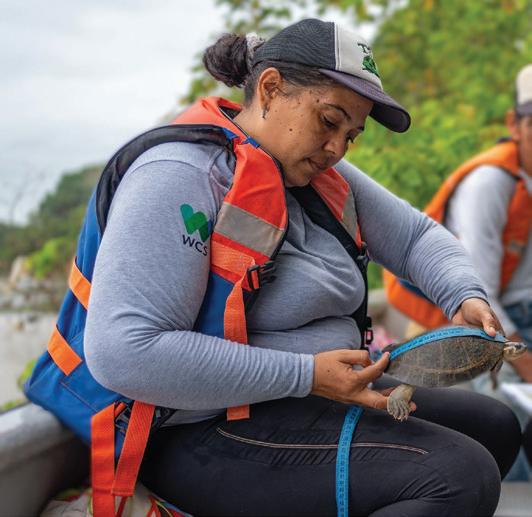
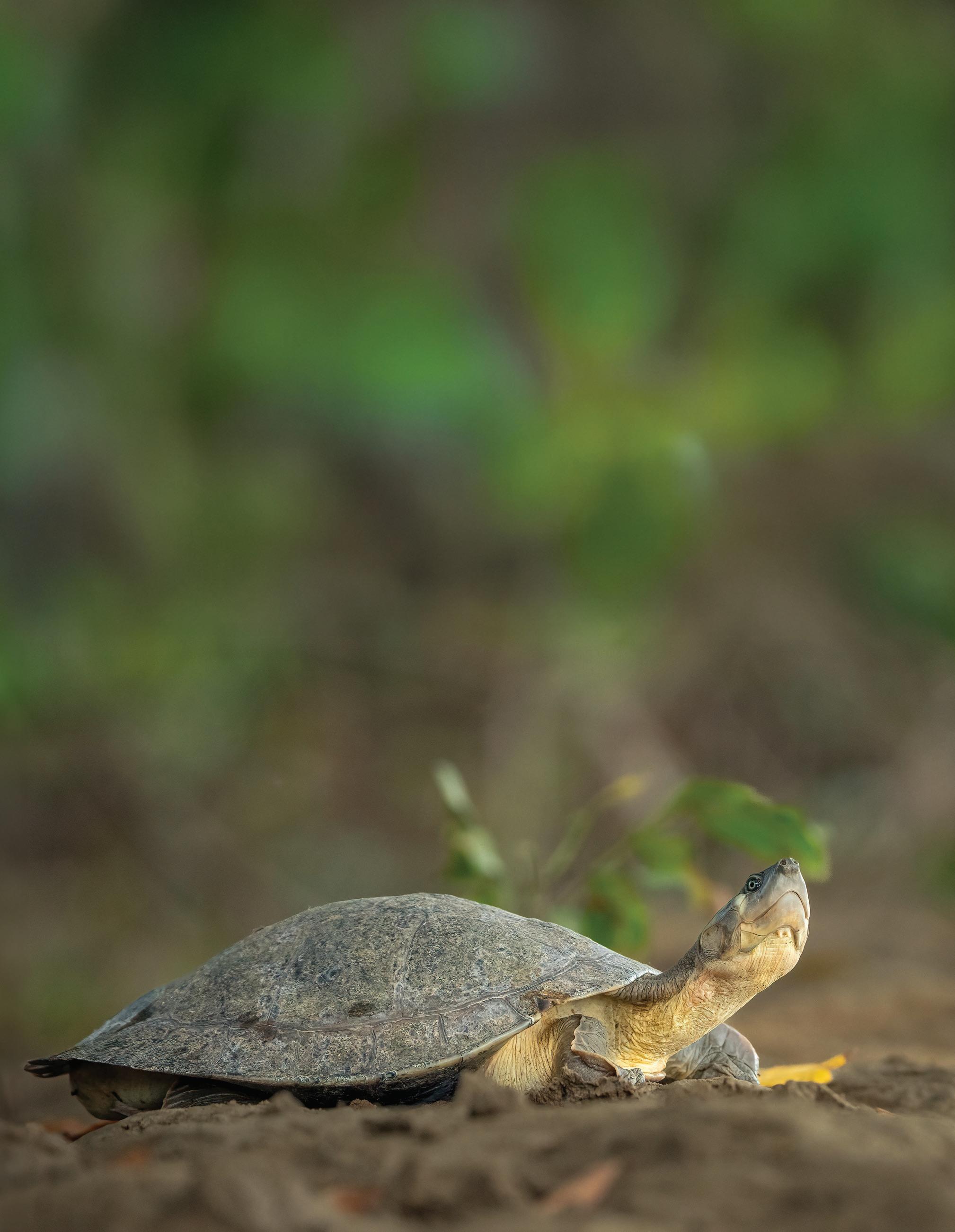
16,000+
“Conserving an endangered turtle species has been a deeply rewarding life experience. It has allowed me to obtain resources to help my family, and day by day, I feel that I am part of a valuable effort for my community.” –Yuli Doria Negrette
A Magdalena River Turtle (Podocnemis lewyana) in Cotocá Arriba.
Photo by Jhonattan Vanegas
Photo by Jhonattan Vanegas
Yuli Doria Negrette
Incubation Technician, Tortugas del Sinú
Hatchlings released since the program’s inception
Kenya
Saving a turtle species from extinction starts with the people who share its environment and understand the threats these species face. The Pancake Tortoise (Malacochersus tornieri), a critically endangered species native to East Africa, could soon disappear without intervention.
Turtle Survival Alliance, in partnership with the Lewa Wildlife Conservancy, National Museums of Kenya, and Kenya Wildlife Service is spearheading Kenya's National Recovery Action Plan for the species. This initiative secures the Pancake Tortoise's future through scientific
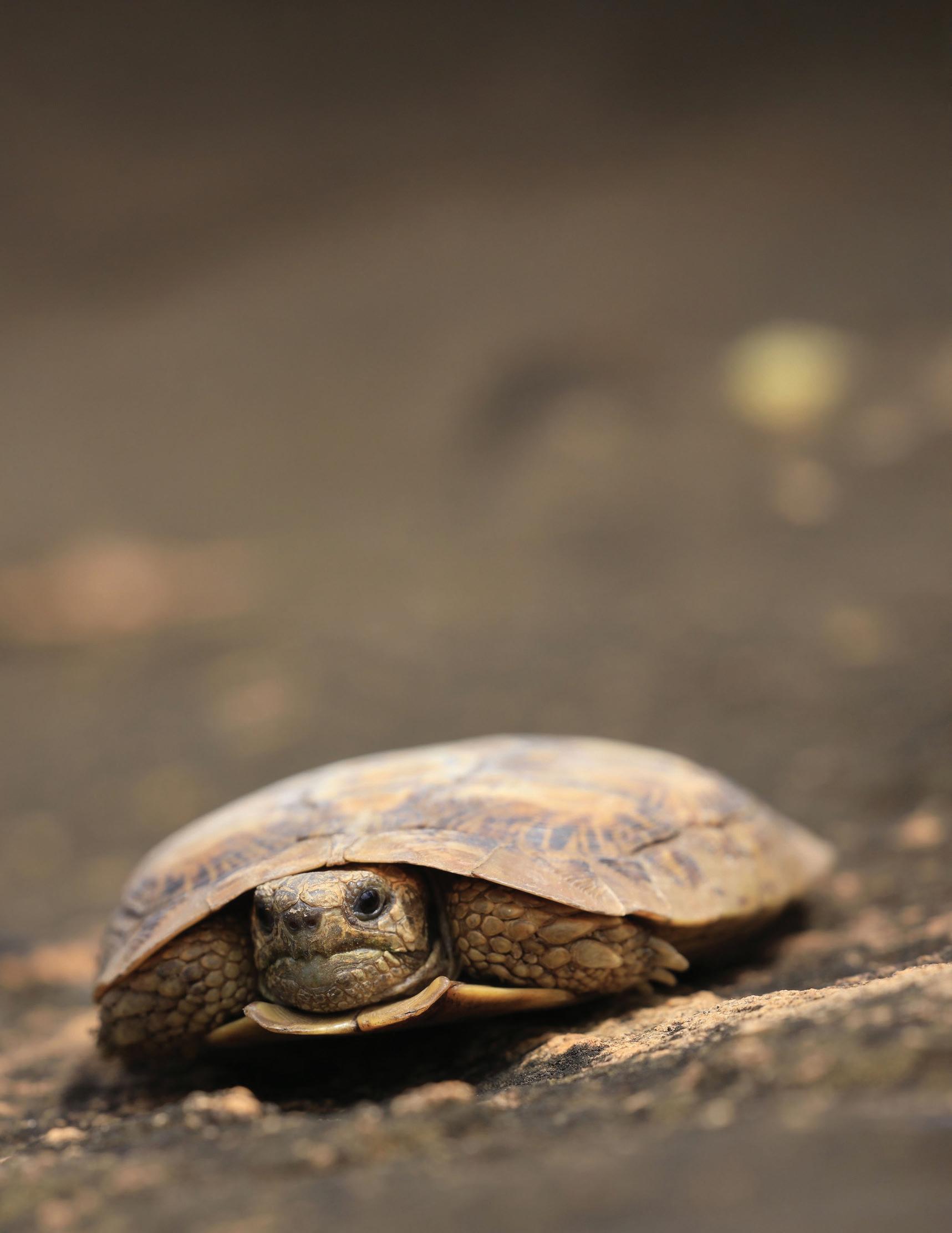
monitoring, habitat restoration, and, most importantly, fostering collaboration among local communities and conservation partners to work toward shared conservation goals.
In 2024, we successfully added additional communities, bringing the total to 12 community conservancies across four counties in northern Kenya engaged in the plan. These efforts included educating communities about the species' threats and urging them to prioritize its conservation by listing it as a key species to monitor and protect within their conservancies.

Top to bottom: Lewa Wildlife Conservancy staff share Pancake Tortoise (Malacochersus tornieri) field knowledge with Westgate Community Conservancy staff, community members, and local leaders—one of 12 community conservancies engaged in 2024. Photo by Francis Kobia; The critically endangered Pancake Tortoise. Photo courtesy of Lewa Wildlife Conservancy
12
Conservancies engaged in the National Recovery Action Plan for Pancake Tortoises
1,506 1,200
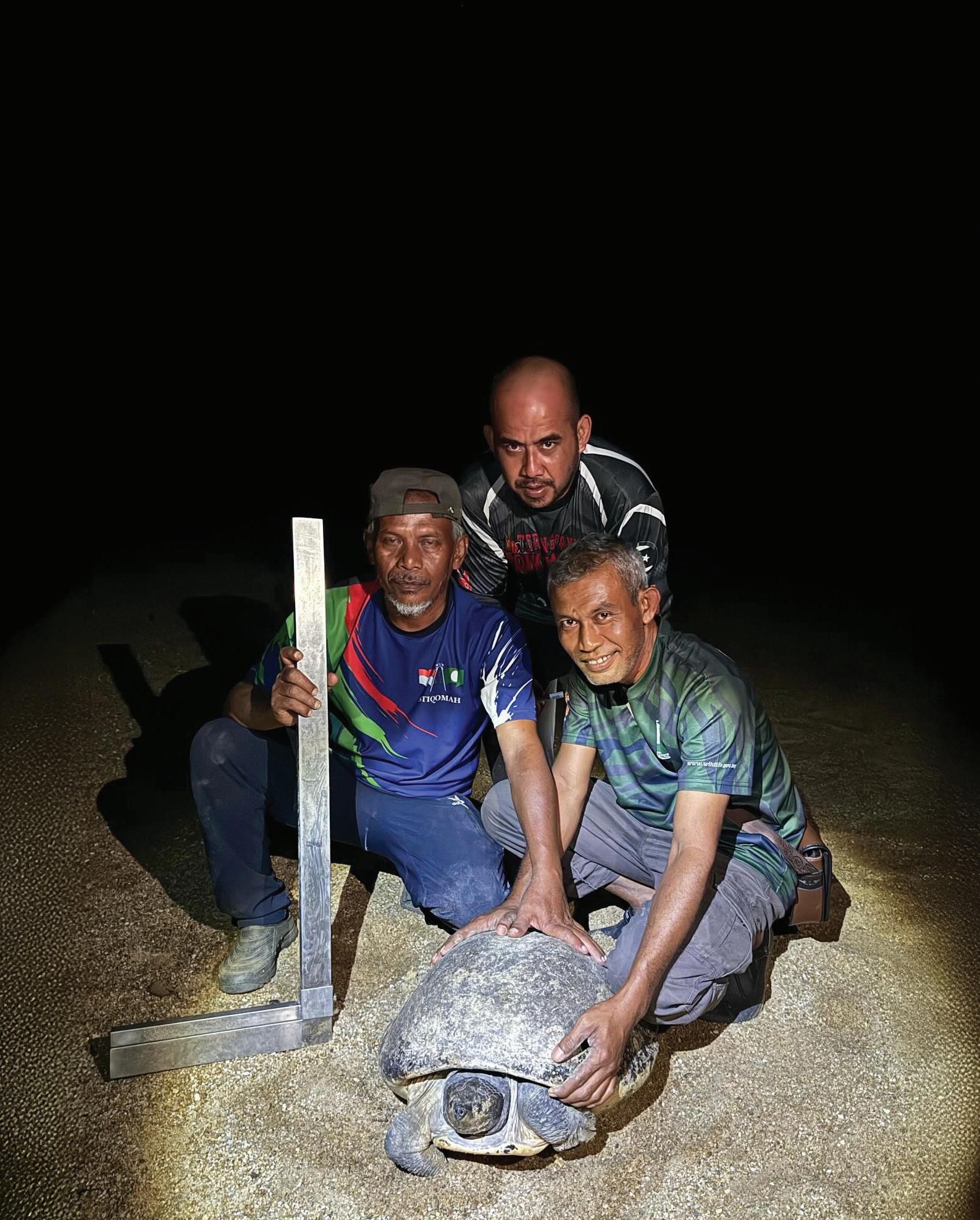
Malaysia
Turtles released into the wild
Pounds of abandoned fishing gear cleaned from the Kemaman River
Since 2011, the “Terrapin Guardians” of Kg. Pasir Gajah, Kemaman, Terengganu, have been essential to the Turtle Survival Alliancesupported Turtle Conservation Society of Malaysia’s efforts to protect the critically endangered Southern River Terrapin (Batagur affinis). What began with five dedicated villagers has grown into a trusted team of 14, all committed to safeguarding this species. During nesting season, the Guardians work tirelessly from nightfall to dawn under challenging conditions,
collecting and transporting terrapin eggs to a secure hatchery. In 2024, they collected a record 1,506 eggs for incubation.
The Guardians also conduct weekly river surveys to remove discarded fishing gear—a major threat to the terrapins. In the past year, they cleared over 1,200 pounds (560 kg) of abandoned gear, helping to ensure a safer habitat for the species. Their dedication is vital to the Southern River Terrapin’s survival in the Kemaman River.
"Terrapin Guardians," local heroes who work late into the night during the Southern River Terrapin (Batagur affinis) nesting season, protect females and their eggs from poachers along the sandbanks of Malaysia’s Kemaman River. Photo by Aminah Binti Madi
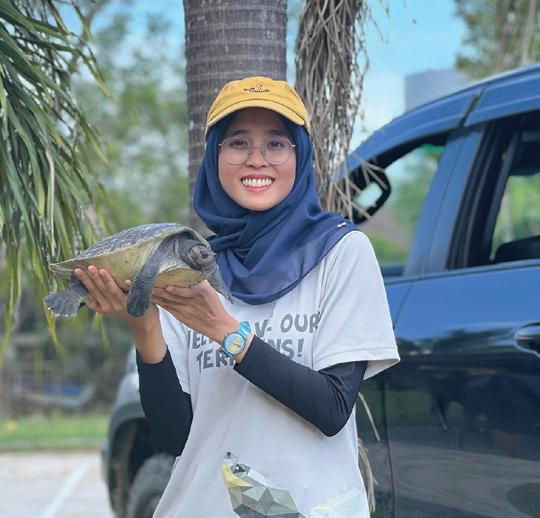
Aminah Madi
Research and Conservation Officer, Turtle Conservation Society of
“I am an early-career researcher entrusted with leading a team of male Terrapin Guardians in our conservation project. Being a woman in a male-dominated field has its obstacles, but through support from the leadership and open, consistent communication, we’ve built a trusting and effective partnership. This positive dynamic has not only contributed to the success of our conservation efforts for the Southern River Terrapin but has also strengthened our organization as a whole.
Despite the challenges, I’m proud of how far we’ve come and the impact we’ve made together in protecting this critically endangered species.”
–Aminah Madi
Photo by Nurul 'Ain Najwa binti Zahar Azuar
Malaysia
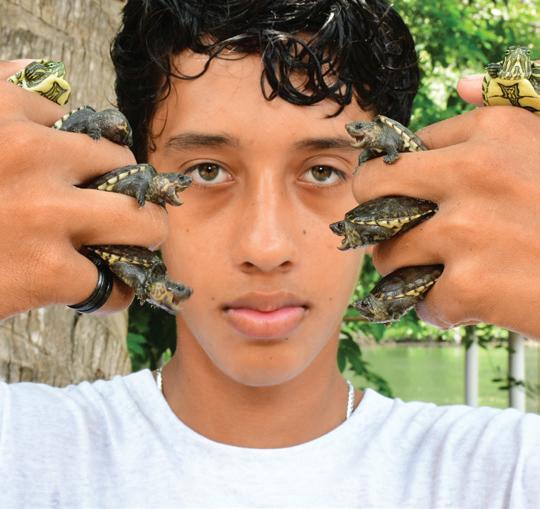
Juan Baldovinos
“For our community, protecting the Pacific Coast Musk Turtle means taking care of our home. This species has lived in our waters for generations, and its survival reflects the health of our rivers and wetlands. Our waterbodies, wildlife, and traditions are all connected, and saving the Pacific Coast Musk Turtle means preserving that balance for years to come.”
–Juan Pablo Baldovinos
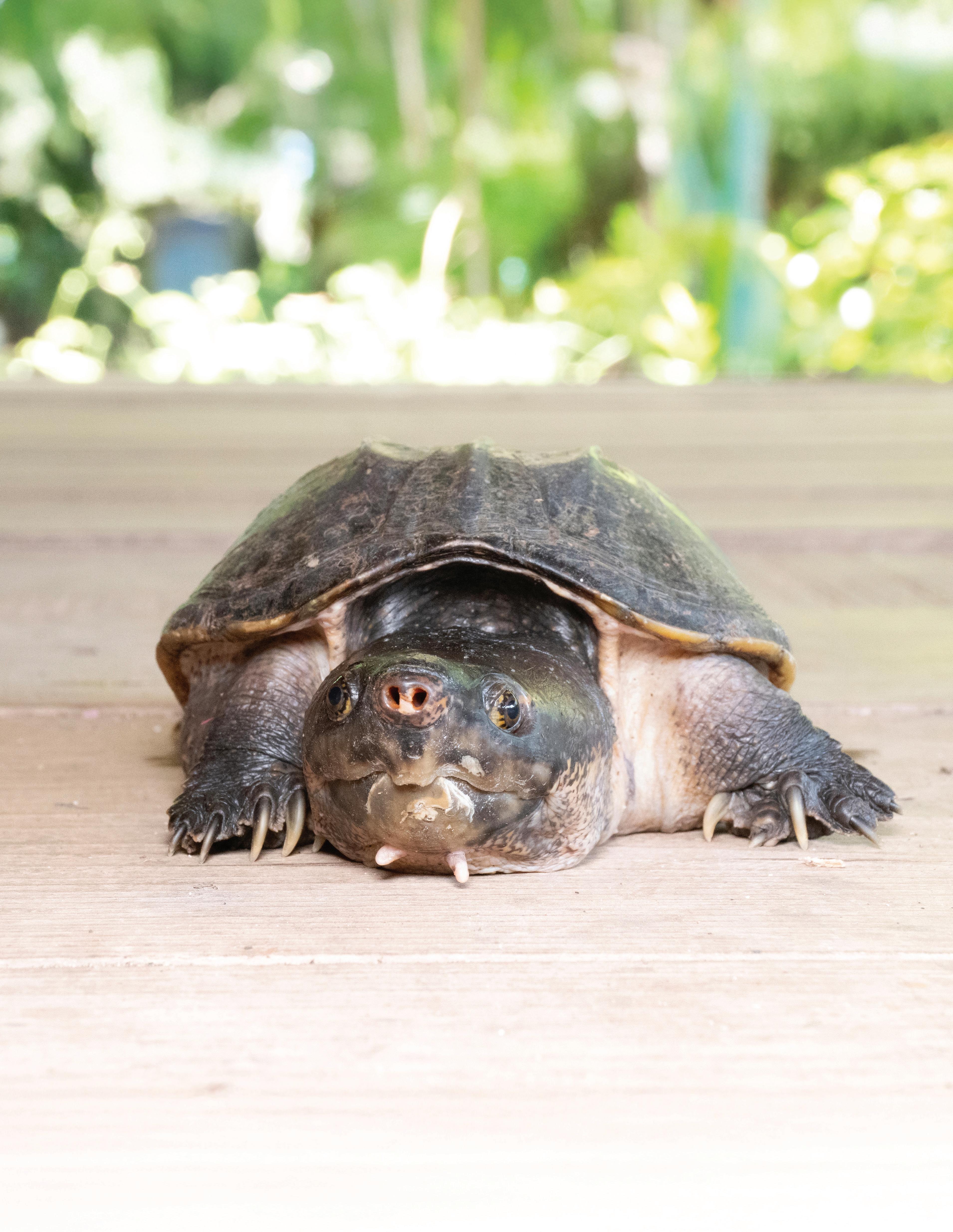
A Pacific Coast Musk Turtle (Staurotypus salvinii) awaits scientific documentation in Chiapas, Mexico. Photo by Eduardo
Mexico
In Chiapas, Mexico, Turtle Survival Alliance-supported Ph.D. student Eduardo Reyes Grajales advances turtle conservation not only through his own dedication but also with the support of community members like Juan Baldovinos. A dedicated youth leader from El Castaño, Mapastepec, Juan plays a key role in conserving the Pacific Coast Musk Turtle (Staurotypus salvinii) and other freshwater turtles in his area of western Chiapas. With a deep understanding of the local environment,
Juan collaborates with researchers and contributes valuable insights into habitat use, nesting behavior, and population dynamics. His efforts include monitoring turtle populations, engaging local fishers in conservation discussions, and documenting traditional ecological knowledge. Through his leadership, Juan has strengthened community participation in conservation initiatives, fostering stewardship and long-term commitment to protecting these endangered species.
Reyes Grajales
Photo by Eduardo Reyes Grajales
Community Youth Leader, El Castaño, Mapastepec
United States of America
Volunteer Science
In 2024, we celebrated a major milestone for the Turtle Survival Alliance Volunteer Science program. October marked the 25th anniversary of its ongoing surveys at Wekiwa Springs State Park, Florida, USA. This long-term survey aims to study the diverse freshwater turtle population
that inhabits Wekiwa Springs.
The Volunteer Science program engages volunteers in research surveys, guided by professional biologists, to collect vital data essential for understanding and protecting turtle species and their habitats across the United States.
Shannon Letcher measures a juvenile Florida Softshell Turtle (Apalone ferox), one of more than 5,000 unique turtles cataloged over the 25-year span of the study.
Photo by John Whitfield
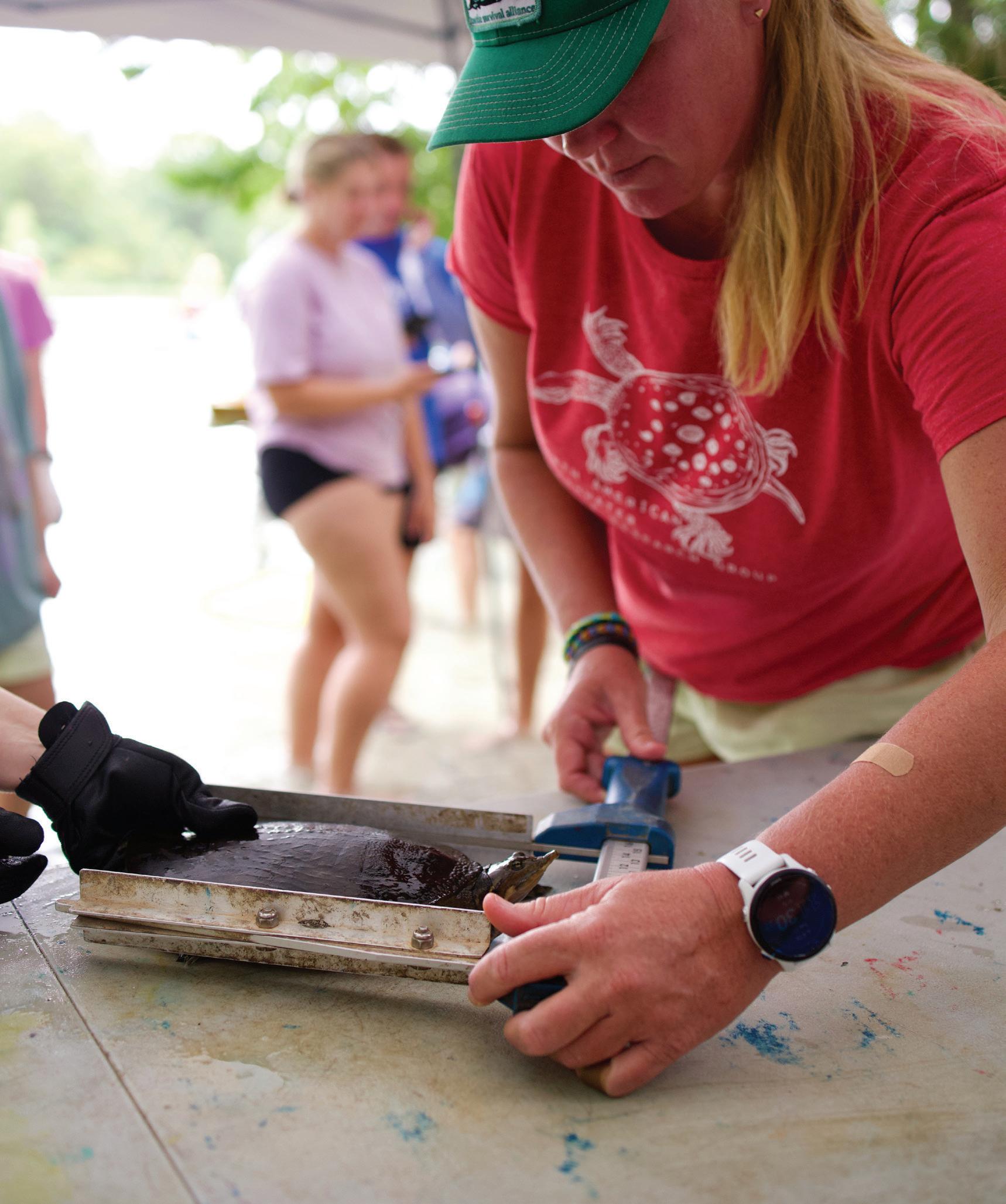
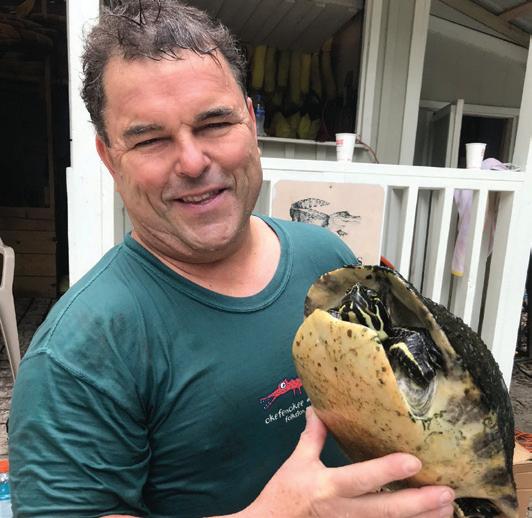
“As an older member of Turtle Survival Alliance, working with all of these young wildlife conservationists is truly inspiring and warms my heart. I take pride in helping them in any way I can.” –Chris Daughtry
“Reaching the 25-year milestone is an incredible achievement and truly worth celebrating. It’s a testament to unwavering dedication, a strong sense of family and friendship, and, of course, a shared passion for turtles that has kept this project thriving for so many years.”
ERIC MUNSCHER, U.S. FIELD PROGRAM PARTNER
Photo courtesy of Chris Daughtry
Chris Daughtry
Volunteer Science program participant, Florida springs surveys
Students Conserving Nature (Estudiantes Conservando la Naturaleza, A.C.) engages with a family in the small village of Holcá, Yucatán, Mexico, who are seen here with their pet Furrowed Wood Turtle (Rhinoclemmys areolata), during Yucatán Box Turtle (Terrapene yucatana) surveys in the state.
Photo by Carlos Delgado-Martínez
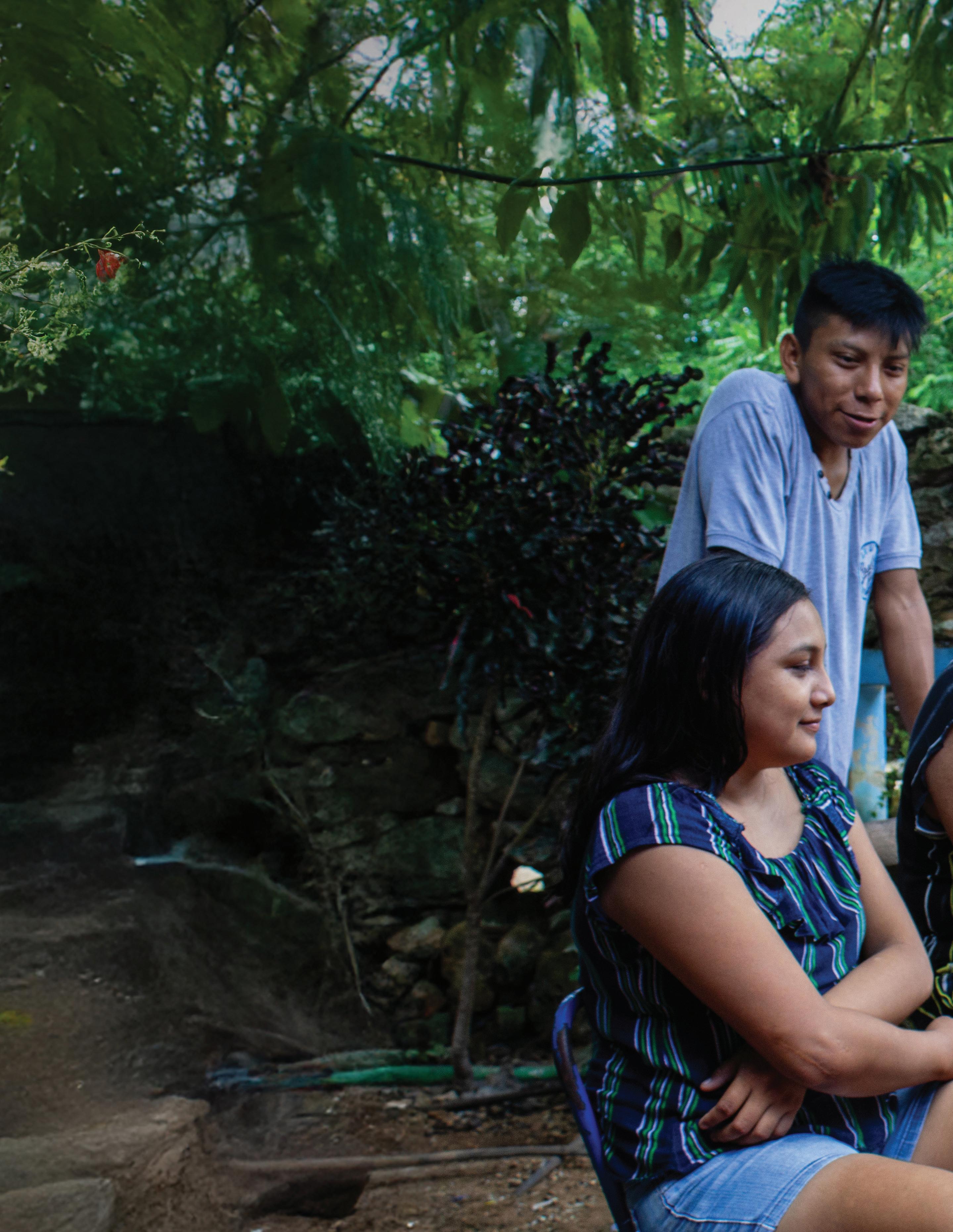
Education & Outreach
Development & Enhancement | Capacity Building | Local Leadership
At Turtle Survival Alliance, we recognize the power of education and outreach to drive conservation. With our partners, we engage communities through events, presentations, and hands-on interactions with turtles and tortoises. Through global projects, we inspire people of all ages by creating meaningful experiences that spark curiosity and foster a lifelong passion for wildlife. By sharing knowledge and building connections, we strengthen conservation efforts—because the future of turtles, and the wild places they inhabit, depends on it.
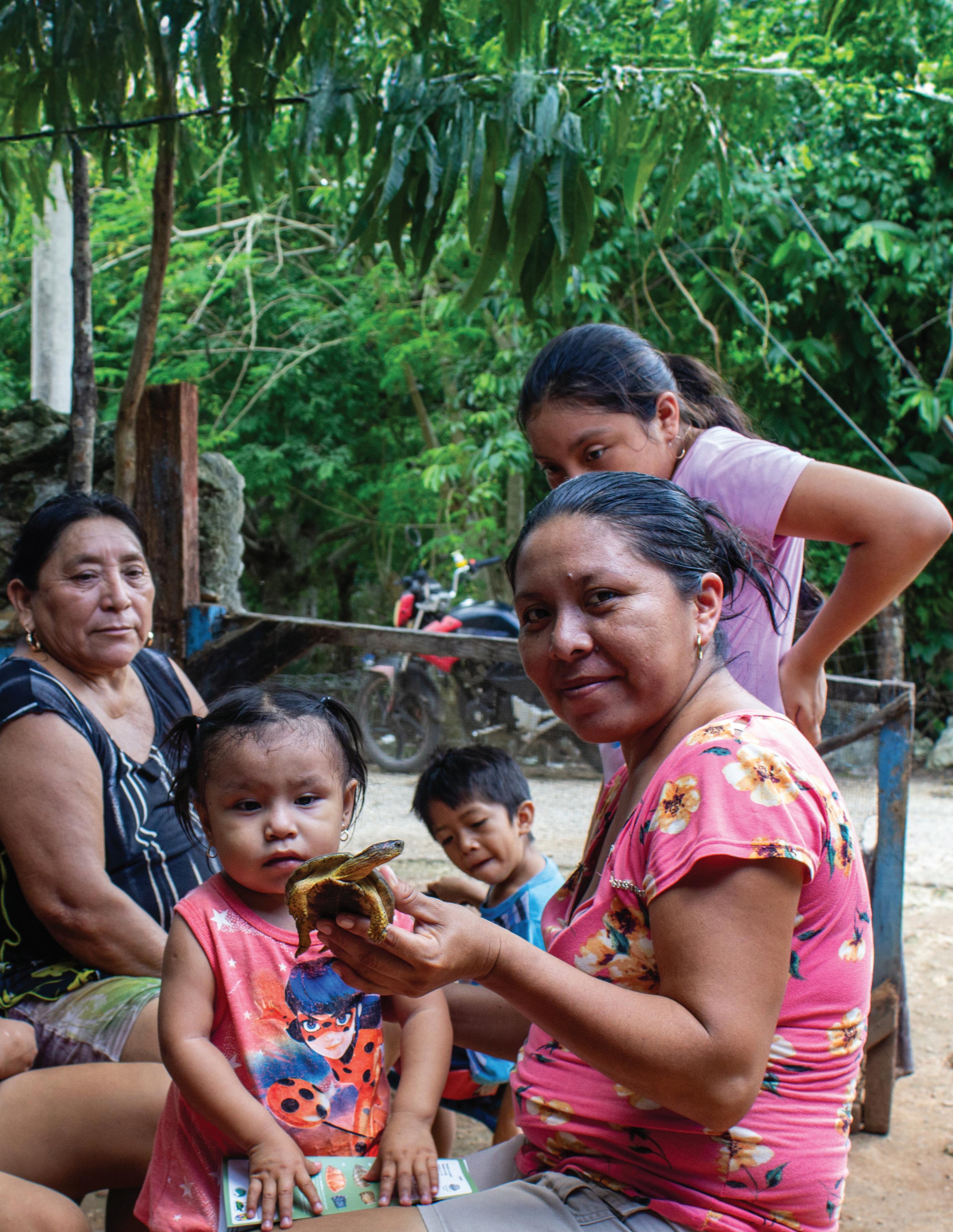
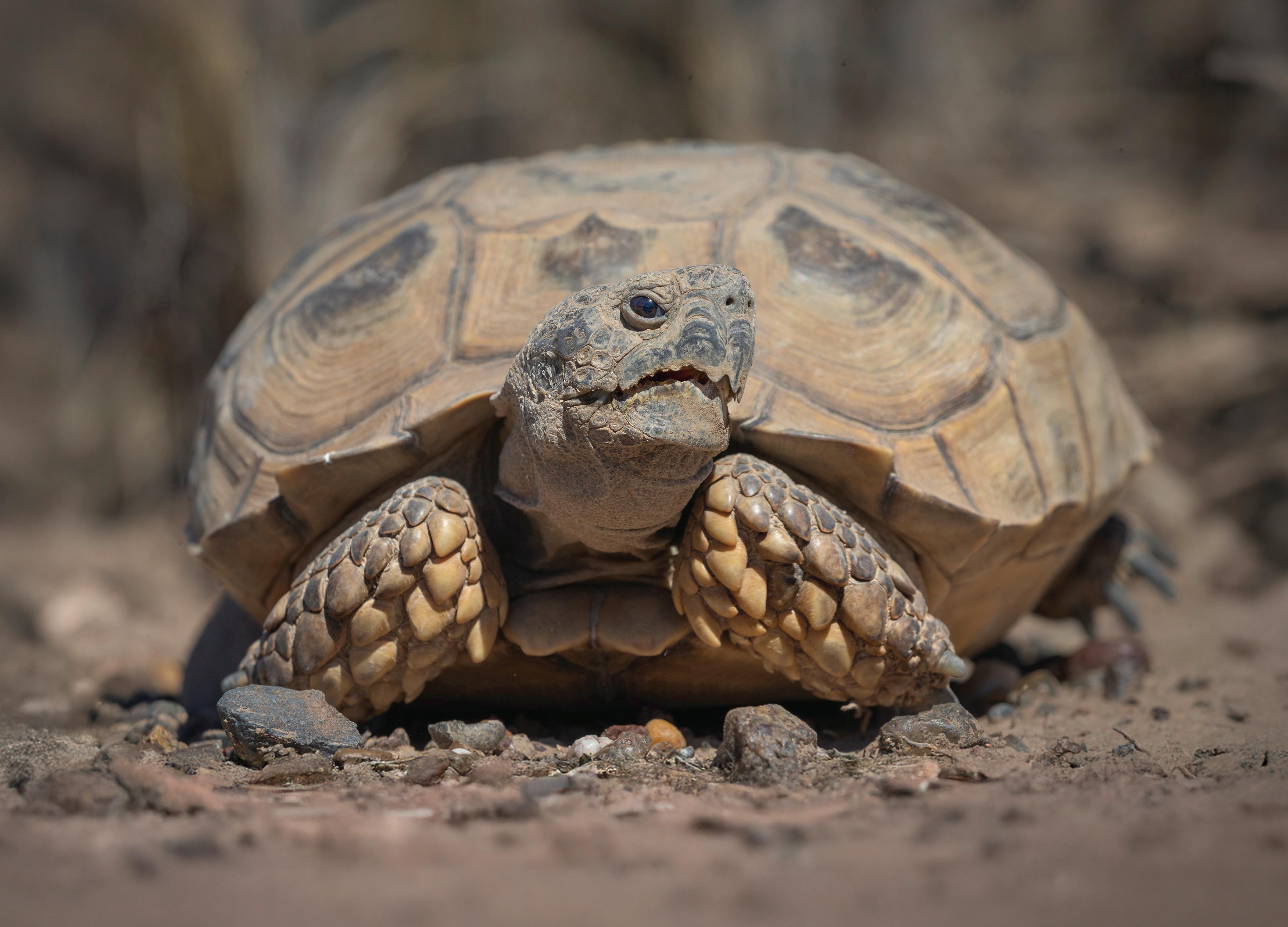
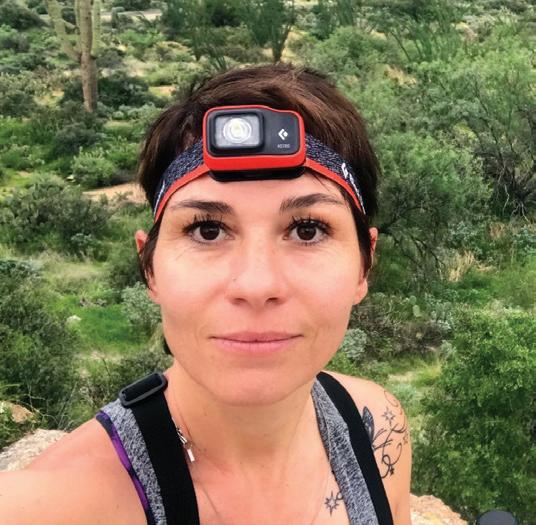
María Eugenia Echave
Ph.D. student, CNEA, CONICET-AZARA, Argentina
“Turtle Survival Alliance's support for my Ph.D. program has been essential in advancing research on the Chaco Tortoise, providing key resources to study the disturbances affecting its survival in Patagonia, Argentina. This support directly contributes to the species' conservation by enabling the development of effective strategies for its protection in its natural habitat.”
–María Eugenia Echave
Photo by Darío Podestá
Argentina
Turtle Survival Alliance values the role of supporting education and professional development to save species. We support researchers and graduate students around the world who make an impact in turtle conservation.
In Argentina, we are supporting María Eugenia Echave’s graduate research on the vulnerable Chaco Tortoise (Chelonoidis chilensis), where she studies the impact of environmental disturbances on the species' population viability. The
data she gathers provides insights into survival, mortality, and overall population health, which are vital for developing effective conservation strategies. Her research also identifies conservation challenges and recommends management measures to address them, while developing a standardized methodology for monitoring tortoise populations in natural habitats—ensuring continued protection for this unique species.
A Chaco Tortoise (Chelonoidis chilensis). Photo by Darío Podestá
Egypt
In 2024, Turtle Survival Alliance continued its support of Basem Motwaly, the manager of the Zaranik Protected Area in North Sinai, Egypt, in his study conducted in collaboration with the laboratory of Dr. Denise Thompson and Dr. Day Ligon at Missouri State University. His research focuses on studying the population dynamics and viability of the Egyptian Tortoise (Testudo kleinmanni) in the Sinai Peninsula. The goal is to enhance protection efforts for these populations using a communitydriven conservation approach. In 2024, Basem earned his Master’s degree, further strengthening his expertise in conservation science. In addition, he won the Best Student Presentation Award for Best Poster at the 22nd Annual Symposium on the Conservation and Biology of Tortoises and Freshwater Turtles (pictured).
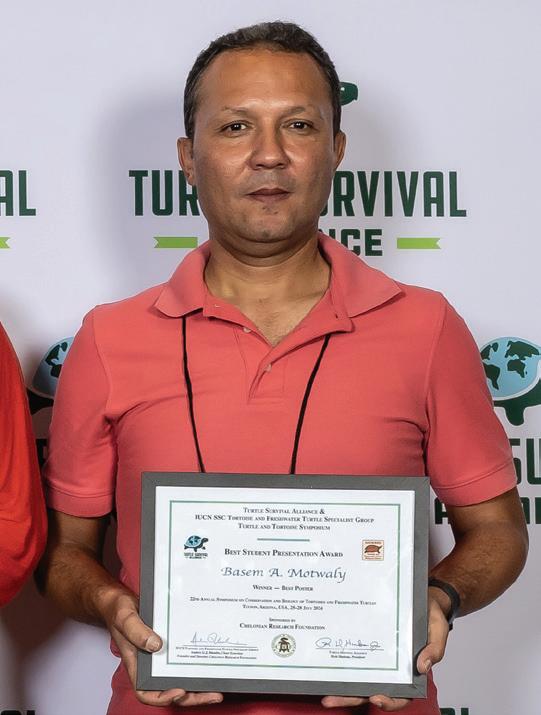
Basem Motwaly
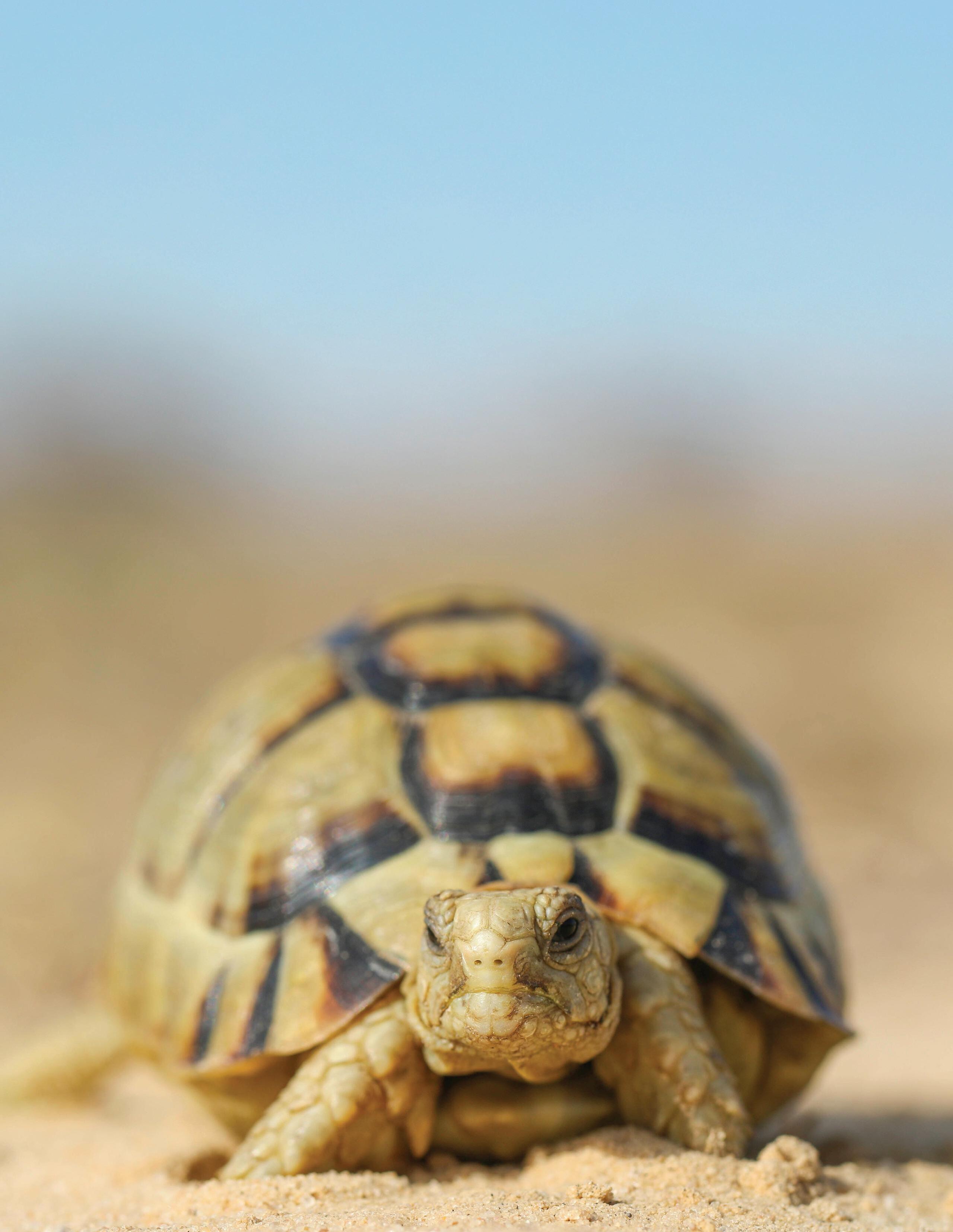
“The support from Turtle Survival Alliance was instrumental in advancing my Master's research, allowing me to generate critical data on the survival, recruitment, and productivity of the Egyptian Tortoise. This foundation is now guiding long-term conservation strategies for the species in its native range.” -Basem Motwaly
An Egyptian Tortoise (Testudo kleinmanni).
Photo by Basem Motwaly
Photo by Kathleen Dreir
Manager of the Zaranik Protected Area in North Sinai, Egypt
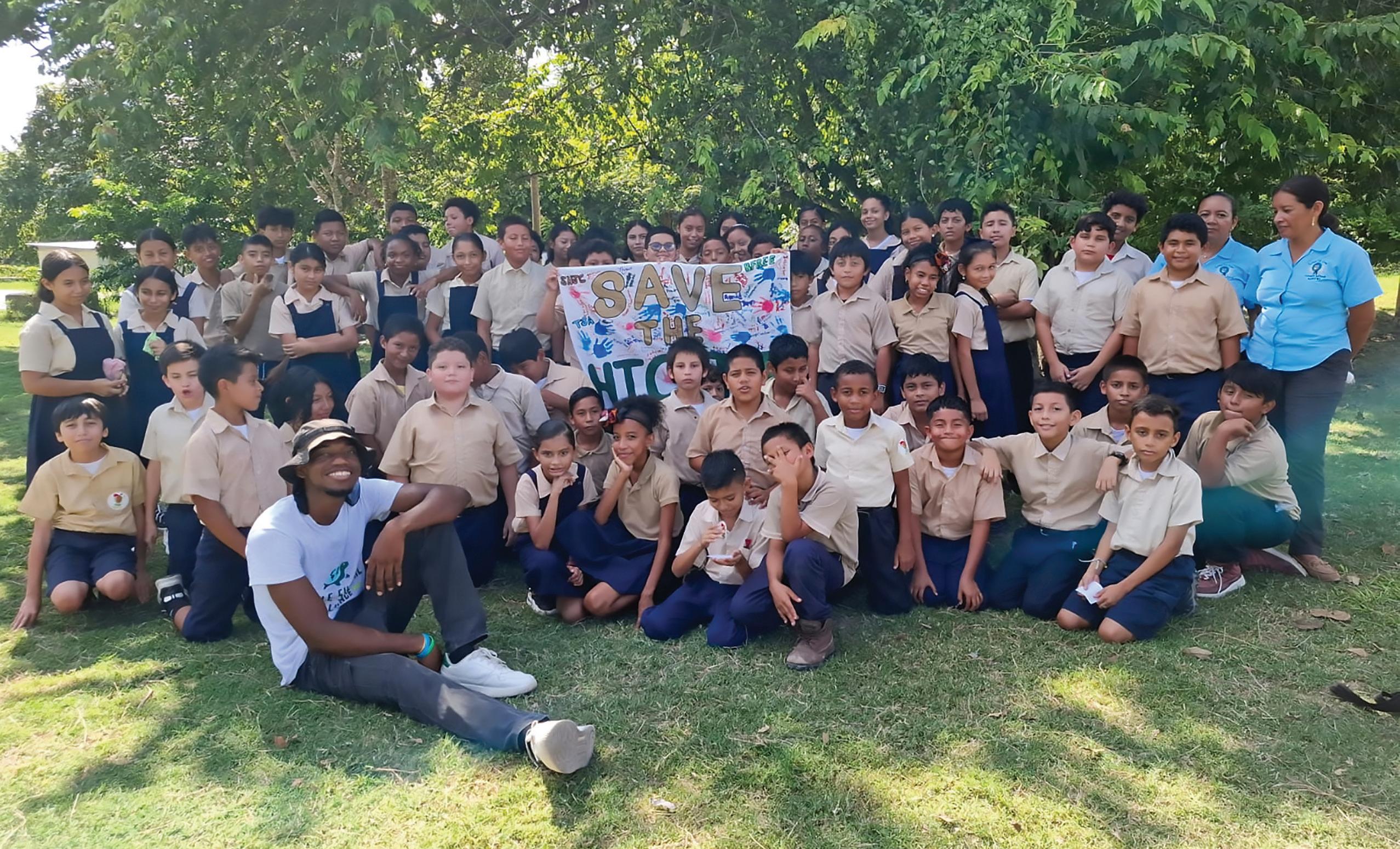
Belize
Every October, our partner in conservation, the Belize Foundation for Research and Education (BFREE), celebrates “Hicatee Month,” an annual opportunity to highlight the plight of the critically endangered Central American River Turtle (Dermatemys mawii), known in Belize as the “Hicatee.”
In 2024, BFREE presented on the importance of Hicatee Conservation to 19 schools, reaching over 600 students. These schools are in areas of Belize where Hicatee harvesting occurs, so educating and engaging local communities is key to improving the future of this species.
In partnership with Turtle Survival Alliance, BFREE highlighted a different turtle species found in Belize each week on social media and hosted webinars throughout the month. BFREE Science and Education Fellows Heston Castillo, Andrew Choco, and Samih Young, along with the Hicatee Awareness Month Planning Committee, selected the Hicatee Month theme, created materials, and delivered presentations to the students. Thanks to the dedication of these Fellows, the Planning Committee, and everyone at BFREE, turtle conservation education in Belize is reaching more students every year.
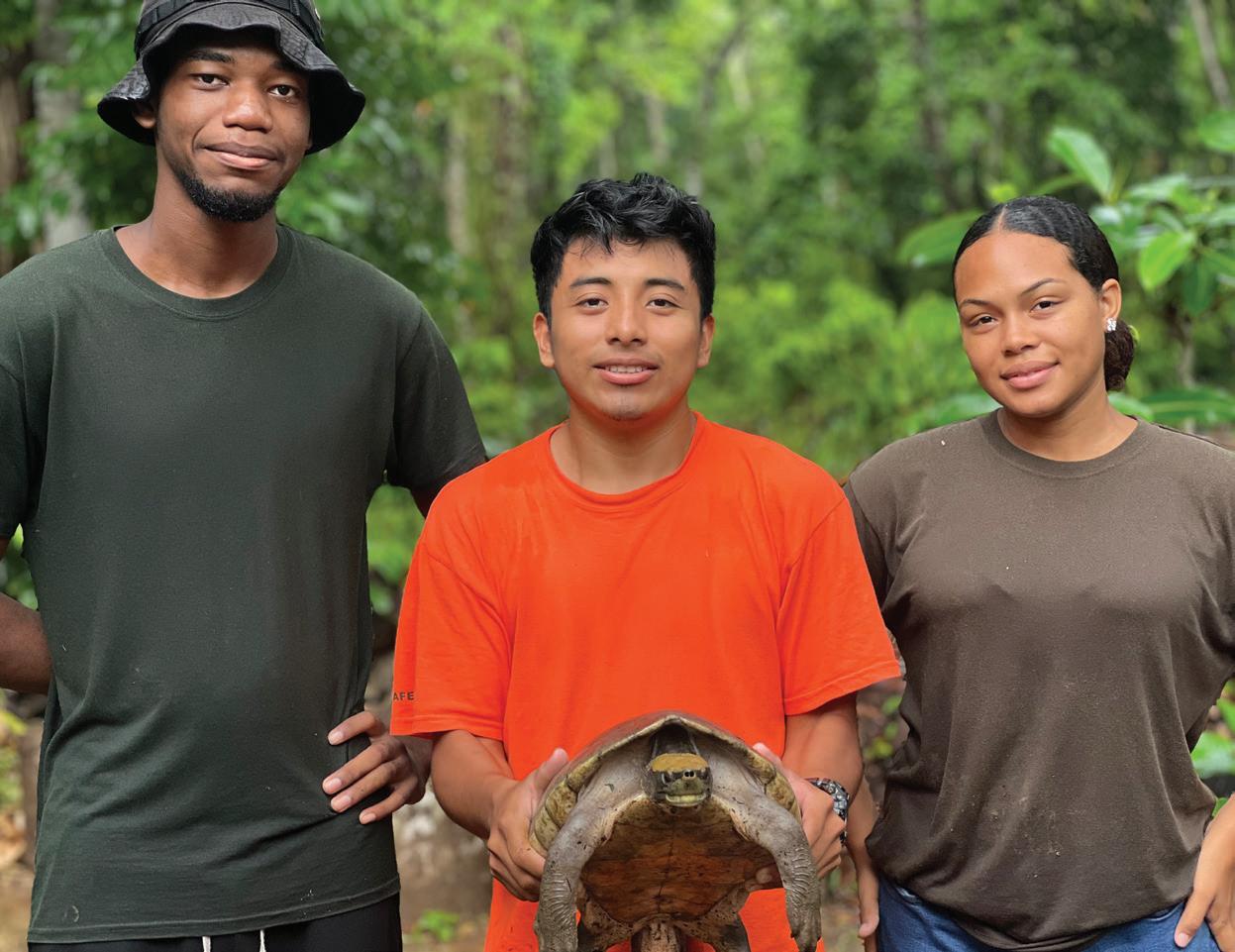
Belize Foundation for Research and Environmental Education (BFREE) Science and Education Fellow Heston Castillo celebrates Hicatee Awareness Month with a group of primary school students. Photo courtesy of Heston Castillo; BFREE Science and Education Fellows (left to right): Heston Castillo, Andrew Choco, and Samih Young. Andrew holds a Central American River Turtle (Dermatemys mawii), known locally as the “Hicatee.” Photo by Heather Barrett
600+
Students engaged during Hicatee Awareness Month
Malaysia
The Turtle Conservation Society of Malaysia (TCS), which is supported by Turtle Survival Alliance, launched the Turtles of Malaysia coloring book to raise awareness about freshwater turtles, often overshadowed by the country’s marine turtles. In 2024, TCS distributed more than 1,000 copies to schoolchildren in Terengganu through its Turtle Awareness Programs. The 44-page bilingual book,
co-authored by Loretta Ann Shepherd and illustrated by Yap Kim Ming, highlights 18 tortoise and freshwater turtle species, including critically endangered ones like the Southern River Terrapin (Batagur affinis). Through educational camps and fundraisers, TCS continues to spread knowledge, ensuring local communities recognize and protect Malaysia’s lesser-known yet imperiled turtles.
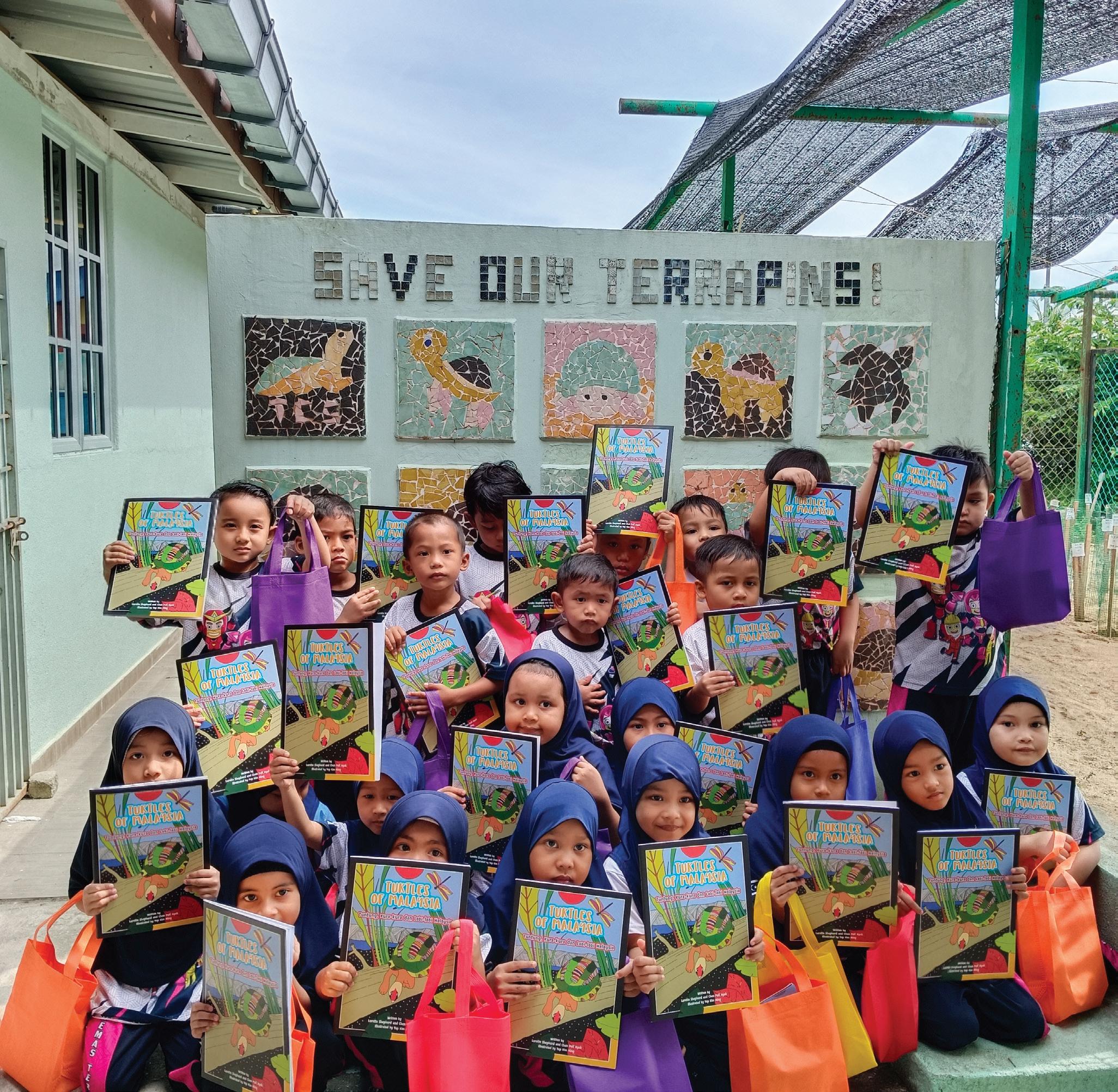
1,000+
Preschoolers from Tabika KEMAS Teladas proudly hold their copies of Turtles of Malaysia during their visit to the TCS in May.
Photo by Noor Syafina binti Azmin
Turtles of Malaysia coloring books distributed to children
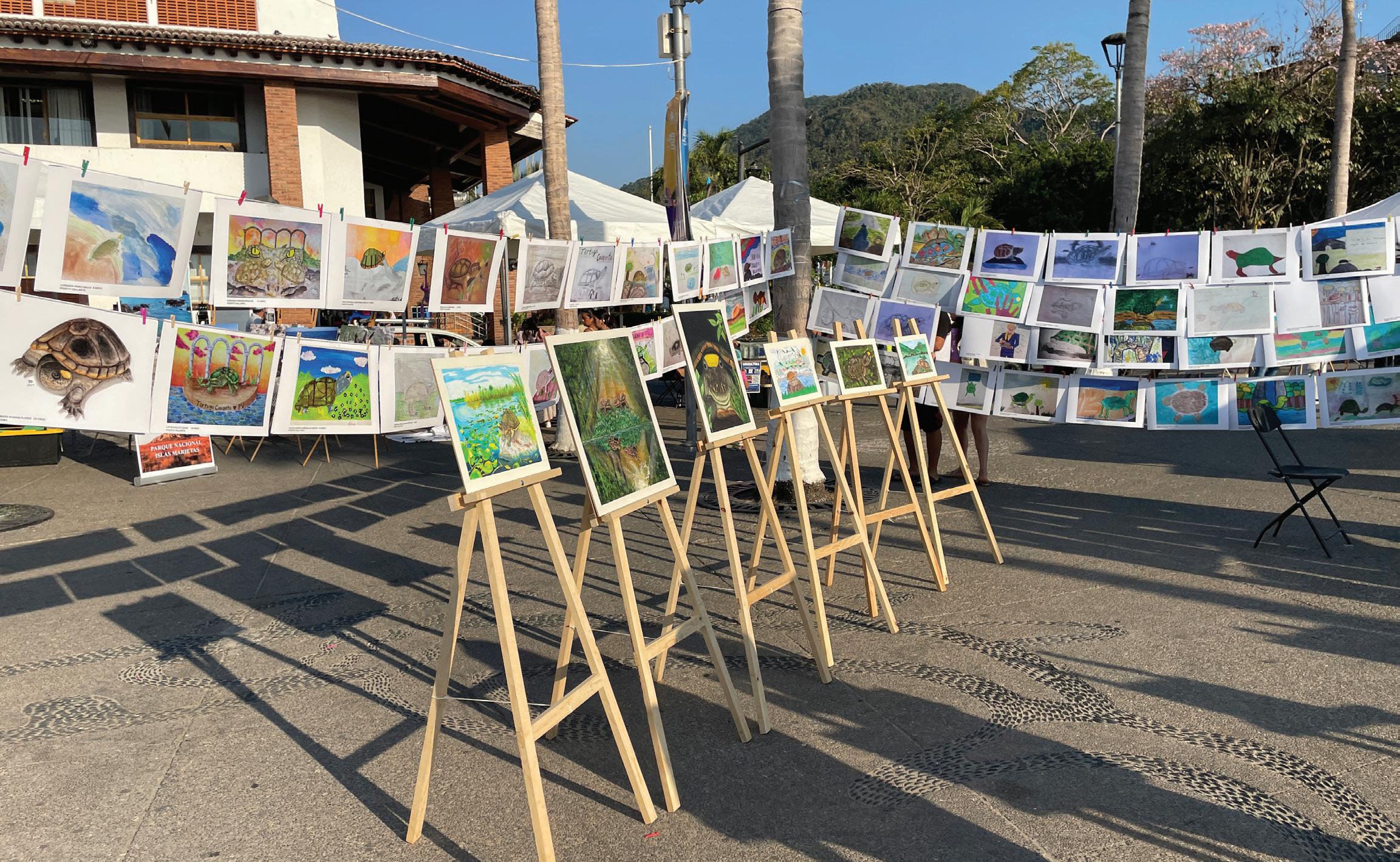
Mexico
Saving the world's smallest turtle from extinction requires a big effort. Our conservation partners, Students Conserving Nature (SCN), or Estudiantes Conservando la Naturaleza, A.C., are raising awareness about the critically endangered Vallarta Mud Turtle (Kinosternon vogti), which is endemic to the Puerto Vallarta region. As part of their efforts, they organized a citywide art contest, inviting local artists and students to depict this striking turtle. The contest received 200 art submissions, which were showcased during the 2024 World Turtle Day® celebration on the Puerto Vallarta Malecón. SCN also visits schools across Jalisco, including Puerto Vallarta, as well as in Sonora and Yucatán, educating students about the threats facing local turtle species and inspiring youth to take part in conservation efforts.
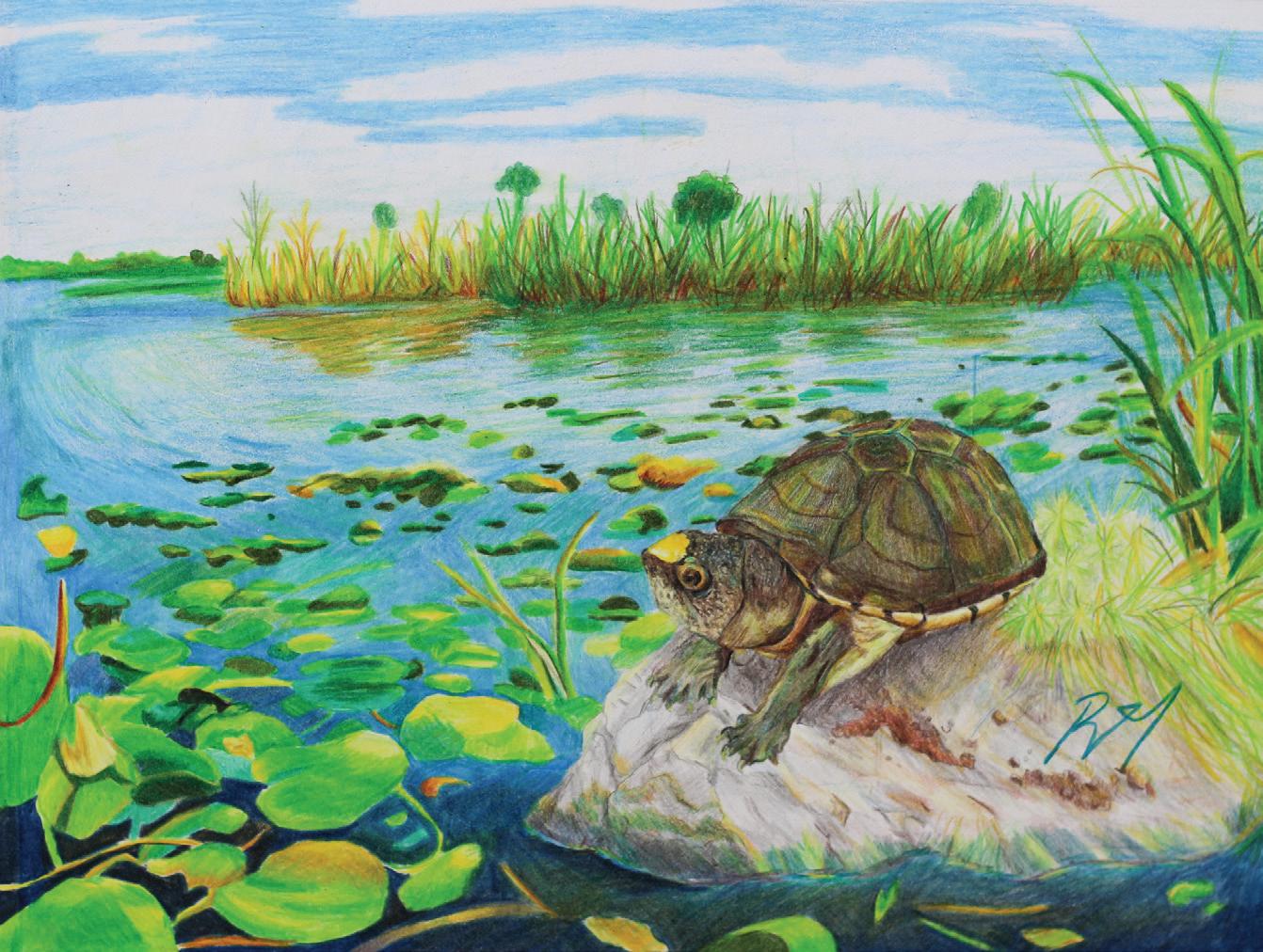
Clockwise from top left: Submissions by local artists depicting the Vallarta Mud Turtle (Kinosternon vogti), displayed during the World Turtle Day® celebration on the Puerto Vallarta Malecón. Photo by Alejandra Monsiváis; Elementary school students in Campeche, Mexico, learn about turtles native to the Yucatán Peninsula through a species pamphlet created by SCN. Photo by Alejandra Monsiváis; This pencil drawing of the critically endangered Vallarta Mud Turtle, created by Puerto Vallarta local Regina Perez, was one of the winning entries in the World Turtle Day® art contest.
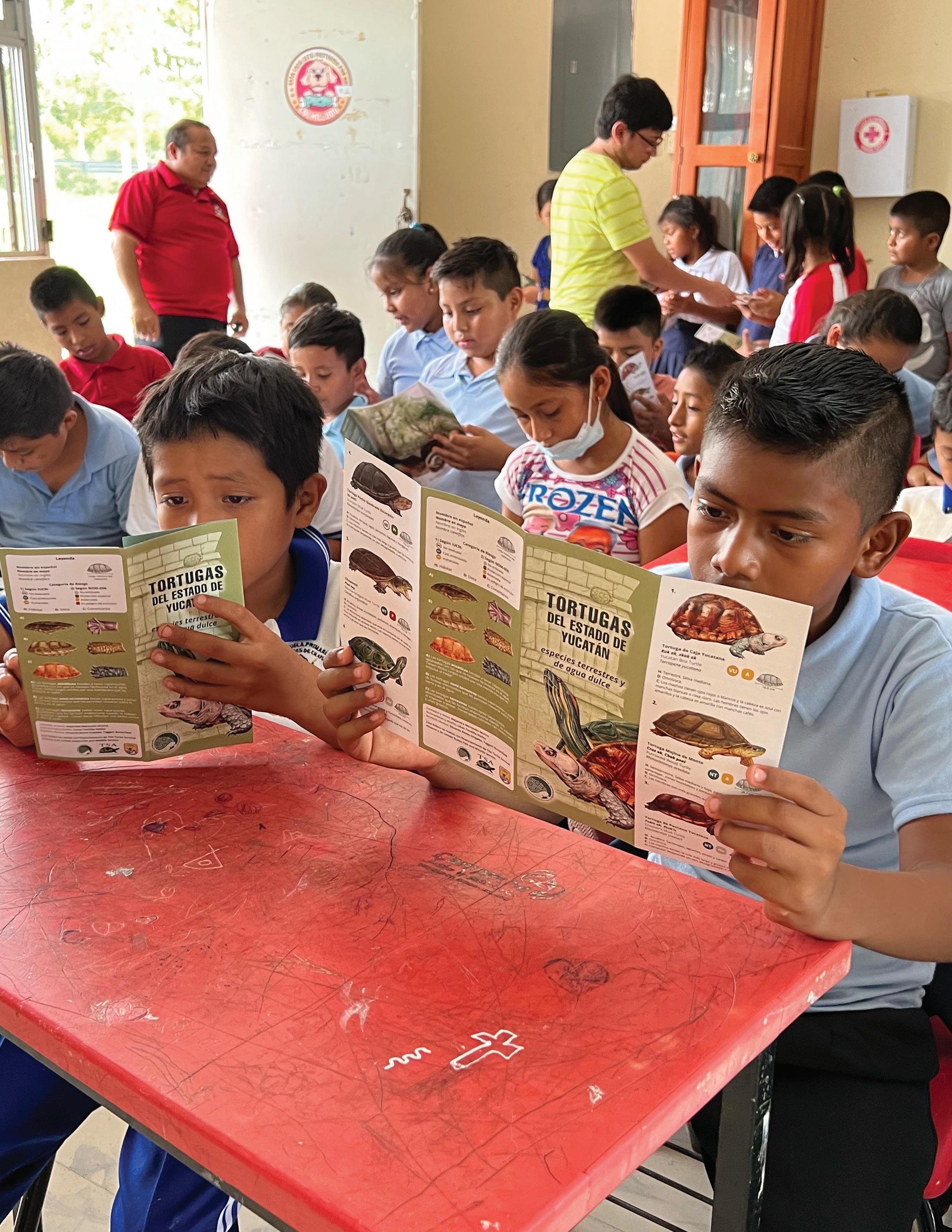
”Outreach plays a vital role in SCN’s mission to conserve turtles in Mexico. Whether it's through scholarships for young students, drawing contests, sticker campaigns, or school talks, we’re always finding new ways to bring turtles into the public conversation and inspire change.”
ALEJANDRA MONSIVÁIS, EXECUTIVE DIRECTOR OF STUDENTS CONSERVING NATURE
Thank You to Our Donors!
We acknowledge the following individuals and organizations who have donated to support Turtle Survival Alliance between January 1, 2024, to December 31, 2024.
$100,000+
Anonymous
Alan and Patricia Koval Foundation
Columbus Zoo and Aquarium
Gregory Family Charitable Fund
United States Agency for International Development
United States Fish and Wildlife Service
Wildlife Conservation Society
William H. Donner Foundation
$50,000 - $99,999
Dennler Family
Global Environment Facility
Morris Animal Foundation
$25,000 - $49,999
Aktionsgemeinschaft Artenschutz (AGA) e.V.
Marc Dupuis-Desormeaux and Susan Rimmer
Felburn Foundation
Mohamed bin Zayed (MBZ) Species Conservation Fund
Ocean Park Conservation Foundation
Saint Louis Zoo
Seacology
Tortuga Foundation
Zoo Knoxville
$10,000 - $24,999
Anonymous
Cheyenne Mountain Zoo
Cincinnati Zoo and Botanical Garden
Detroit Zoo
Ed Neil
Fonseca Species Conservation Fund
Greenville Zoo (City of Greenville)
Judith Howells
David A. Hutchison
IguanaLand
Dr. John Iverson
Michael Kilham
Sandra J. Moss
Nashville Zoo at Grassmere
Oklahoma City Zoo & Botanical Garden
Stuart and Patricia Salenger Foundation
TC Energy Foundation
Virginia Zoo in Norfolk
Zoofari Parks, LLC
$5,000 - $9,999
Deborah Behler
Birmingham Zoo
Cleveland Metroparks Zoo
Jackie Cogswell
Fort Wayne Children's Zoo
Fort Worth Zoo
William and Kathleen Holmstrom
Riverbanks Zoo & Garden
Saginaw Children's Zoo
Ben Samann
Roger Schat
Sedgwick County Zoo
The Daniel & Nicole Voss Charitable Fund
Turtle Taxonomy Fund
Wildlife World Zoo and Aquarium
Zoological Association of America
$1,000 - $4,999
Alberts Family Charitable Fund
Andrew Sabin Family Foundation
Aquazoo Löbbecke Museum
Barbara Brewster Bonner Charitable Fund
Baton Rouge Zoo
Berkeley Electric Trust
Blank Park Zoo
Robin de Bled
Brookfield Zoo Chicago Zoological Society
Lora Butterfield
Taggert Butterfield
Cameron Park Zoological & Botanical Society
Canteen, LLC
Catoctin Wildlife Preserve
Chelonian Research Foundation
Karrie Chen and Thomas Jacoby
Chicago Zoological Society (Brookfield Zoo)
Columbus AAZK Chapter
Dennis Coules
Christine Crocker
Crowder-Messersmith Fund (Nature Forward)
Joshua Dale and Ilana Miller
Dallas World Aquarium
Dallas Zoo
Robert Davey
David Crews and Andrea Gore Charitable Fund
Desert Tortoise Council, Inc.
Detroit AAZK Chapter
Ryan Dew
Julian Duval
Tatyana Elefante
Elizabeth C. Bonner Foundation
Robin Elliott
Johannes Els
Flying Lion Brewing
Curt L. Fuhrmann
Fundacja ZOO Wrocław DODO
Gail Gazda
Janis Gerrits
Whit Gibbons
Margery "Spike" Gram
Naomi Grant
Katie Gregory
Michael Hasselbring
Norbu He
Holohil Systems Ltd
James and Karen Frisell Family Foundation
Jan and Jack Cato Family Fund
Denise John
Dr. Lisa Kole
Krause Family Charitable Foundation (J.P.Morgan CGF)
Dr. Paul Licht
Jackie Lindner
Ingrid and Anthony Lombardino
Luther King Capital Management
Jeff Mace
Julia Maitre
Maryland Zoo
Mazuri Exotic Animal Nutrition
Tom Motlow
Norristown Zoological Society DBA Elmwood Park Zoo
Lynn Patterson
Daniel Pearson
Phoenix Zoo (Arizona Center for Nature Conservation)
Kathryn Pickett
Aleta Quinn
Re:wild
Dr. Anders Rhodin
Frank and Kate Slavens
Sonotronics
South Carolina Stingrays
Southern Packaging, Inc., Bradley R. Tuminello
Brett Stearns
Michael Stepniewski
SWCA Environmental Consultants
The Arne Lillehamer Foundation
The Buffalo Zoo
The Garcia Family Charitable Fund
The Merck Foundation
The Schechter Foundation
Tracks Software
Tucson Herpetological Society
Turtle Conservancy
Turtle Conservation Fund
Virginia Aquarium & Marine Science Center
Mrs. Susanne and Dr. Harold Wahlquist
Andrew & Angela Walde
Elizabeth Walley
Bruce Weber
Bruce Weissgold
Whitney Green
Staten Island Zoo AAZK Chapter
Diane Yoshimi
Zoo Tampa at Lowry Park
IN-KIND*
Belize Foundation for Research & Environmental Education (BFREE)
Black River Cypress Preserve
Brett Bartek
Marc Dupuis-Desormeaux
Patricia Koval
Limehouse Produce
Loews Ventana Canyon Resort
Mazuri Exotic Animal Nutrition
Mississippi Aquarium
Lance Paden
Bonnie Raphael
Oatland Island Wildlife Center
SWCA Environmental Consultants
TracksData Solutions
Visit Tucson
Wildlife Conservation Society/Bronx Zoo
Zoo Med Laboratories, Inc.
*Value of $1,000 or more
Zoo and Aquarium Partners
Turtle Survival Alliance proudly acknowledges the following zoos, aquariums, and affiliate organizations that make our work possible. The following have given $5,000+ cumulatively (including in-kind) over the last three years.
Baton Rouge Zoo
Birmingham Zoo
Cheyenne Mountain Zoo
Cincinnati Zoo and Botanical Garden
Cleveland Metroparks Zoo
Columbus AAZK Chapter
Columbus Zoo and Aquarium
Dallas Zoo
Detroit Zoo
Disney's Animal Kingdom
Fort Wayne Zoo
Fort Worth Zoo
Fundacja Zoo Wrocław DODO
Greenville Zoo
IguanaLand
Indianapolis Zoo
Jacksonville Zoo and Gardens
Little Rock Zoo
Maryland Zoo
Milwaukee County Zoo
Mississippi Aquarium
Nashville Zoo at Grassmere
Oklahoma City Zoo & Botanical Garden
Riverbanks Zoo & Garden
Saginaw Children's Zoo
Saint Louis Zoo
San Diego Zoo Wildlife Alliance
Santa Fe College Teaching Zoo
Sedgwick County Zoo
Tennessee Aquarium
Topeka Zoo & Conservation Center
Toronto Zoo
Turtle Back Zoo (Zoological Society of New Jersey)
Virginia Aquarium & Marine Science Center
Virginia Safari Park (Zoofari Parks, LLC)
Virginia Zoo in Norfolk
Wildlife Conservation Society/Bronx Zoo
Wildlife World Zoo and Aquarium
Zoo Atlanta
Zoo Knoxville
Range Country Partners
Turtle Survival Alliance proudly acknowledges the following institutions, organizations, and agencies with whom we collaborate for our global programs, projects, and partnerships.
ARGENTINA
Consejo Nacional de Investigaciones Científicas y Técnicas (CONICET)
Comisión Nacional de Energía Atómica (CNEA)
Fundación de Historia Natural Félix de Azara (AZARA)
Instituto de Investigaciones en Biodiversidad y Medioambiente (INIBIOMA)
BANGLADESH
Creative Conservation Alliance
BELIZE
Belize Foundation for Research & Environmental Education (BFREE)
Savanna Field Station
Wildlife Conservation Society Belize
BOLIVIA
Wildlife Conservation Society Bolivia
BRAZIL
O Centro de Referência em Educação Ambiental e Desenvolvimento Sustentável José do Carmo Neves (CREADS)
CAMBODIA
Angkor Center for Conservation of Biodiversity
Wildlife Conservation Society Cambodia
COLOMBIA
Wildlife Conservation Society Colombia
EGYPT
Egyptian Ministry of Environment (Zaranik Protected Area)
Missouri State University
GUATEMALA
Philadelphia Zoo
INDONESIA
Satucita Foundation
KENYA
Lewa Wildlife Conservancy
National Museums of Kenya
Kenya Wildlife Service
MADAGASCAR
Madagascar National Parks
Ministère de l’Environnement et du Développement Durable
MALAYSIA
Turtle Conservation Society of Malaysia
PULIHARA
MEXICO
El Colegio de la Frontera Sur Estudiantes Conservando la Naturaleza, A.C. Guadalajara Zoo
MYANMAR
Myanmar Biodiversity Fund
SOUTH SUDAN/UGANDA
Institute for Development Ecology Conservation and Cooperation
University of Juba
UNITED STATES
Association of Zoos & Aquariums
Houston Parks and Recreation Department
Florida Fish and Wildlife Conservation Commission
Florida Department of Environmental Protection
Friends of Talbot Island State Parks
Jacksonville University
Jacksonville Zoo and Gardens
Memorial Park Conservancy
New Jersey Department of Environmental Protection
Orange County Parks and Recreation
Puget Sound Energy
SWCA Environmental Consultants
Texas Parks & Wildlife Department
United States Fish & Wildlife Service
Wekiva Island
Wekiva River Aquatic Preserve
Wekiva Wild and Scenic River System
2024 Event Partners
Turtle Survival Alliance proudly acknowledges the following businesses, organizations, and groups that hosted and supported Drink Beer. Save Turtles.® events in 2024..
Alpha Brewing Company
Bold City Brewing
Bookshop West Portal
Boomers Roadhouse
Burnish Beer Co.
Canteen Brewhouse
Chesapeake AAZK Chapter
Chuck’s Hop Shop
Cold Blooded Caffeine
Columbus AAZK Chapter
Flying Lion Brewing
Flyway Brewing
Forward Brewing
Friends of the Sevilleta
Holy City Brewing
Jacksonville AAZK Chapter
Kairoa Brewing
Kills Boro Brewing
Little Rock Zoo
Nocterra Brewing Company
St. Louis AAZK Chapter
New Mexico Herpetelogical Society
Staten Island Zoo AAZK Chapter
Three Canyon Beer & Wine Garden
Tucson Herpetological Society
Two Blokes Brewing
Yeungling
Supporter Spotlights
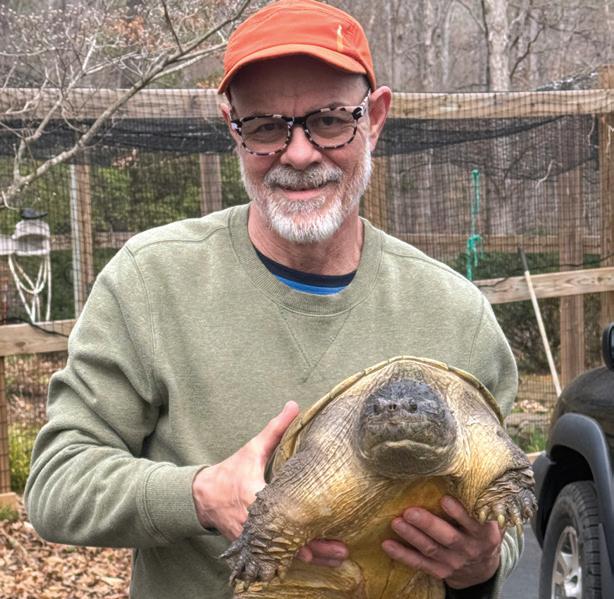
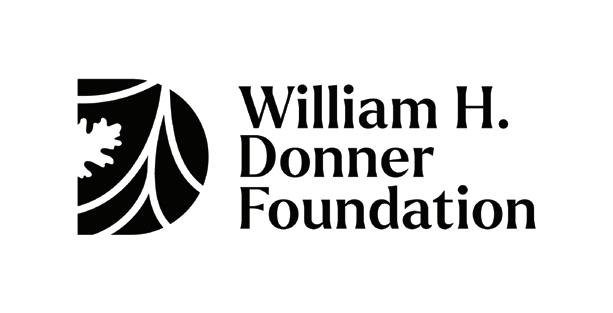

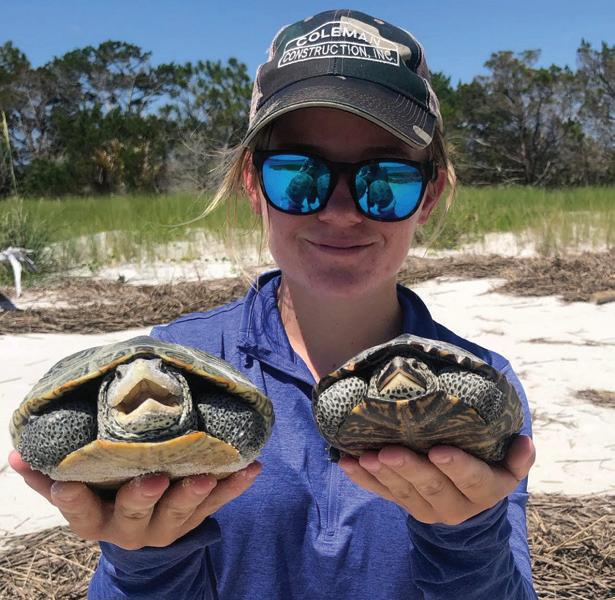
DONOR SPOTLIGHT
Ed Neil
“I give to the Turtle Survival Alliance because the people I’ve met over the years are truly committed to protecting and restoring wild populations of turtles and tortoises. Putting resources in their capable hands is our best chance at ensuring that these amazing creatures will be around for future generations.”
FOUNDATION SPOTLIGHT
William H. Donner Foundation
Support from foundations like the William H. Donner Foundation is essential to the survival of some of the world’s most endangered turtles. Their generosity fuels efforts at the Turtle Survival Center, breeding hope for critically endangered species. It enables our on-the-ground conservation work in Madagascar and Mexico, protecting turtle populations endemic to those regions and their habitats. Their investment reflects a deep trust in Turtle Survival Alliance as the global leader in turtle conservation, ensuring that our expertise continues to drive meaningful, lasting impact for turtles worldwide.
PARTNER SPOTLIGHT
Columbus Zoo and Aquarium
With wild Radiated Tortoise populations hanging by a thread due to widespread poaching, the role of local communities in their protection is critical—the battle to save this species will be won or lost at the community level. With support from the Columbus Zoo and Aquarium we’re expanding our Community Outreach Center in Southern Madagascar into a regional hub for training, education, and sustainable tourism. This long-term initiative will serve as a model for the Androy region, empowering communities while driving sustainable visitation to Cap St. Marie Special Reserve—home to the most important Radiated Tortoise population.
SPOTLIGHT
"Joining Team Terrapin is undoubtedly the best opportunity I've had to blend my passion for animals and science with meaningful action. We are truly making a difference by coming together as a community to protect these turtles."
-Madeline Williams, Volunteer, Team Terrapin
VOLUNTEER
Madeline Williams
ZOO
A Bog Turtle (Glyptemys muhlenbergii) fitted with a radio transmitter at one of our field project sites in New Jersey, USA, in May 2024. In collaboration with the New Jersey Department of Environmental Protection, this project gathers vital data on turtle locations, ecology, and life history. Photo by Eric Munscher
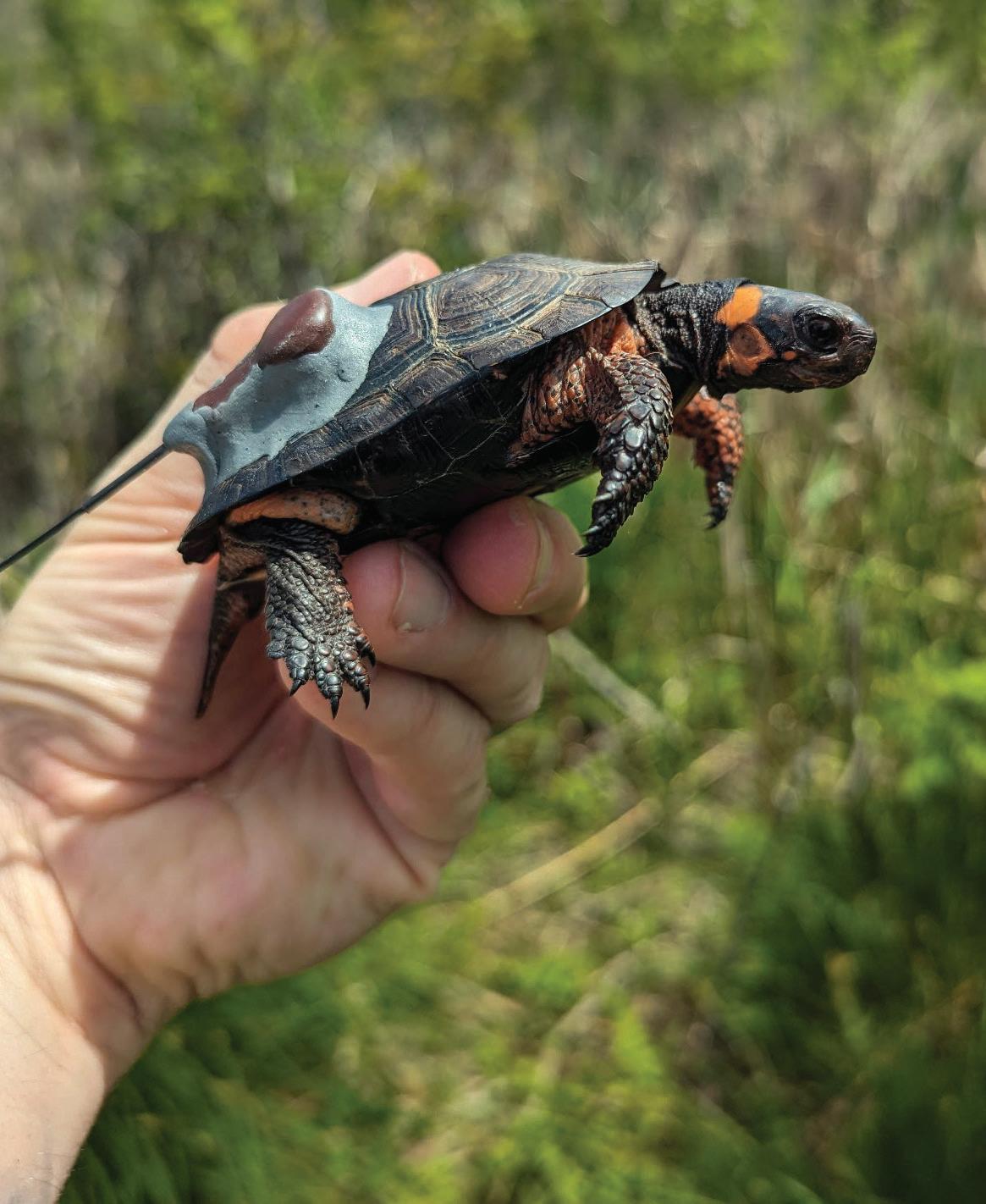
CONTRIBUTORS
Rajo Andrianaivojaona (Turtle Survival Alliance), Marjorie Pinzon Arias (Wildlife Conservation Society), Juan Baldovinos (Collaborator, Chiapas, Mexico), Heather Barrett (Belize Foundation for Research and Environmental Education), Brett Bartek (NV5/Turtle Survival Alliance), Taggert Butterfield (Estudiantes Conservando la Naturaleza, A.C.), Pelf-Nyok Chen (Turtle Conservation Society of Malaysia), David Collins (Turtle Survival Alliance), Chris Daughtry (Volunteer Science/Symrise), Clinton Doak (Turtle Survival Alliance), Marc Dupuis-Desormeaux (Turtle Survival Alliance), Elena Duran (Turtle Survival Alliance), María Eugenia Echave (CNEA, CONICET-AZARA, Argentina), Andry Fandresena (Turtle Survival Alliance), Germán Forero Medina (Wildlife Conservation Society), Natalia Gallego-García (Turtle Survival Alliance), Chanti Gnourn (Wildlife Conservation Society), Eduardo Reyes Grajales (El Colegio de la Frontera Sur), Jordan Gray (Turtle Survival Alliance), Christel Griffioen (Angkor Center for Conservation of Biodiversity), Cris Hagen (Turtle Survival Alliance), Tabitha Hootman (Jacksonville University/Turtle Survival Alliance), Erika Kubisch (INIBIOMA, UncoMA – CONICET, Argentina), Heather Lambert (Turtle Survival Alliance), Ratri Lertluksamipun (Turtle Survival Alliance), Hery Lova Razafimamonjiraibe (Turtle Survival Alliance), Aminah Madi (Turtle Conservation Society of Malaysia), Dominic Maringa (Lewa Wildlife Conservancy), Alejandra Monsiváis (Estudiantes Conservando la Naturaleza, A.C.), Basem Motwaly (Missouri State University/Zaranik Protected Area), Eric Munscher (SWCA Environmental Consultants/Turtle Survival Alliance), Yuli Doria Negrette (Tortugas del Sinú), Ed Neil (Supporter), Samantha Nottingham (Turtle Survival Alliance), Wayne Osborne (Pine Ridge High School/Turtle Survival Alliance), Makalya Peppin-Sherwood (Turtle Survival Alliance), Joe Pignatelli (Puget Sound Energy/Turtle Survival Alliance), Steven Platt (Wildlife Conservation Society), Kalyar Platt (Turtle Survival Alliance), Shahriar Caesar Rahman (Creative Conservation Alliance), Tsanta Fiderana Rakotonanahary (Turtle Survival Alliance), Chelsea Rinn (Turtle Survival Alliance), Sitha Som (Wildlife Conservation Society), Jaren Serano (Belize Foundation for Research and Environmental Education), Phun Thorn (Wildlife Conservation Society), Igor Valencia (Wildlife Conservation Society), Jhonattan Vanegas (Wildlife Conservation Society), Andrew Walde (Turtle Survival Alliance), Madeline Williams (Team Terrapin/Amelia Adventures), Fahim Zaman (Creative Conservation Alliance)
A juvenile Central American River Turtle (Dermatemys mawii) at the Hicatee Conservation & Research Center in Belize.
Photo by Heather Barrett
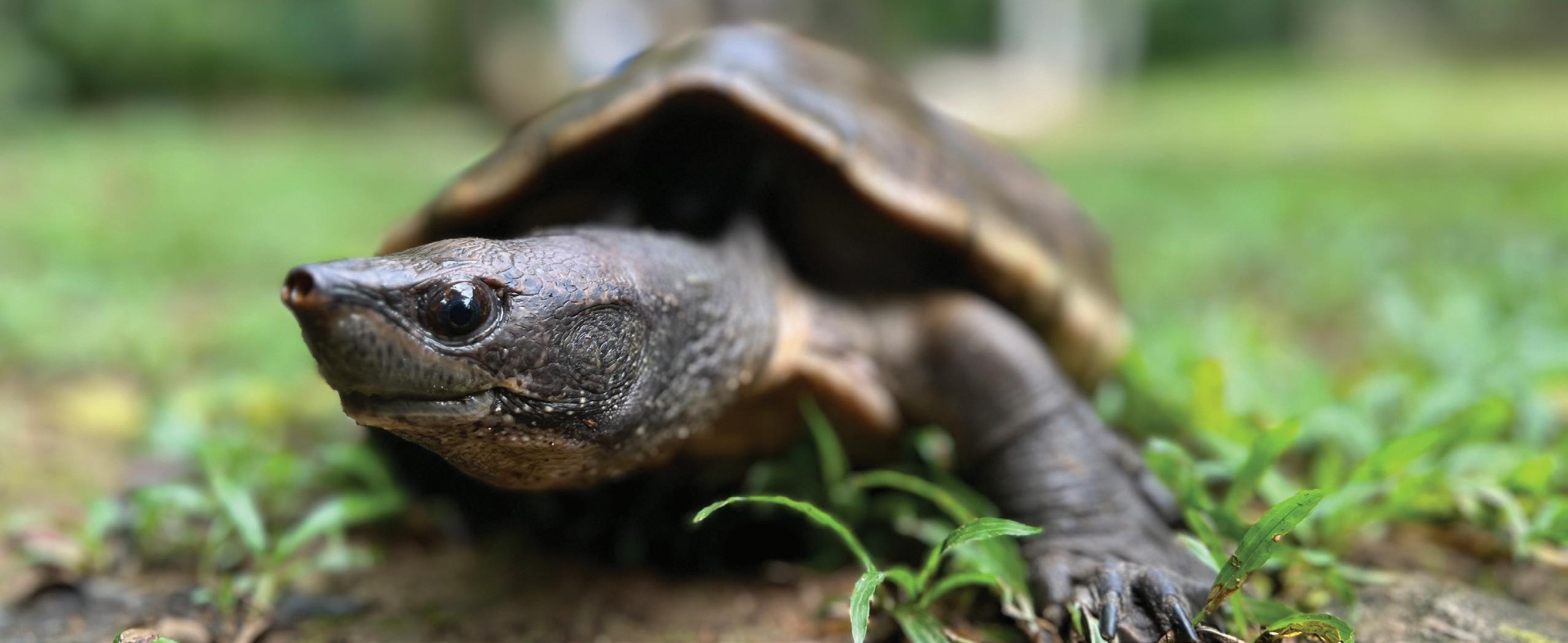
Financial Summary
Total Expenses ($4.35 Million)
Change in Net Assets ($312,638) Beginning $ 16,811,188 Ending $ 16,498,550
*A portion of TSA’s board-designated Stewardship Fund is allocated annually to support strategic priorities and cover staff costs, ensuring that a majority of personnel expenses are supported by sustainable, long-term revenue.
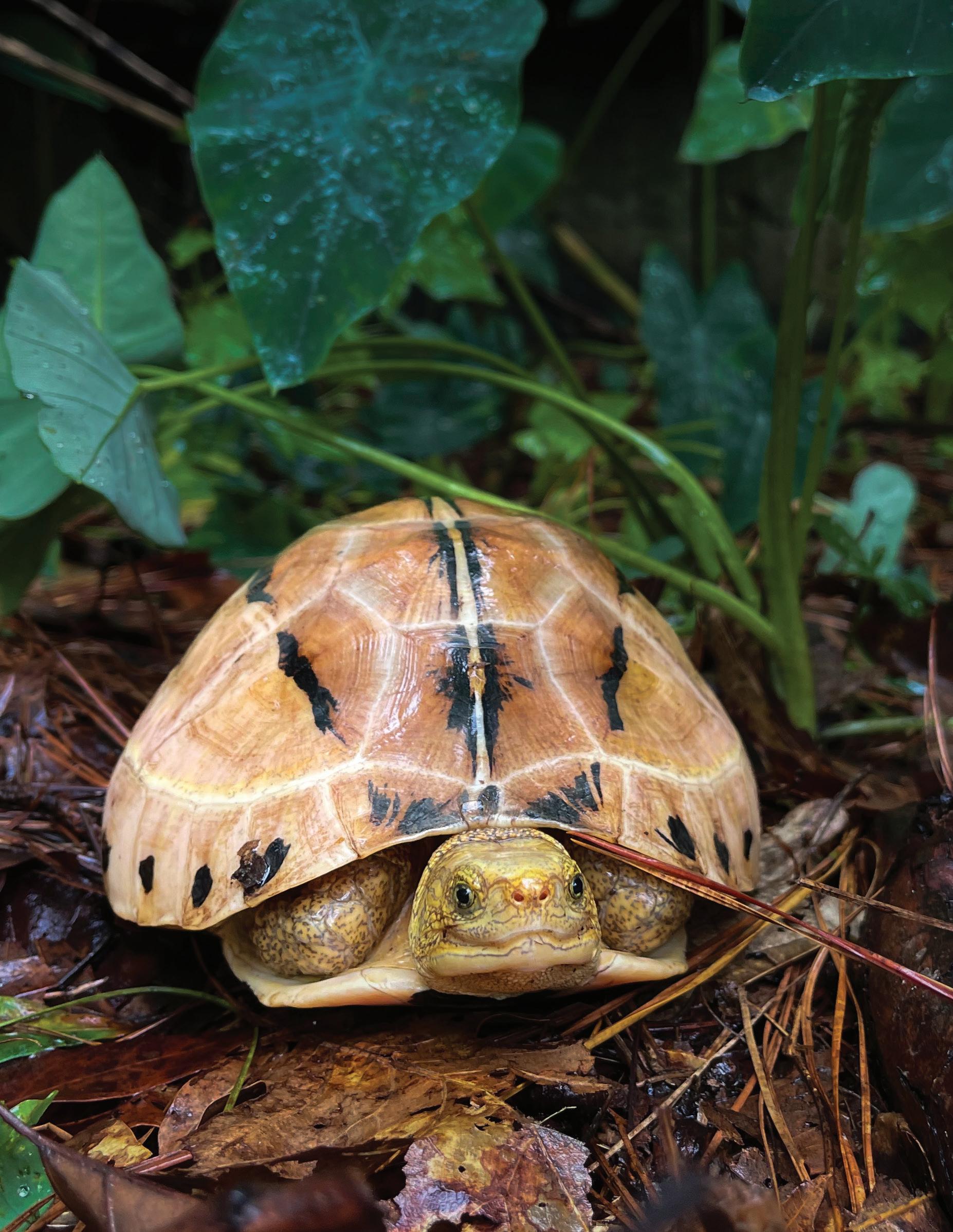
A Brighter Future for Turtles Starts With
A Southern Vietnam Box Turtle (Cuora picturata) at the Turtle Survival Center.
Photo by Rachael Harff
